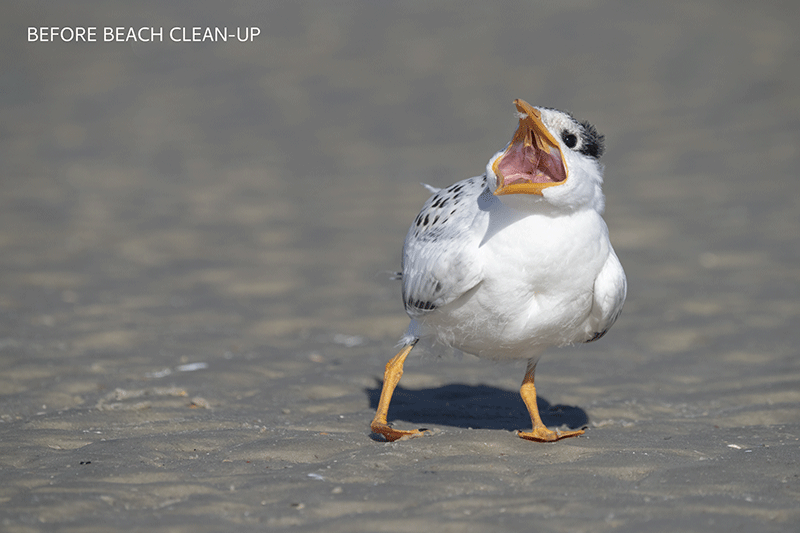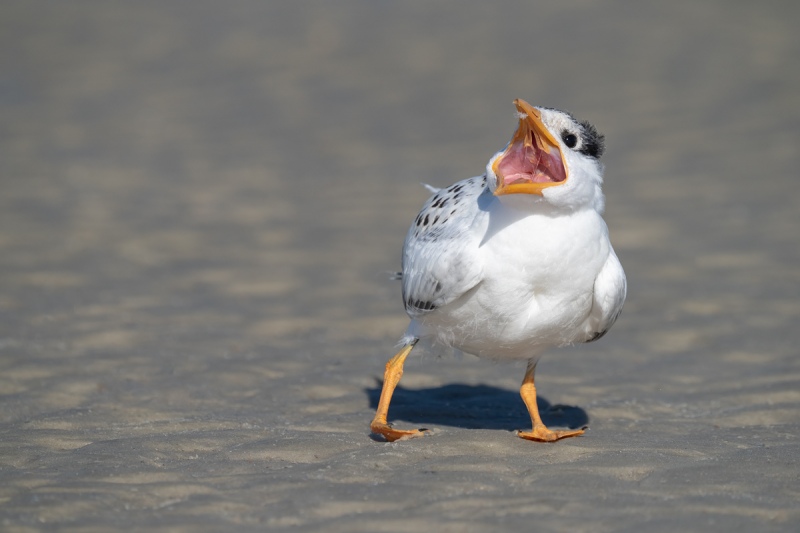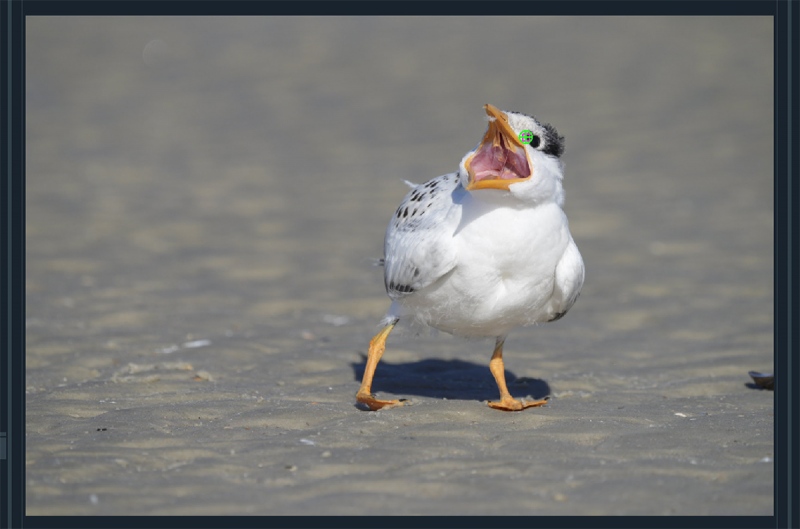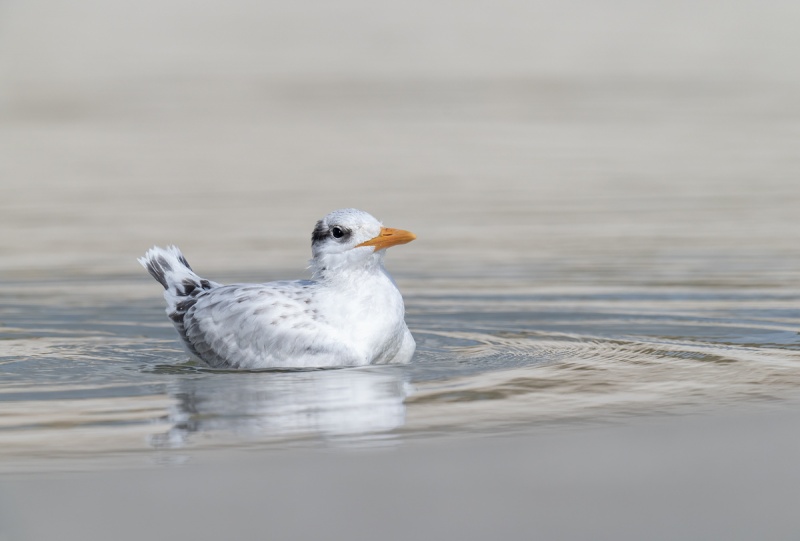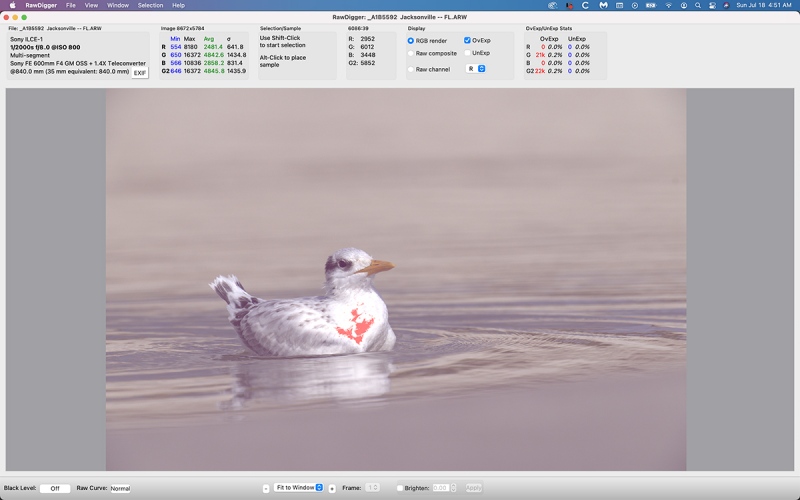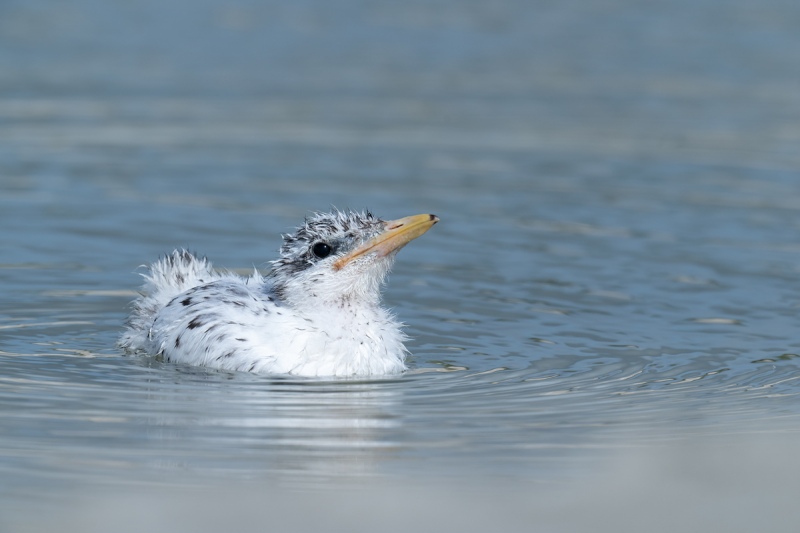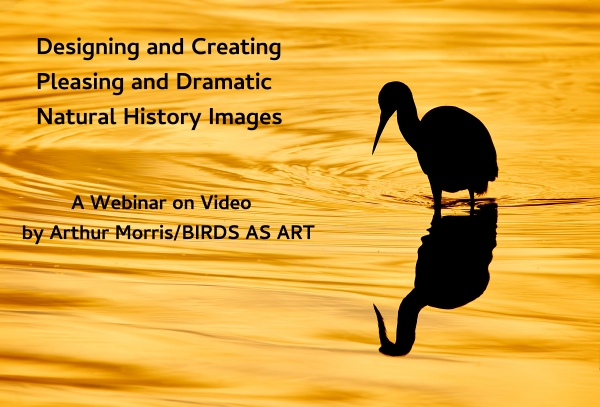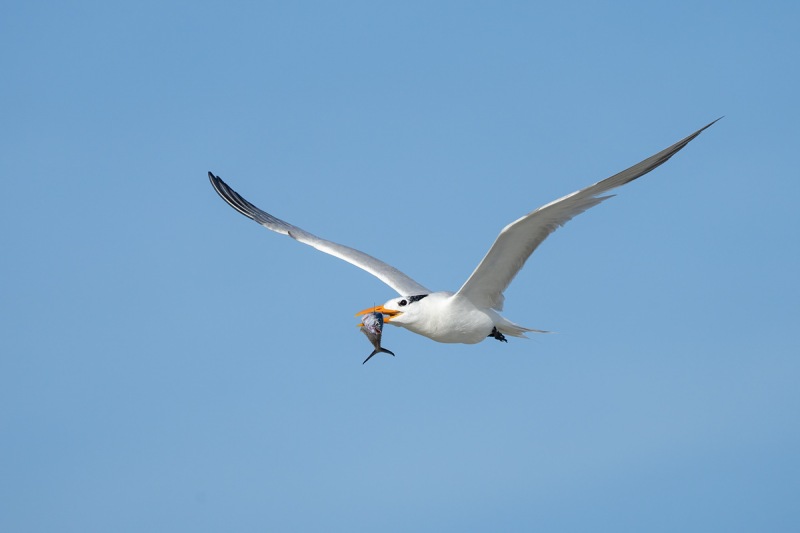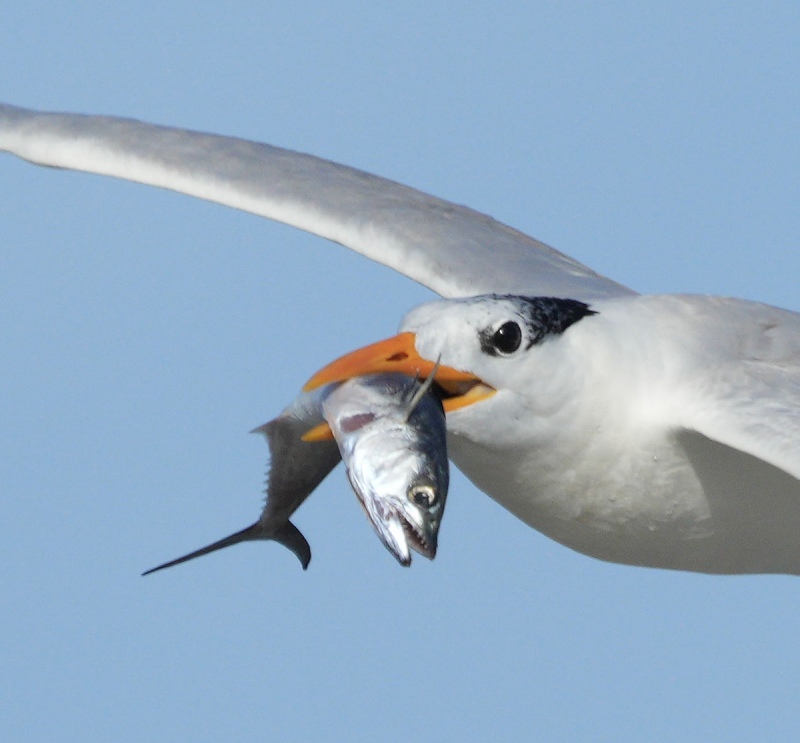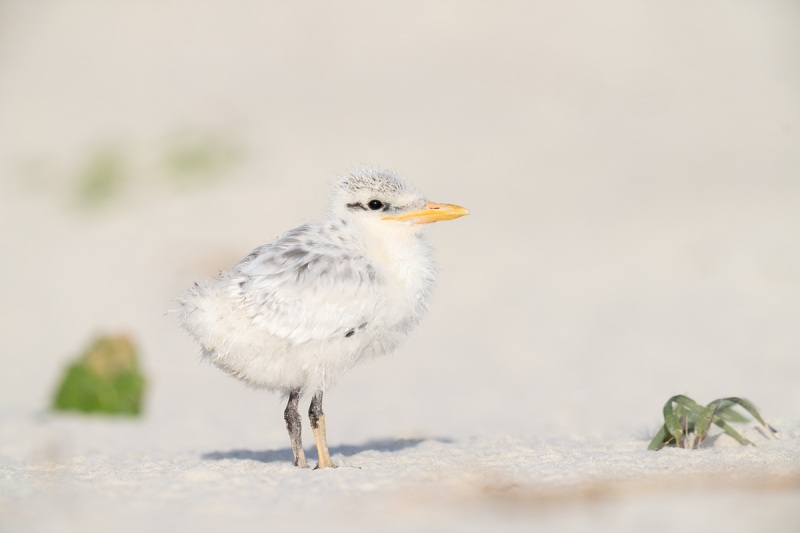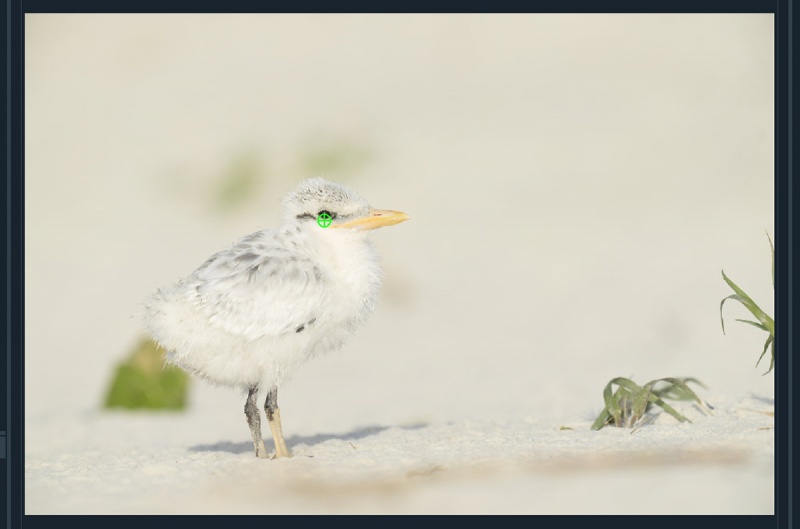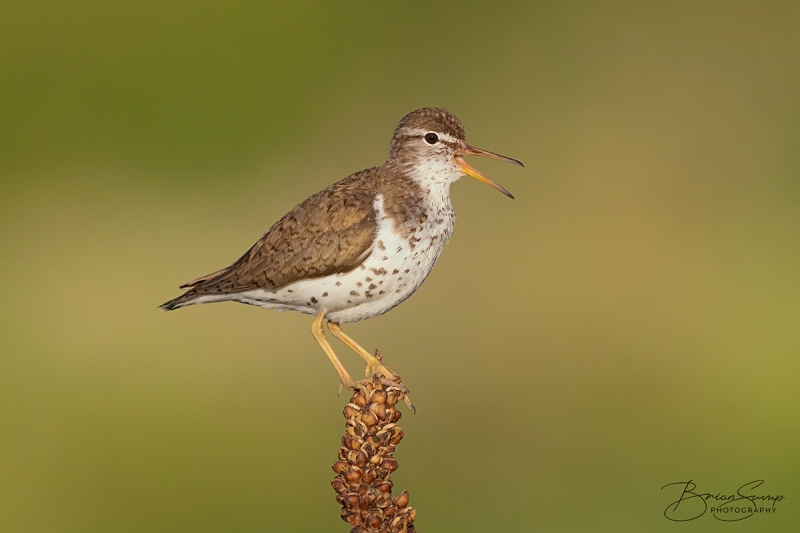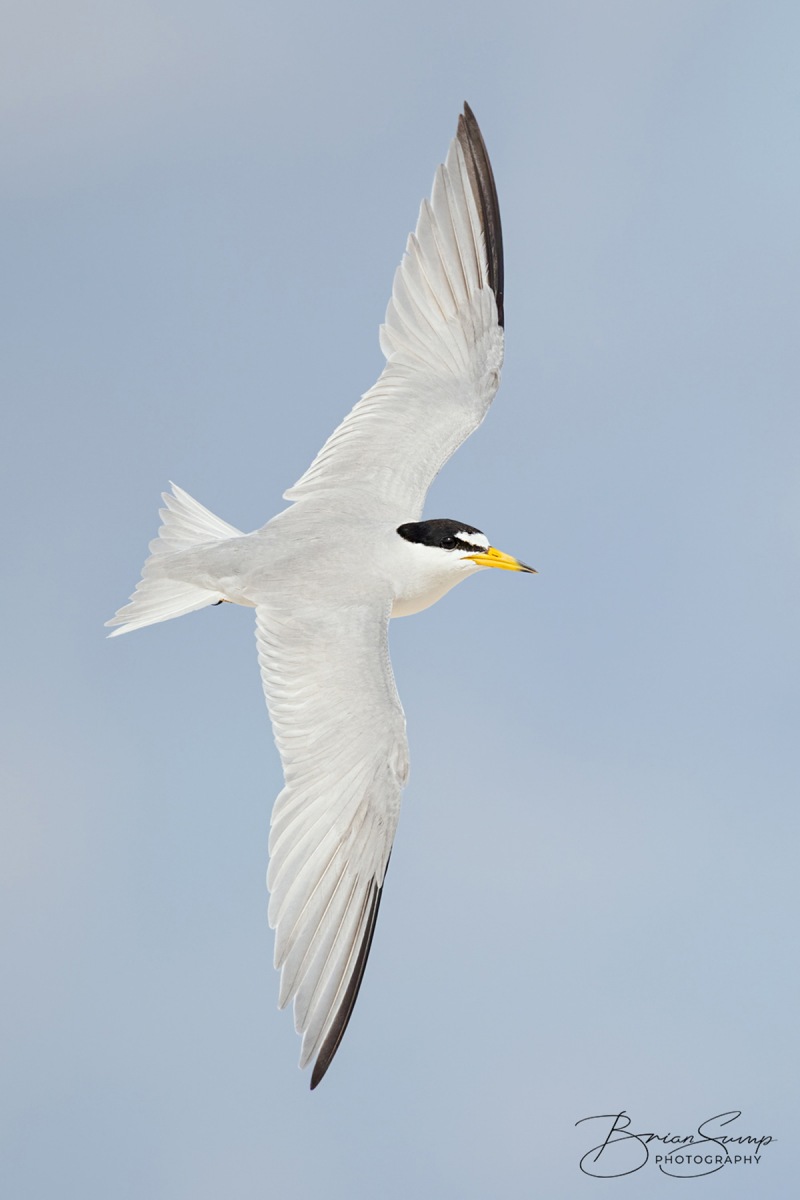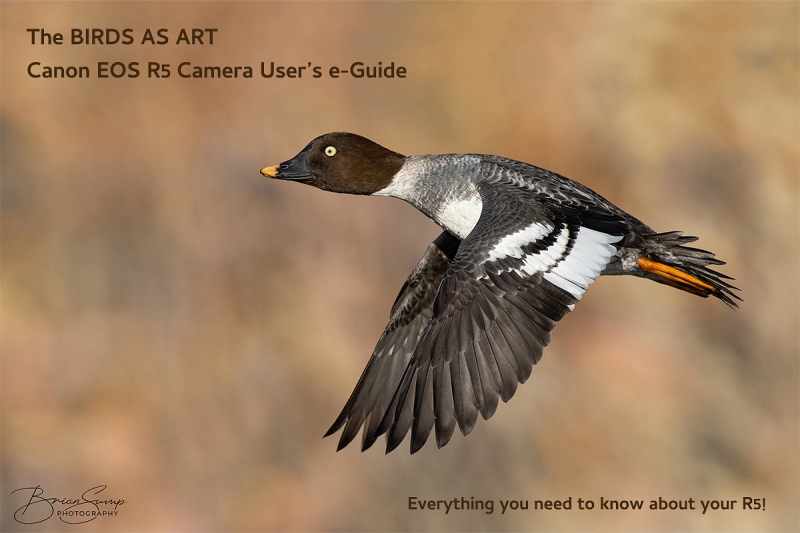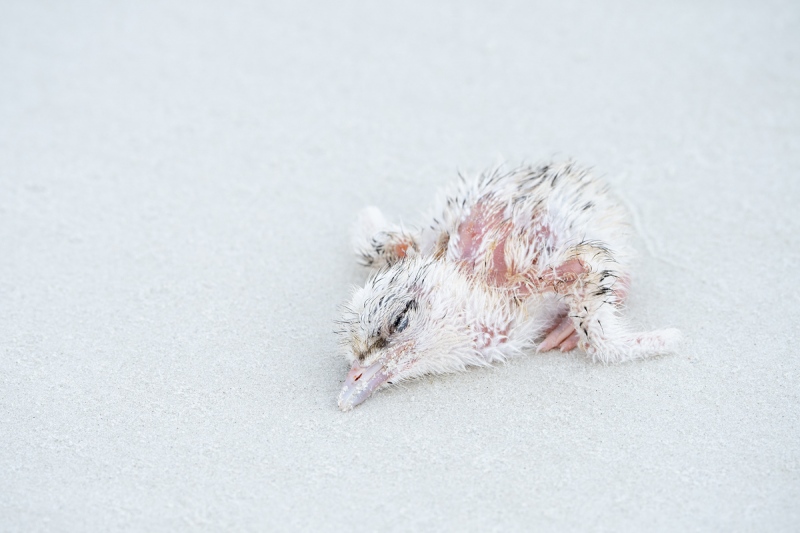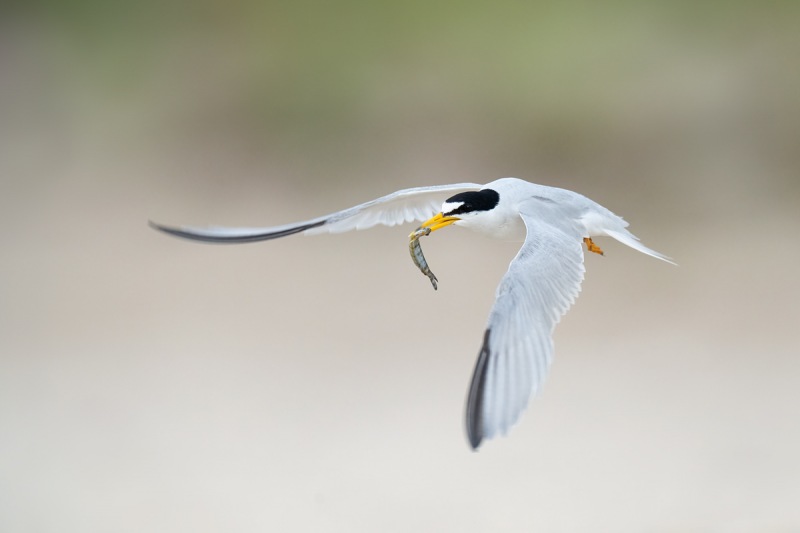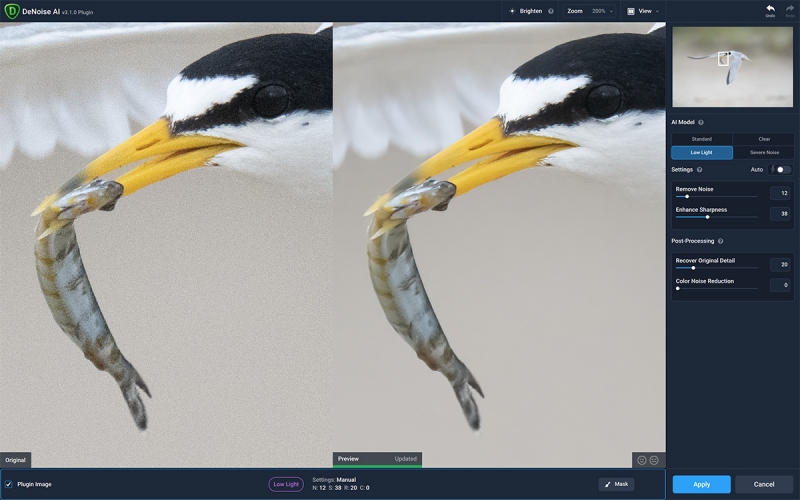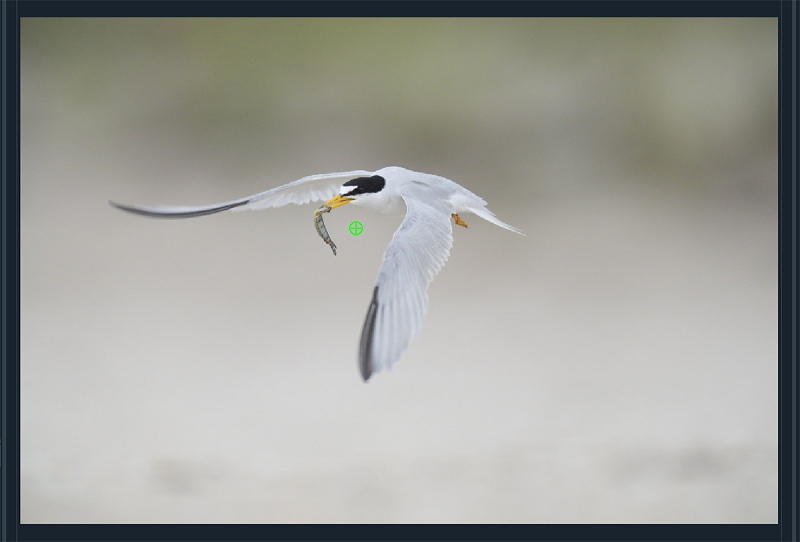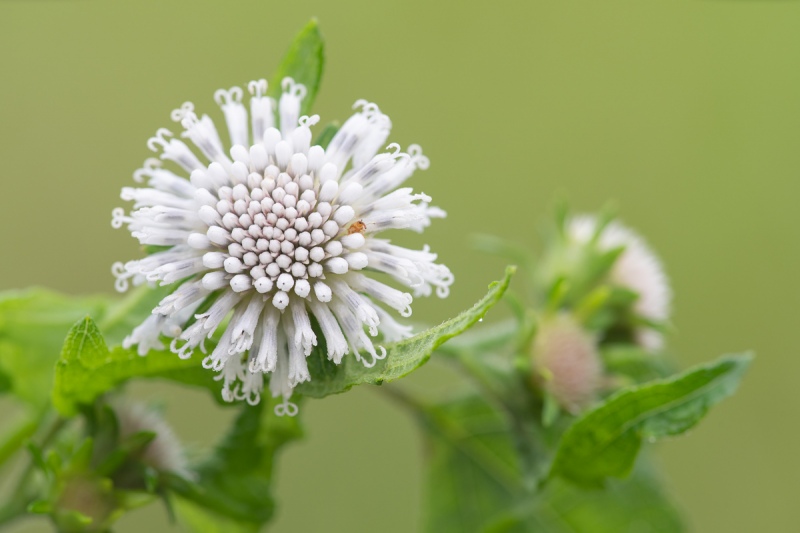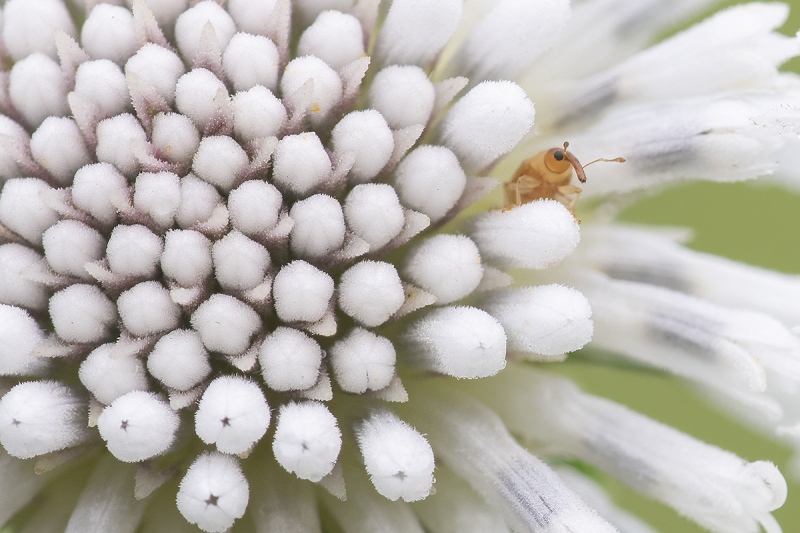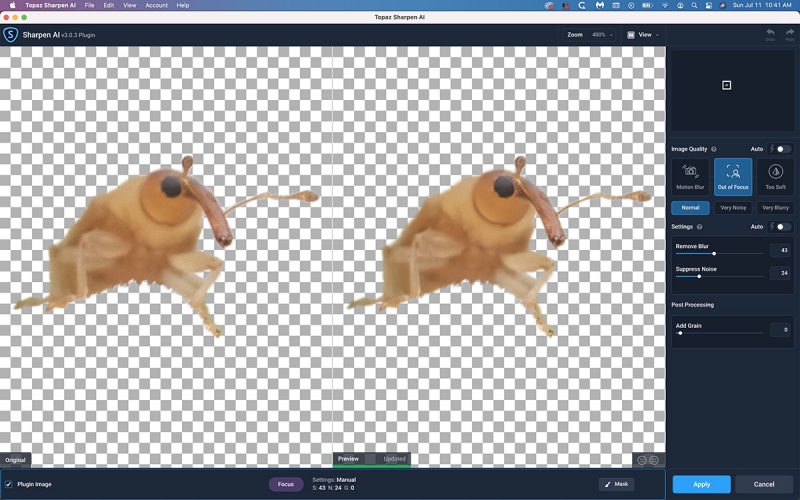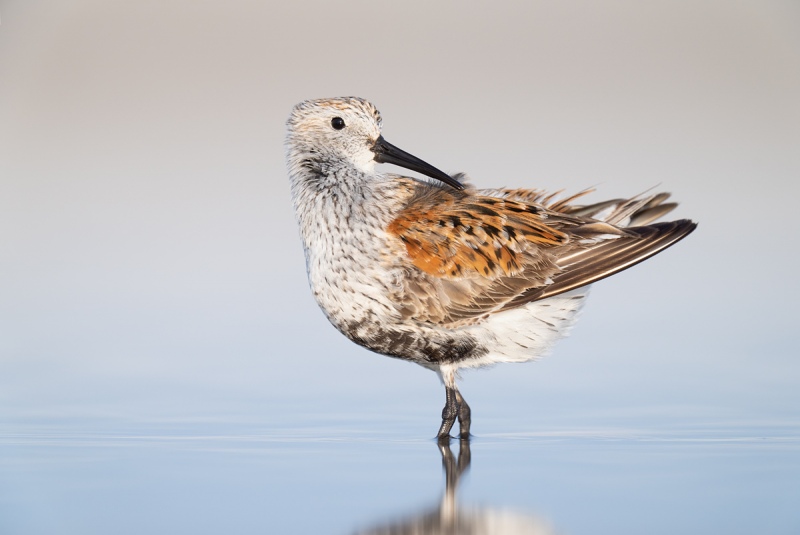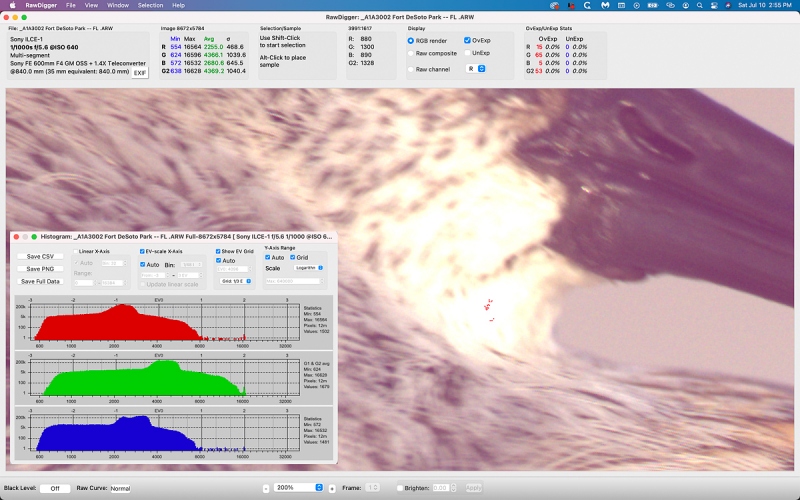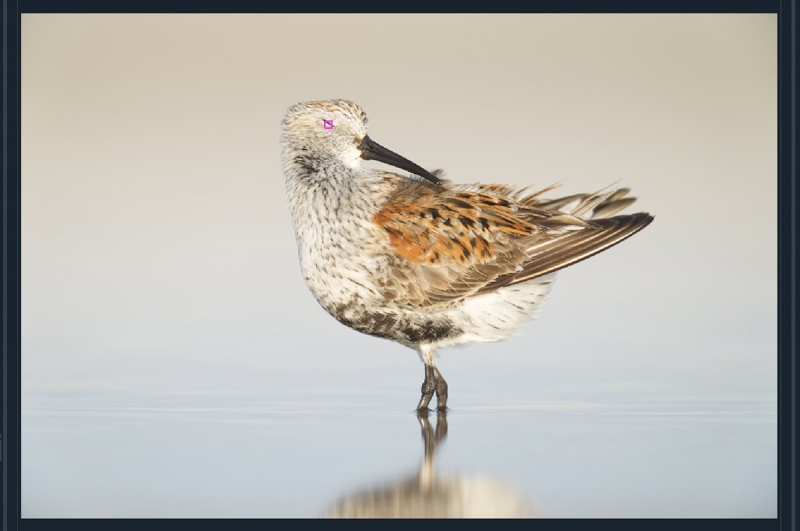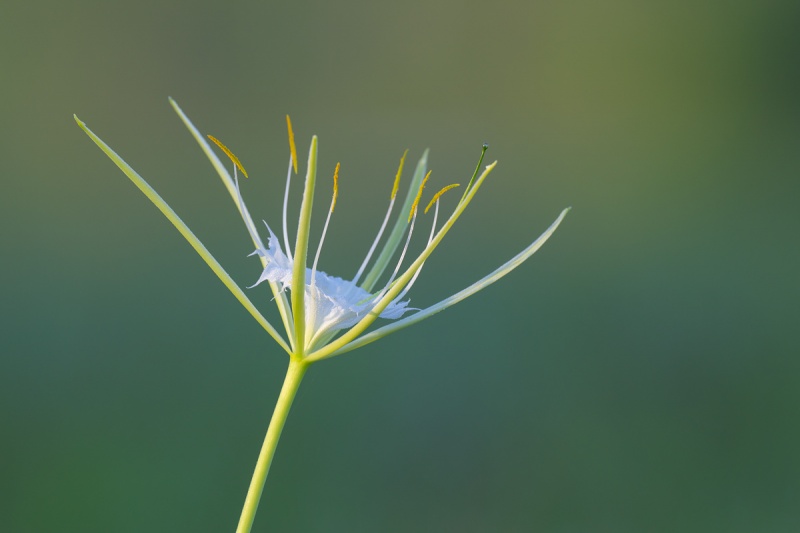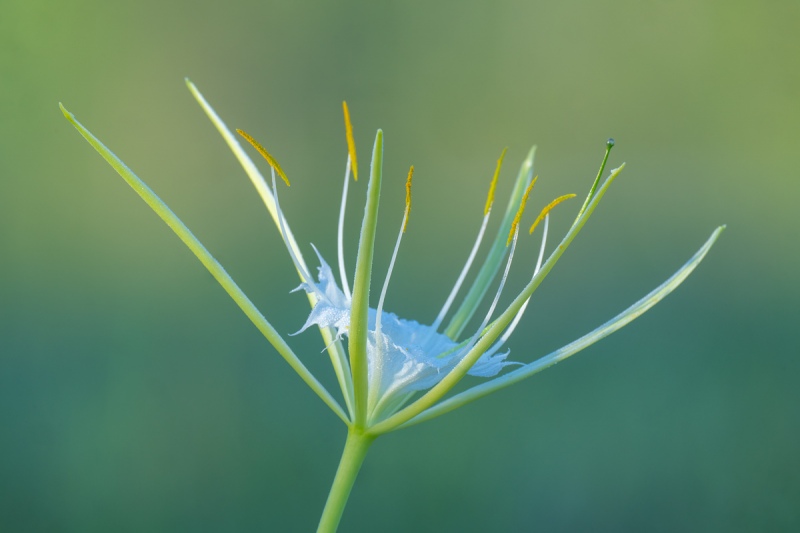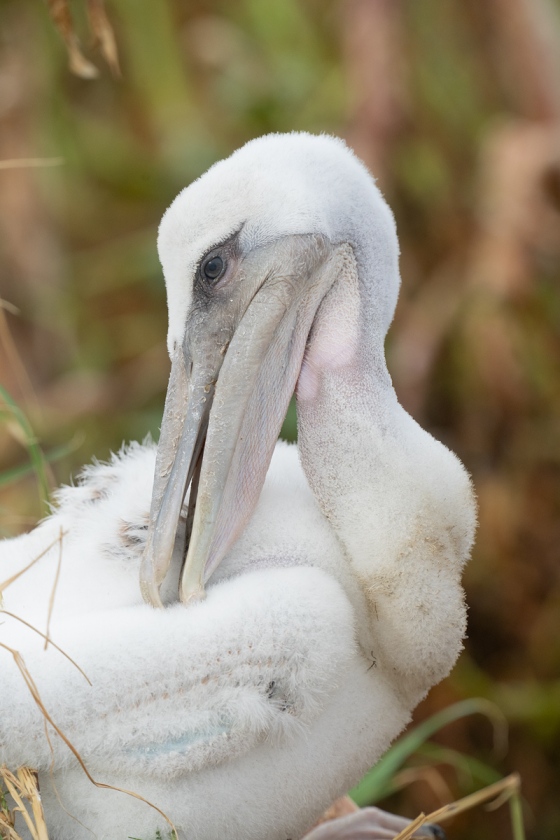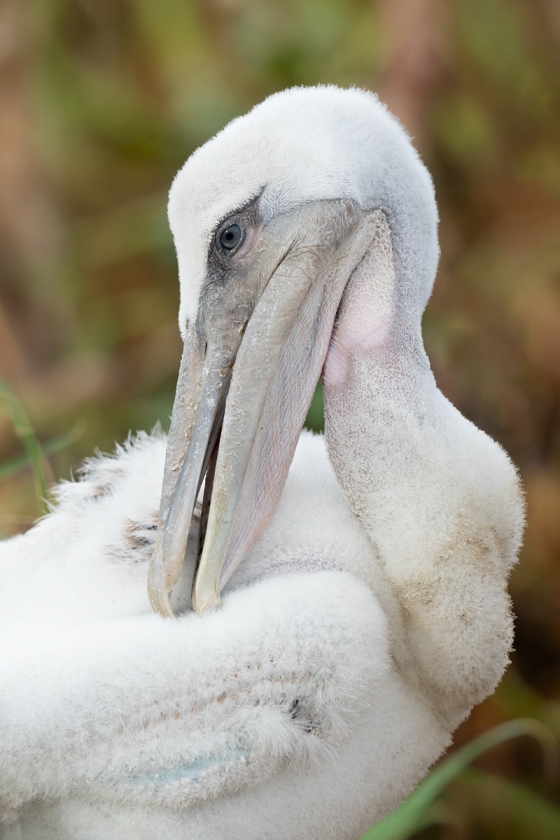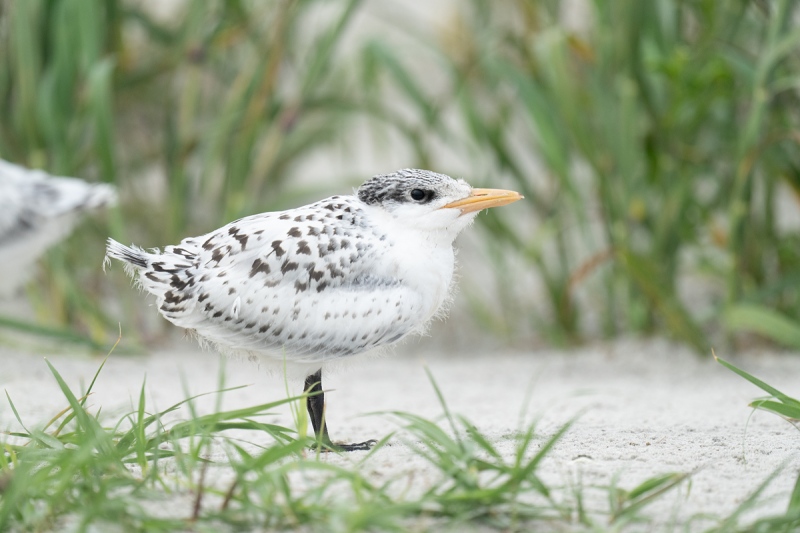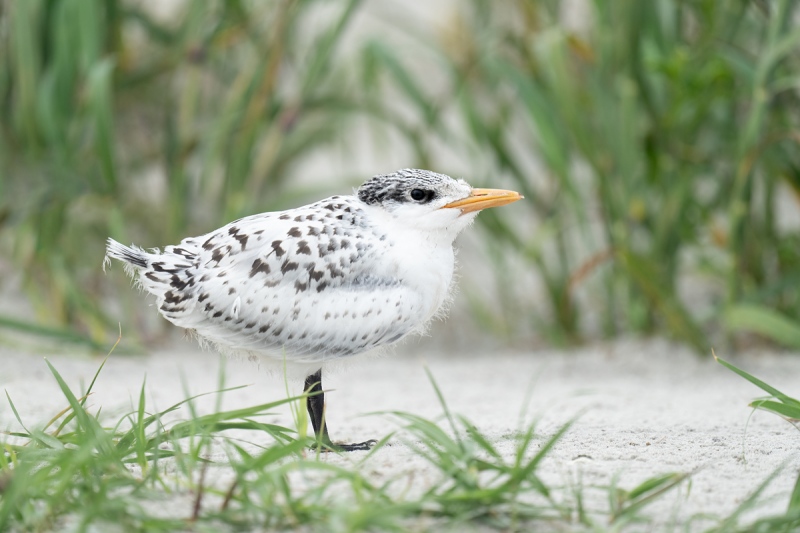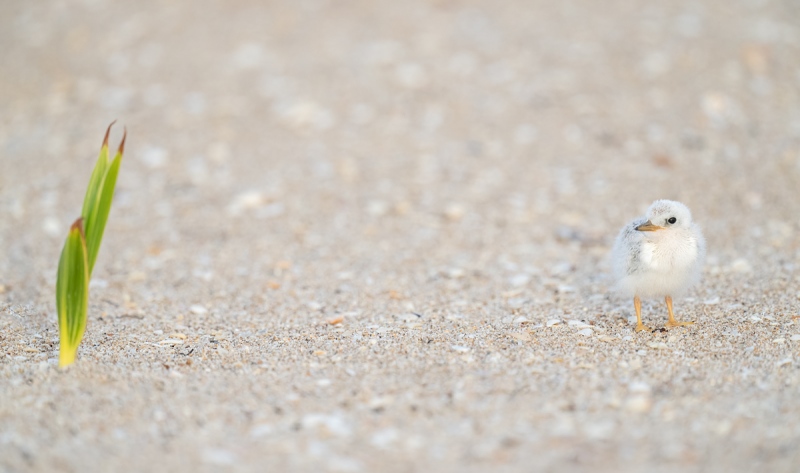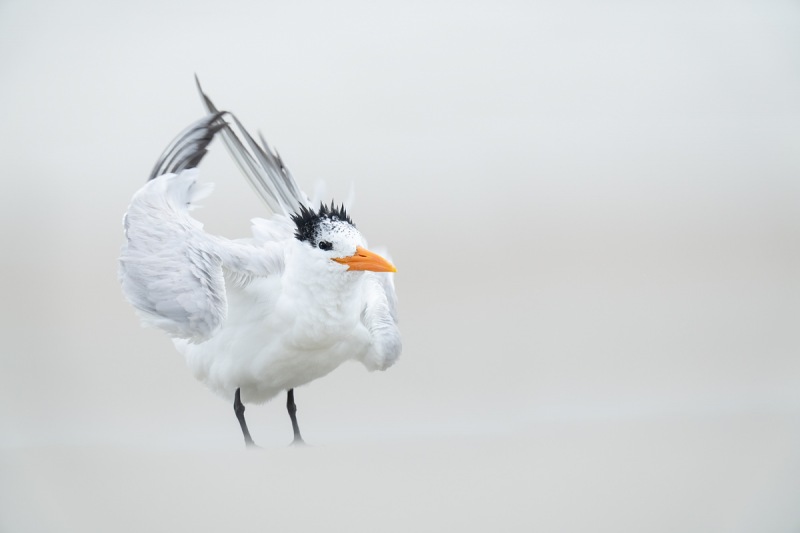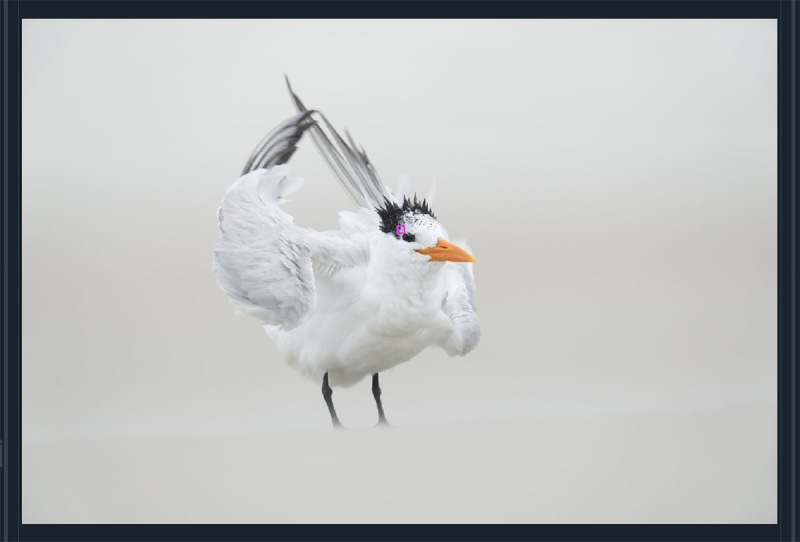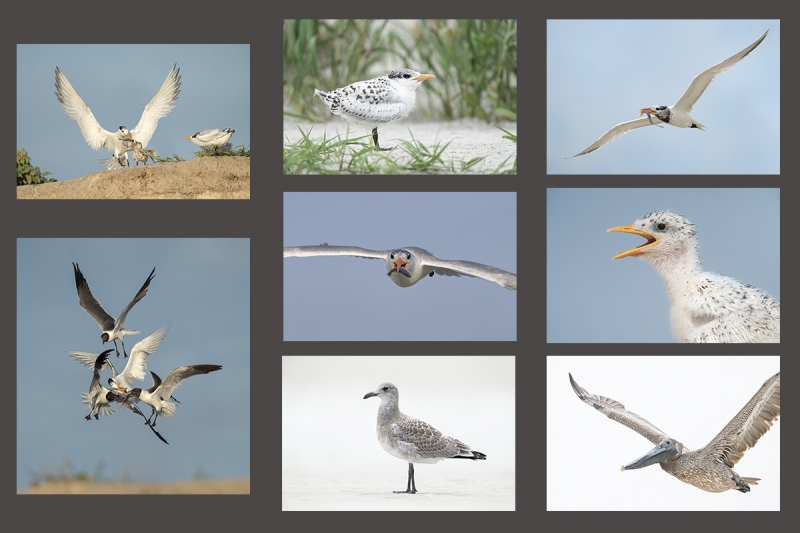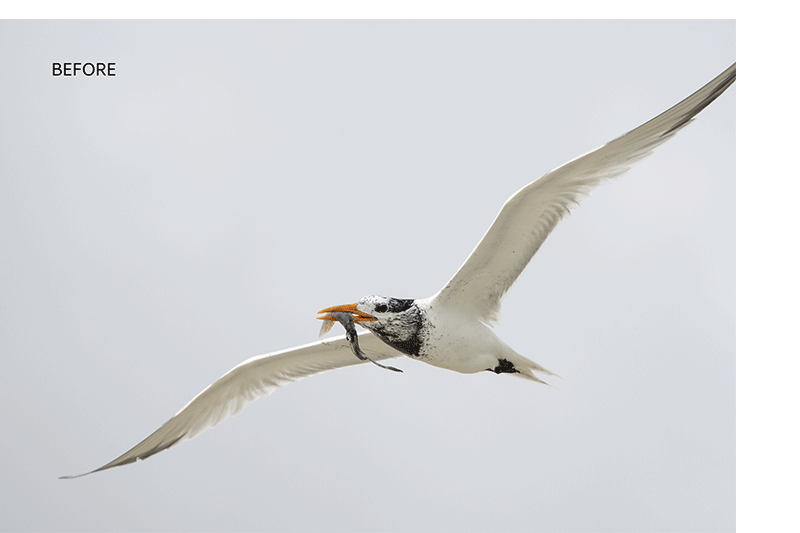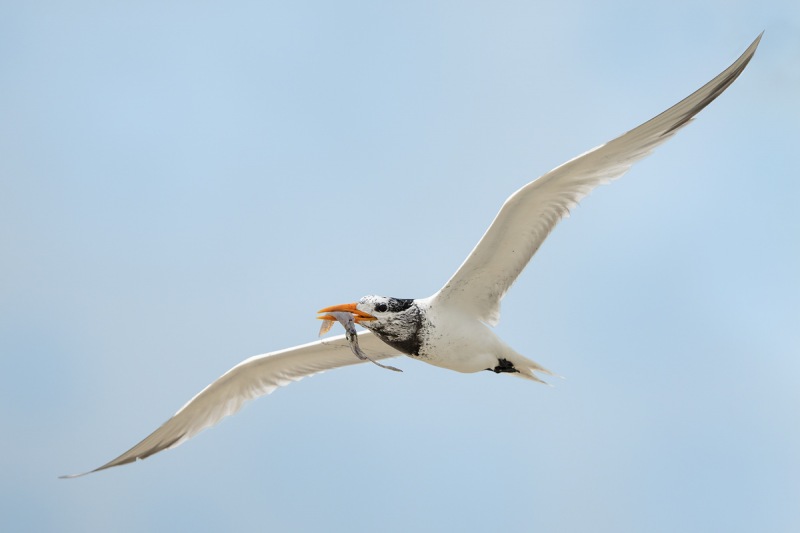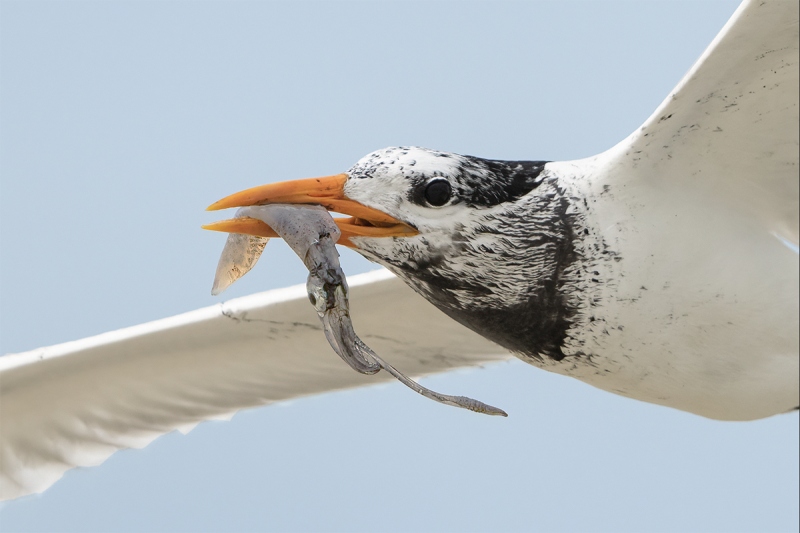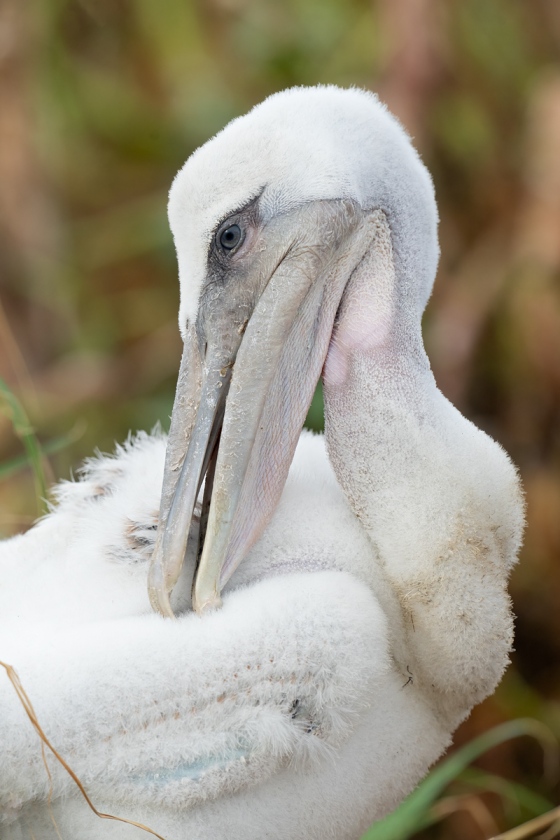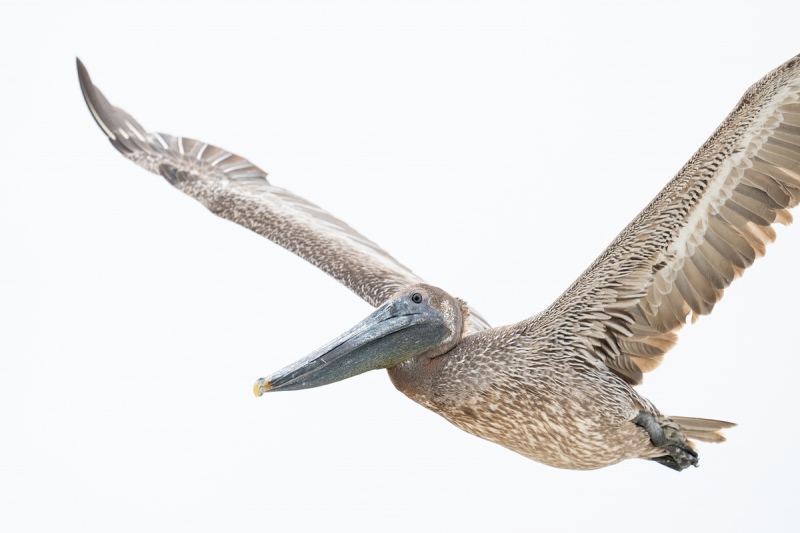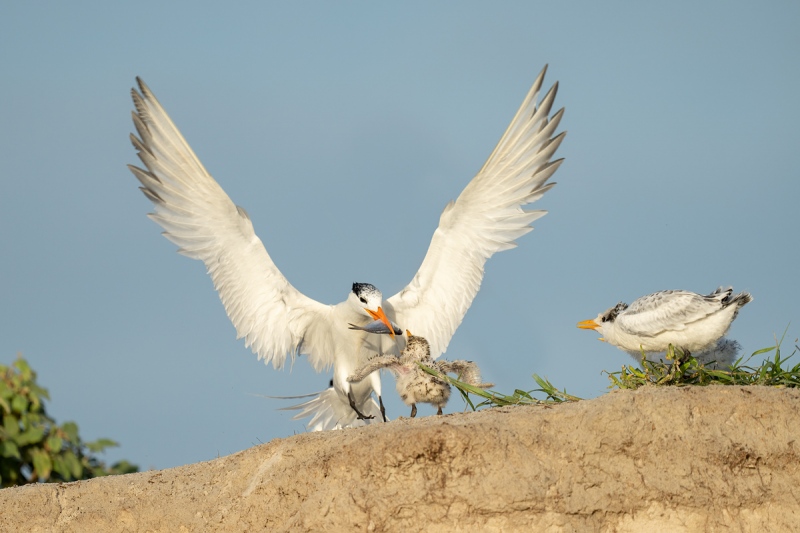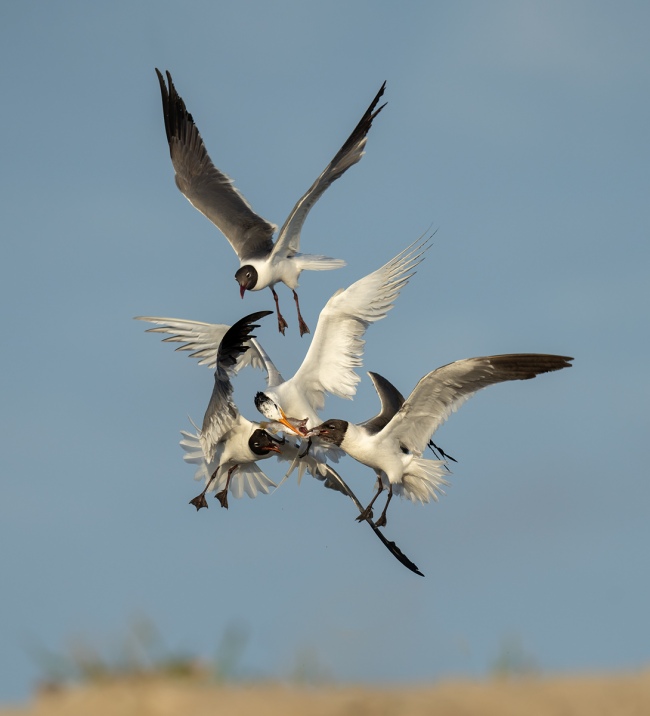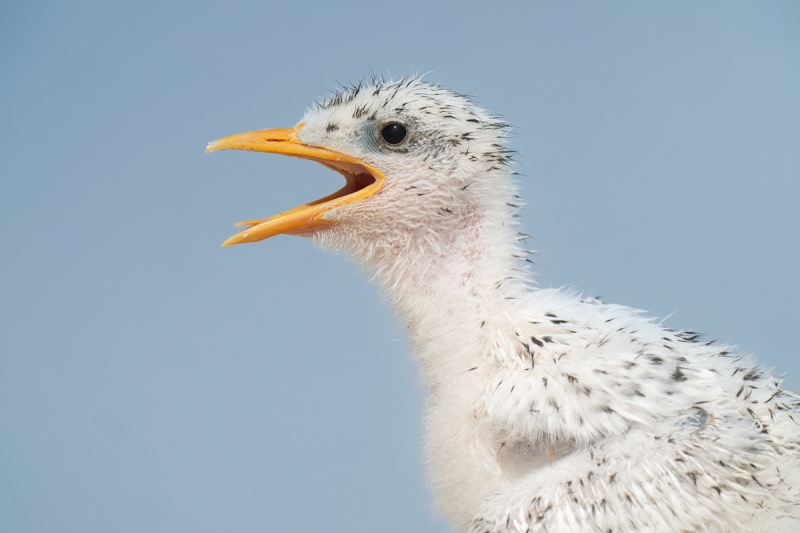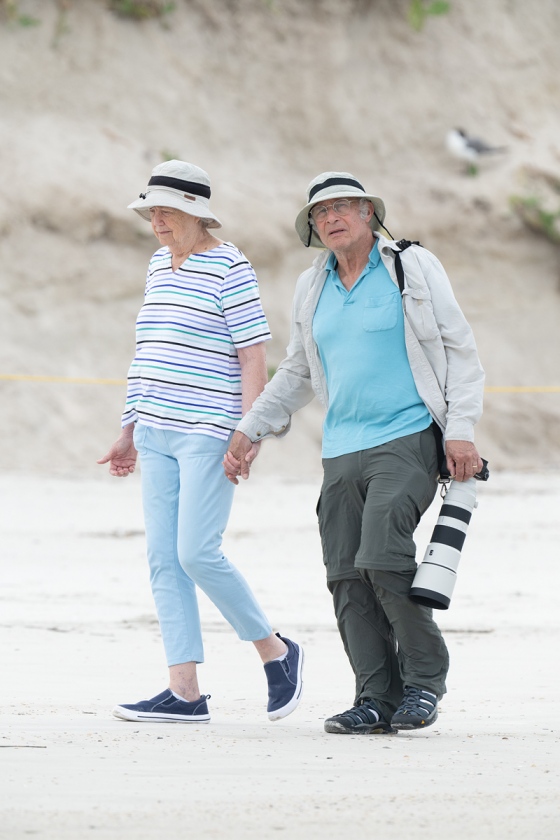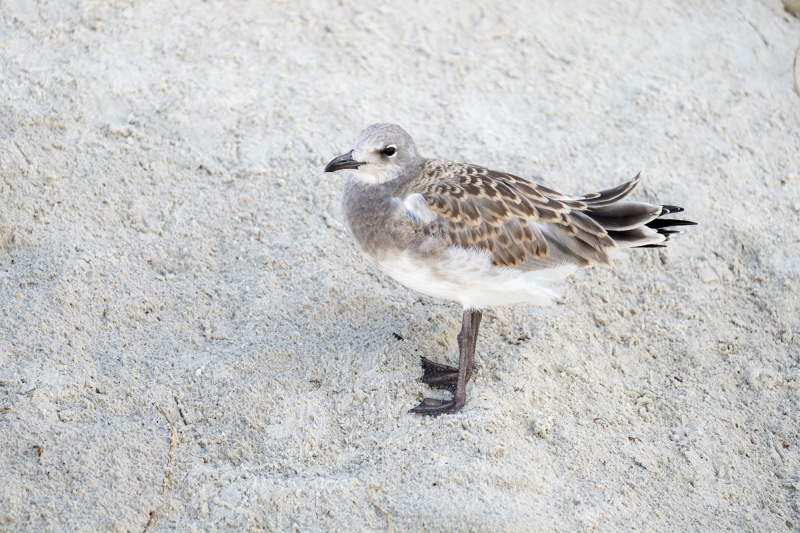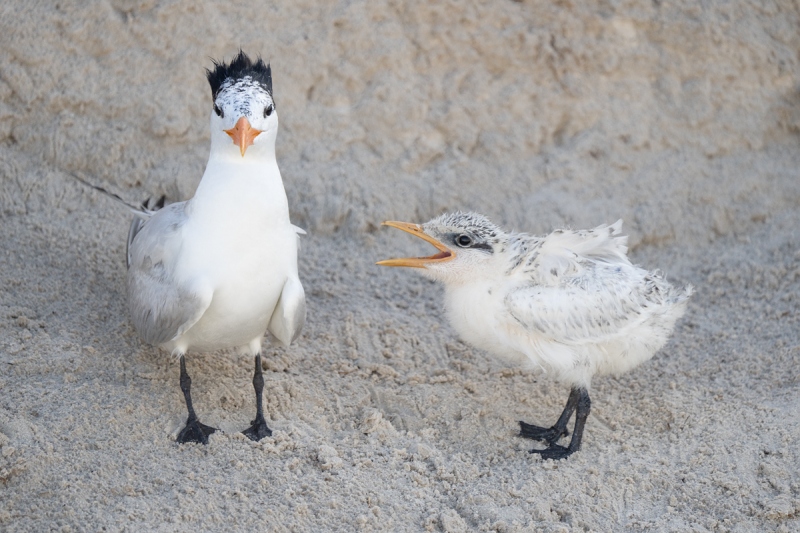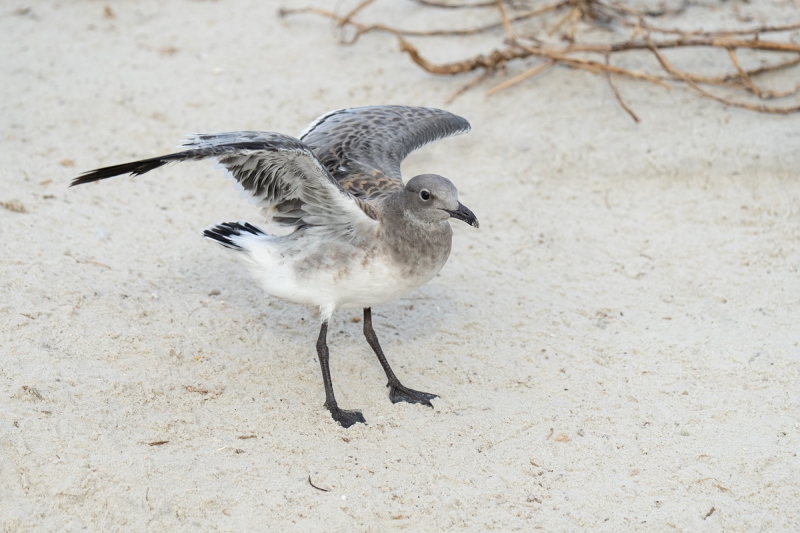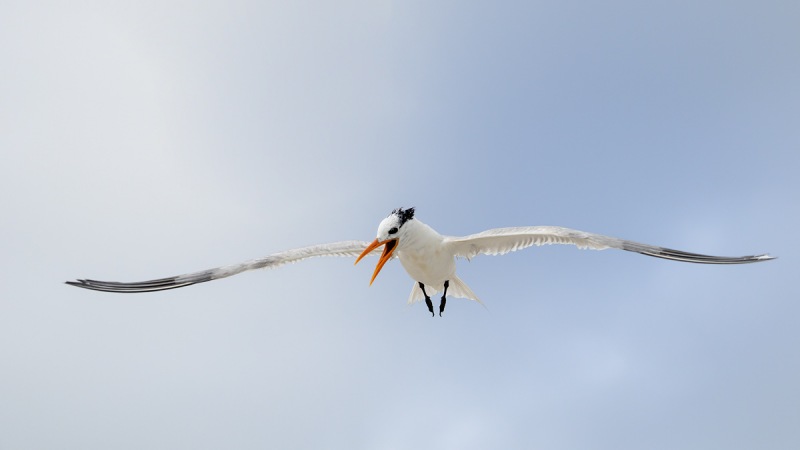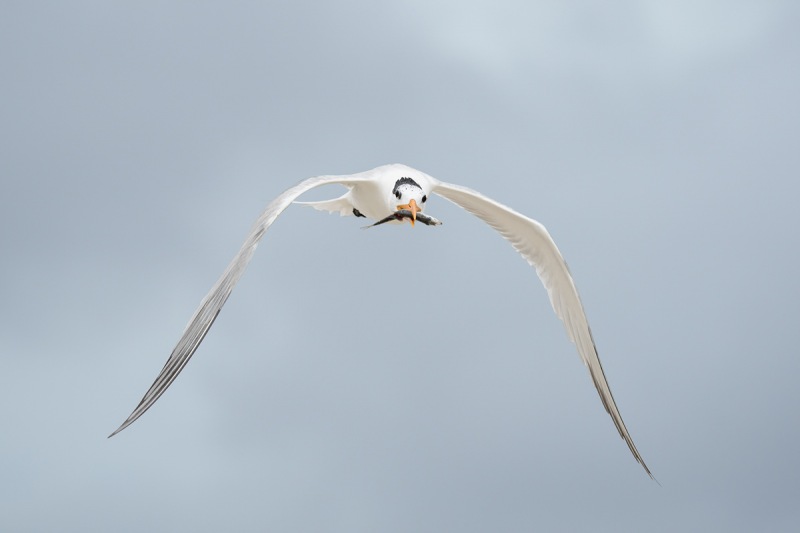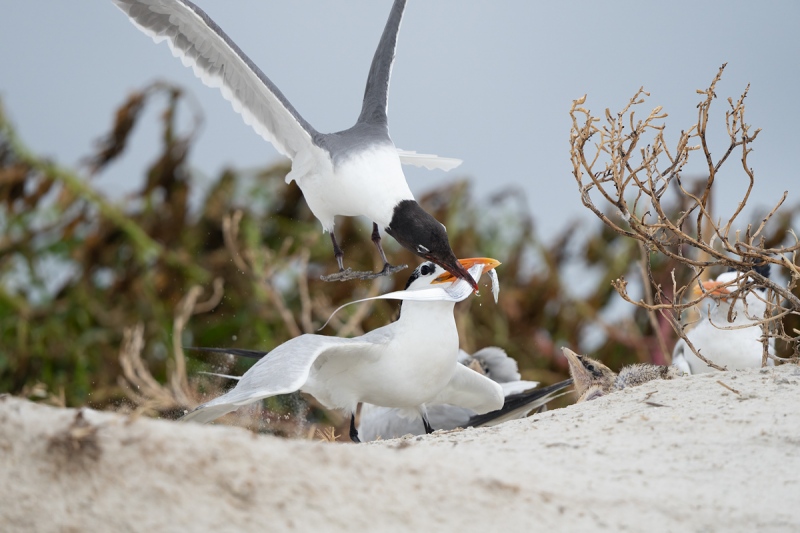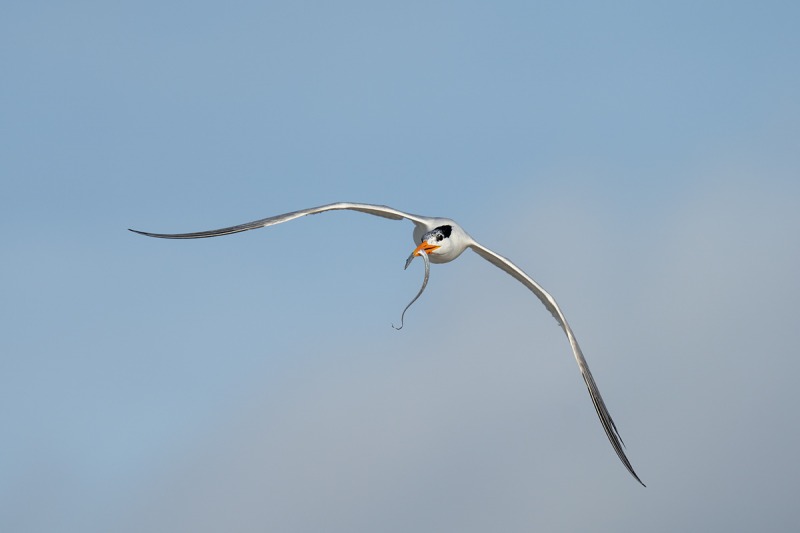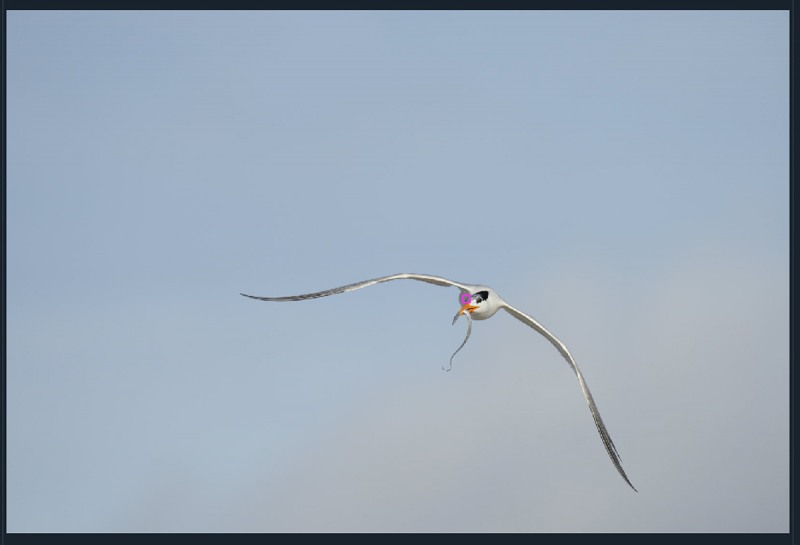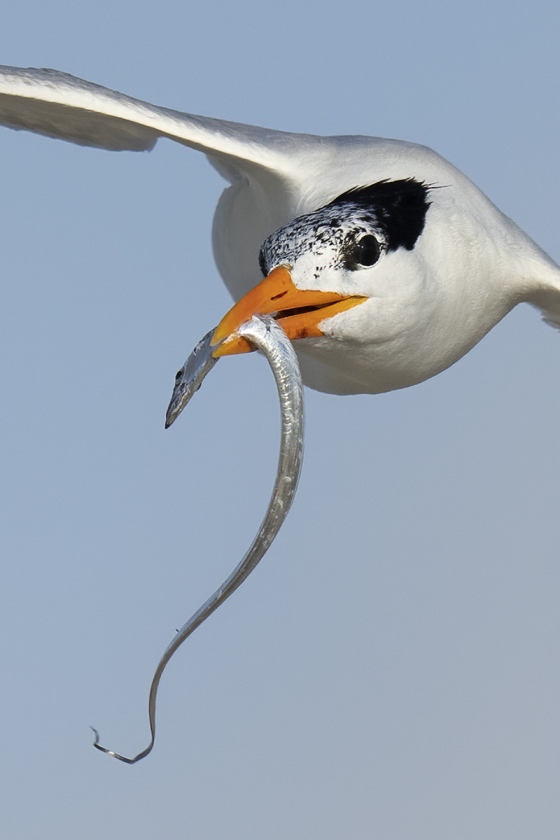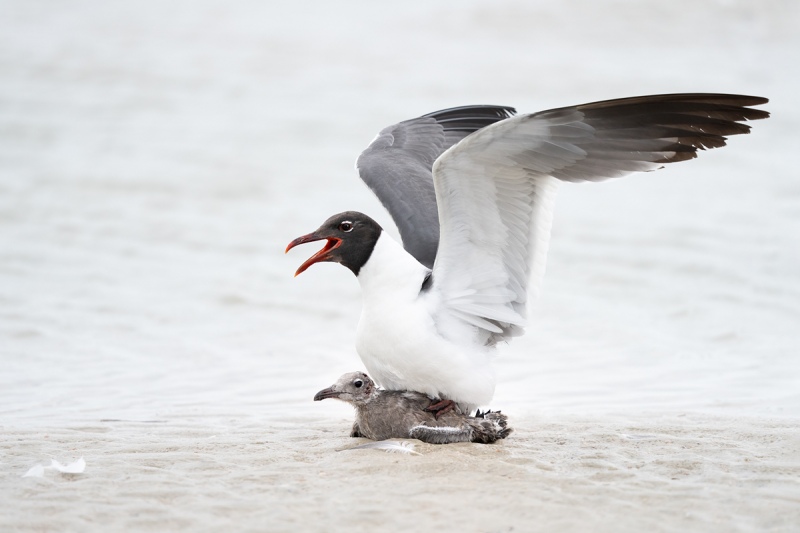July 19th, 2021 What’s Up?
The last morning of the 2nd JAX IPT was more of the same, more of an early southwest breeze and more wind against sun condition. None-the-less, we had a great morning. Donna Bourdon did chicks on the face of the dune early and wrong-way flight after that. Then she joined Lou Newman and Maida at the wash-over pool. Clemens and I started atop the ladders with the crazy-tall tripods working tern chicks on top of the dune at 1200mm. A few on the edge of a nearby ridge were really gorgeous. After a while, I headed down the beach for chicks and Clemens did flight. With wind against sun conditions, the trick to flight photography is to find birds flying the wrong way, or those turning or banking. Finally I joined Donna, Lou, and Maida at the pool where we all got some great stuff on handsome young Laughing Gulls. Lou had two great chances on a Royal Tern feeding sequence.
We were back at the AirBnB for brunch by ten and on the road by 11:40am. Donna flying JAX to ATL to Chattanooga while Lou and Maida headed to Sarasota. After dropping me off at ILE, Clemens will grab his car and continue on to Fort Lauderdale.
All in all it was a great trip despite the often challenging conditions. And the All-Wheel Drive (AWD) on my BMW X5 did great on the soft sand. We never even came close to getting stuck 🙂 Today is Monday 18 July 2021. Wherever you are, and whatever you are doing, I hope that you too have a great day.
Remember that you can find some great photo accessories (and necessities!) on Amazon by clicking on the Stuff tab on the orange/yellow menu bar above. On a related note, it would be extremely helpful if blog-folks like me, who spend too much money on Amazon, would get in the habit of clicking on the Amazon logo link on the right side of each blog post. As you might expect, doing so will not cost you a single penny, but would be appreciated tremendously by yours truly. And it works seamlessly with your Amazon Prime account.
This blog post took about two hours to prepare and makes 204 consecutive days with a new one. Please remember that if an item — a Delkin flash card, or a tripod head — for example, that is available from B&H and/or Bedfords, and is also available in the BAA Online Store, it would be great, and greatly appreciated if you would opt to purchase from us. We will match any price. Please remember also to use my B&H affiliate links or to save 3% at Bedfords by using the BIRDSASART discount code at checkout. Doing either often earns you free guides and/or discounts. And doing so always earns my great appreciation.
SONY a9 II Mirrorless Digital Camera Body
Wally Barkley is offering a Sony a9 II in near-mint condition for a BAA record-low $2694.00. The sale includes the original box and everything that came in it including one battery and the charger, strap. Insured ground shipping via major courier to lower-48 US addresses only is also included. Your item will not ship until your check clears unless other arrangements are made.
Please contact Wally via e-mail or by phone at 1-231-675-6546 Eastern time zone.
As things worked out, the a9, and then the a9 ii, turned out to be life-changers for me. From the moment I tracked that first incoming Brandt’s Cormorant at LaJolla, I knew that at that time, the SONY a9 series bodies featured the world’ best AF. I upgraded to the a9 ii as soon as it was released for the slightly larger body size. At one point I owned two a9 ii bodies. A new a9 ii sells for $4,498.00 so you can save a very nice $1804.00 by grabbing Wally’s a9 ii ASAP. Not to mention that the new Sony A1 sells for $6498.00 … artie
|
|
|
This image was created on 17 July 2021 on the last afternoon of the second JAX IPT. While seated on dry sand using the knee-pod technique, I used the hand held Sony FE 200-600mm f/5.6-6.3 G OSS lens with the Sony FE 1.4x Teleconverter (at 734mm) and The One, the Sony Alpha 1 Mirrorless digital camera. ISO 800. Exposure determined via Zebras with ISO on the rear dial: 1/2000 sec. at f/10 (stopped down one-stop) in Manual mode. AWB at 6:09pm on a sunny afternoon.
Wide AF-C/Bird-Eye/Face Detection AF was active at the moment of exposure and performed just about perfectly (as below). Click on the image to view a larger version
Image #1: Royal Tern chick begging
|
The Best Option …
Before we headed out to the beach on Saturday afternoon, I said to the group, “With wind against sun, a good option is to get close to some chicks by the wash-over pool and wait for a parent bird to return with a fish. There is at least a chance that the chick will turn away from the wind to face the parent that will be landing into the wind. If you get lucky, you can get something decent with the chick facing you.” I got very lucky. Image #1 was my favorite from a nine frame burst created within the same second.
I scootched to my right to get squarely on sun angle with this chick. I had planned to get the camera on the ground and work off the rear screen. Lucky for me, I did not have time to do that. As the chick reacted to an adult flying by overhead at close range I acquired focus almost instantly and fired away. This chick went hungry for at least a while longer.
|
|
Image #1A: AF point for the Royal Tern chick begging image
|
Bird Eye/Face Detection Improved
Firmware update V1.10 completely eliminated the electronic viewfinder (EVF) problem that plagued a1 shooters from Day One. In addition, the performance of the already-amazing Bird Eye/Face Detection AF was significantly improved with the recent firmware update.
Note the small, proportionate crop from the right and from below. Tip: select Original Ratio from the Crop Tool drop-down menu.
SONY and artie
Switching to SONY, first with the a9 and the a9 II, and then with the remarkable a1, has enabled me (and others, like Mike De Rosa as seen recently in the blog post here), to create images of birds in flight and in action that I could not have even dreamed of when using Canon for 33 years and then Nikon for more than two. Most of the time I am using one of two AF methods that together, cover about 99% of the commonly-encountered bird photography situations. Learn more by joining the group!
From Long-ago IPT veteran Keith Kennedy via e-mail
Absolutely great information. I am calling Jim in a few minutes to order a couple of Delkin 128GB UHS-II cards. Your timely email has saved me a ton of money! Many thanks
In the same vein, via e-mail from John LeClair
Well, e-mail #21 alone was worth the price of admission!
From Pamela Viale, after receiving my a1 settings along with detailed instructions on how to copy them to her SONY a1 via e-mail
This e-mail group has been an incredible boon to me! Thank you so much!
From Joe Barranco via e-Mail
Thanks for your great ideas on the A1 set up. I have been getting MANY more keepers doing things your way!
From Barbara White via e-Mail
Wow, I just gotta say – I learn so much from the SONY Alpha a1 Set-up and Info group! My camera is on my desk, and I’m always picking it up and changing something that I’ve read about in the e-mails.
Thanks, Barbara
From Janet Horton via e-Mail
Hi Artie, Mystery solved. Yes, I was able to replicate what you did. I forgot that you have to set self-timer using the upper dial. I am used to that being a MENU selection.
Thanks much, Janet
SONY Alpha a1 Set-up and Info Group
The SONY Alpha a1 Set-up and Info Group is going great guns as more and more folks chime in with thoughtful questions and experience-based answers. As the a1 is becoming more readily available, more and more folks are getting their hands on this amazing body. With two folks joining yesterday, we are now up to an astounding 67 lucky and blessed photographers! Early on, we discussed the myriad AF options. I gave my opinion as to the best one for flight and general bird photography. More recently, we have been in contact with folks at SONY sharing our thoughts, experiences, and frustrations with the EVF blackout problem.
All who purchased their Alpha a1 bodies via a BAA affiliate link will receive a free subscription to the Sony Alpha a1 Set-Up and Info Updates after shooting me their receipts via e-mail. (Note: it may take me several days to confirm B&H orders.) This same service may be purchased by anyone with an a1 body via a $150.00 PayPal sent to birdsasart@verizon.net indicating payment for Alpha a1 Info Updates. Alternatively, folks can call Jim weekdays at 1-863-692-0906 to pay via credit card. New members will receive composite e-mails that summarize all previous discussions.
Beach Clean-Up
Most of the beach clean-up here was done with the Patch Tool. I used a bit of Content-Aware Fill. I did not use the Clone Stamp Tool at all. The clean-up job alone took about 25 minutes. I know that there will be a few out there who prefer the messy original version with the bits of shell and tiny feathers. I do not 🙂
|
|
The BIRDS AS ART Current Workflow e-Guide (Digital Basics II).
You can order your copy from the BAA Online Store here, by sending a PayPal for $40 here, or by calling Jim or Jennifer weekdays at 863-692-0906 with your credit card in hand. Be sure to specify Digital Basics II.
|
The BIRDS AS ART Current Workflow e-Guide (Digital Basics II)
The Photoshop Tools used with all of my clean-up techniques along with dozens of other great Photoshop tips and techniques — along with all of my personalized Keyboard Shortcuts, are covered in detail in the BIRDS AS ART Current Workflow e-Guide (Digital Basics II), an instructional PDF that is sent via e-mail. Learn more and check out the free excerpt in the blog post here. While the new e-Guide reflects my MacBook Pro/Photo Mechanic/DPP 4/Photoshop workflow, folks using a PC and/or BreezeBrowser will also benefit greatly by studying the material on DB II. Note: folks working on a PC and/or those who do not want to miss anything Photoshop may wish to purchase the original Digital Basics along with DB II while saving $15 by clicking here to buy the DB Bundle.
Folks who learn well by following along rather than by reading can check out the complete collection of MP 4 Photoshop Tutorial Videos by clicking here. Note: all of the videos are now priced at an amazingly low $5.00 each.
You can learn how and why I converted all of my Canon digital RAW files in DPP 4 in the DPP 4 RAW Conversion Guide here. More recently, I became proficient at converting my Nikon RAW (NEF) files in Adobe Camera Raw. About two years ago I began converting my Nikon and Sony RAW files in Capture One Pro 12 and continue to do so today.
You can learn advanced Quick Masking and advanced Layer Masking techniques in APTATS I & II. You can save $15 by purchasing the pair.
Typos
With all blog posts, feel free to e-mail or to leave a comment regarding any typos or errors.
July 18th, 2021 Your Fave?
Please take a moment to leave a comment; let us know which of today’s two featured images you like best, and why you made your choice.
What’s Up?
Though the weather has been a challenge — nothing but sun all day every day, with a slight breeze from the southwest early each morning and a strong southeast wind in the afternoons, everyone has gotten lots of great images. On Saturday morning the wind switched to southeast earlier than it had on Friday so we had lots of more excellent flight photography. Again, we enjoyed some gorgeous clouds in the low western sky. At one point, I did head shots with the hand held 200-600 and the 2X teleconverter just to show that it can be done. Not surprising, Bird- Eye/Face tracking worked perfectly. Images soon.
Saturday afternoon was more of the same; we had a hard south wind blowing right at the bright sun. None-the-less, we had some success by sitting near the wash-over pool with long focal lengths and picking off chicks that faced us inadvertently while begging. With lots of birds right in front of us, we were getting head shots of adult and young terns until a sheriff’s vehicle with lights flashing drove slowly right through the birds while on patrol. When we got close to another group on the far side of the pool, a woman with her kid, about five, was teaching him to run through the flocks of resting birds. We left.
Today is Sunday 18 July, the last morning of the IPT. We are heading to the beach at 5:30am, and should be on the road back to ILE before noon. Wherever you are, and whatever you are doing, we hope that you too have a great day.
Remember that you can find some great photo accessories (and necessities!) on Amazon by clicking on the Stuff tab on the orange/yellow menu bar above. On a related note, it would be extremely helpful if blog-folks like me, who spend too much money on Amazon, would get in the habit of clicking on the Amazon logo link on the right side of each blog post. As you might expect, doing so will not cost you a single penny, but would be appreciated tremendously by yours truly. And it works seamlessly with your Amazon Prime account.
This blog post took more than an hour to prepare and makes 203 consecutive days with a new one. Please remember that if an item — a Delkin flash card, or a tripod head — for example, that is available from B&H and/or Bedfords, and is also available in the BAA Online Store, it would be great, and greatly appreciated if you would opt to purchase from us. We will match any price. Please remember also to use my B&H affiliate links or to save 3% at Bedfords by using the BIRDSASART discount code at checkout. Doing either often earns you free guides and/or discounts. And doing so always earns my great appreciation.
Please Remember
With income from IPTs now close to zero, please, if you enjoy and learn from the blog, remember to use one of my two affiliate programs when purchasing new gear. Doing so just might make it possible for me to avoid having to try to get a job as a Walmart greeter and will not cost you a single penny more. And if you use Bedfords and remember to enter the BIRDSASART code at checkout, you will save 3% on every order and enjoy free second-day air shipping. In these crazy times — I am out at least forty to sixty thousand dollars so far due to COVID 19 (with lots more to come) — remembering to use my B&H link or to shop at Bedfords will help me out a ton and be greatly appreciated. Overseas folks who cannot order from the US because of import fees, duties, and taxes, are invited to help out by clicking here to leave a blog thank you gift if they see fit.
New and Better Bedfords Discount Policy!
You can now save 3% on all of your Bedfords photo gear purchases by entering the BIRDSASART coupon code at checkout. Your discount will be applied to your pre-tax total. In addition, by using the code you will get 2nd day air shipping via Fed Ex.
Grab a Nikon AF-S Teleconverter TC-14E III and save $14.99. Purchase a Canon EOS R5 and your discount will be $116.97. Purchase a Sony FE 600mm f/4 GM OSS lens and save a remarkable $389.94! Your Bedford’s purchase no longer needs to be greater than $1,000.00 for you to receive a discount. The more you spend, the more you save.
Money Saving Reminder
Many have learned that if you need a hot photo item that is out of stock at B&H and would enjoy free second-day air shipping, your best bet is to click here, place an order with Bedfords, and enter the coupon code BIRDSASART at checkout. If an item is out of stock, contact Steve Elkins via e-mail or on his cell phone at (479) 381-2592 (Central time). Be sure to mention the BIRDSASART coupon code and use it for your online order to save 3% and enjoy free 2nd-day air shipping. Steve has been great at getting folks the hot items that are out of stock at B&H and everywhere else. The wait lists at the big stores can be a year or longer for the hard to get items. Steve will surely get you your gear long before that. For the past year, he has been helping BAA Blog folks get their hands on items like the SONY a9 ii, the SONY 200-600 G OSS lens, the Canon EOS R5, the Canon RF 100-500mm lens, and the Nikon 500mm PF. Steve is personable, helpful, and eager to please.


Gear Questions and Advice
Too many folks attending BAA IPTs (remember those?) and dozens of photographers whom I see in the field and on BPN, are–out of ignorance–using the wrong gear, especially when it comes to tripods and more especially, tripod heads… Please know that I am always glad to answer your gear questions via e-mail
|
|
|
This image was created on 15 July 2021 late on the first morning of the second JAX IPT. While seated on wet sand using the knee-pod technique, I used the hand held Sony FE 600mm f/4 GM OSS lens with the Sony FE 1.4x Teleconverter and The One, the Sony Alpha 1 Mirrorless digital camera. ISO 800. I seriously screwed up the exposure by accidentally turning off Zebras (with ISO on the rear dial): 1/2000 sec. at f/8 (stopped down one stop) in Manual mode. AWB at 9:34am on a sunny morning.
Tracking: Flexible Spot AF with Bird-Eye/Face Detection set performed perfectly.
Image #1: Royal Tern large chick swimming in run-over pool
|
Wind Against Sun
In the afternoons there have been lots of tern chicks in the run-over pool and they have been fairly easy to approach. But with bright sun and a strong wind from the southeast, all of the birds in the water are facing directly away from the light. And that includes swimming birds, bathing birds, and birds resting or preening on the sand and chicks waiting to get fed. With those conditions, photography at the pool is pretty much impossible. On still mornings, or those with southeast or east winds, you have a very good chance to succeed. The out-of-focus grey in the foreground of each image is the wet sand that borders the pool.
|
|
Image #1A: RawDigger screen capture for the Royal Tern large chick swimming in run-over pool image
|
An Easy Over-Exposure Save
The rosy pink Ov-Exp warnings on the breast indicate that the raw file was significantly over-exposed. I had inadvertently turned off Zebras … Note, however, that all of the Ov-Exp pixels are in the G (GREEN) channel. In the RawDigger e-guide we mention that in situations where all of the Ov-Exp pixels are in a single channel, recovering such areas is easily done during the raw conversion by pulling the Exposure slider and the Highlight slider to the left as needed. Doing so restores actual detail to the Ov-Exp areas.
Note that I leveled the image and executed a small crop.
|
|
RawDigger e-Guide with Two Videos
|
The RawDigger e-Guide with Two Videos
by Arthur Morris with Patrick Sparkman
The RawDigger e-Guide was created only for serious photographers who wish to get the absolute most out of their raw files.
Patrick and I began work on the guide in July 2020. At first we struggled. We asked questions. We learned about Max-G values. We could not figure out why the Max G values varied by camera system. IPT veteran Bart Deamer asked lots of questions that we could not answer. We got help from RawDigger creator Iliah Borg. We learned. In December, Patrick came up with an Adapted Histogram that allows us to evaluate the exposures and raw file brightness for all images created with all digital camera bodies from the last two decades. What we learned each time prompted three complete beginning to end re-writes.
The point of the guide is to teach you to truly expose to the mega-Expose-to-the-Right so that you will minimize noise, maximize image quality, best utilize your camera’s dynamic range, and attain the highest possible level of shadow detail in your RAW files in every situation. In addition, your properly exposed RAW files will contain more tonal information and feature the smoothest possible transitions between tones. And your optimized images will feature rich, accurate color.
We teach you why the GREEN channel is almost always the first to over-expose. We save you money by advising you which version of RawDigger you need. We teach you how to interpret the Max G values for your Canon, Nikon, and SONY camera bodies. It is very likely that the Shock-your-World section will shock you. And lastly — thanks to the technical and practical brilliance of Patrick Sparkman — we teach you a simple way to quickly and easily evaluate your exposures and raw file brightness using an Adapted RawDigger histogram.
The flower video takes you through a session where artie edits a folder of images in Capture One while checking the exposures and Max-G values in RawDigger. The Adapted Histogram video examines a series of recent images with the pink histograms and covers lots of fine points including and especially how to deal with specular highlights. The directions for setting up the Adapted Histogram are in the text.
If we priced this guide based on how much effort we put into it, it would sell it for $999.00. But as this guide will be purchased only by a limited number of serious photographers, we have priced it at $51.00. You can order yours here in the BAA Online Store.
|
|
|
This image was also created on 15 July 2021 late on the first morning of the second JAX IPT. While seated on wet sand using the knee-pod technique, I used the hand held Panning Ground Pod-mounted Sony FE 600mm f/4 GM OSS lens with the Sony FE 1.4x Teleconverter and The One, the Sony Alpha 1 Mirrorless digital camera. ISO 500. The exposure was determined via Zebras with ISO on the rear dial: 1/2000 sec. at f/10 (stopped down 1 2/3 stops) in Manual mode. AWB at 9:50am on a sunny morning.
Tracking: Flexible Spot AF with Bird-Eye/Face Detection set performed perfectly.
Image #2: Royal Tern small chick swimming in run-over pool
|
More Difficult Butt-Advancing …
As this bird was smaller than the chick in Image #1, and was swimming toward a steeper bank on the edge of the pool, I needed to scootch forward to get over the bank (and right, to stay on sun angle). As noted previously, I worked very hard that morning. One of my goals had been to photograph swimming Royal Tern chicks, so it was all worth it.
|
|
Designing and Creating Pleasing and Dramatic Natural History Images
A Video Webinar: $30 by electronic download
Order your copy by clicking here.
|
Designing and Creating Pleasing and Dramatic Natural History Images
A Video Webinar
In this 1 hour 28 minute plus video you will learn and be inspired. We cover everything from the very basics to the fine points. After a brief bio, the topics include Behavior, Action, Diagonal Lines, and the Cuteness Factor; Birds in Flight — The Holy Grail of Bird Photography; Mis-Framing!; Basic Image Design/HORIZONTALS: Get the subject out of the center of the frame. Basic Image Design/VERTICALS: The center of the frame is generally fine; The Importance of BACKGROUND; Isolating the Subject; Other Elements of Composition; On Getting Low; Going Wide for Bird-scapes; Super-tight!; Working in Sunny Conditions; Working in Cloudy Conditions; Working in Foggy Conditions; Working in the Shade; Working in Bad Weather; Creating Back-lit Images; Creating Silhouettes; and Creating Pleasing Blurs.
Each segment of the program consists of an average of about 15 images that will drive home the points being made, educate you, and inspire. The instructions and advice, given clearly and concisely, are based on my near-38 years of experience photographing birds with telephoto and super-telephoto lenses. And on several decades of creating educational blog posts.
This presentation is based on the webinar that I did for the South Shore Camera Club in April. You can find some of the comments below along with comments from two of the folks who viewed the webinar the night before the DeSoto IPT began.
You can order your copy of Designing and Creating Pleasing and Dramatic Natural History Images/A Video Webinar by clicking here or by calling Jim with your credit card in hand at 863-692-0906.
Typos
With all blog posts, feel free to e-mail or to leave a comment regarding any typos or errors.
July 17th, 2021 What’s Up?
With the forecast of clear skies and a wind from the southeast, my plan was to shoot flight off one of the ladders we brought. It was a great plan, but there was a gentle breeze from the west (of all places!!!) That had the birds returning with fish landing away from us. When I came down off the ladder, Donna Bourdon and I photographed a lovely Royal Tern chick sleeping on the face of the dune bathed in early morning light. With its eye wide open.
After that, it was on to plan B. I worked at 1200 from three steps up on the ladder to be at eye level with the birds on the top of the dune. It was hot and when the wind died, even hotter. We decided to grit it out until ten am. But just before that, the wind switched to the east so we stayed an extra forty minutes with the birds landing right at us, lit nicely from below by the light reflected off the white sand beach. It was our best photography of the day. Then it was on to an air-conditioned AirBnB and brunch!
With another wind against sun afternoon, I discovered a really neat back-lit situation with terns flaring to land backlit against the shade face of the dune. Everyone partook.
Today is Saturday 17 July, the last full day of the IPT. We are heading to the beach at 5:30am. Wherever you are, and whatever you are doing, we hope that you too have a great day.
Remember that you can find some great photo accessories (and necessities!) on Amazon by clicking on the Stuff tab on the orange/yellow menu bar above. On a related note, it would be extremely helpful if blog-folks like me, who spend too much money on Amazon, would get in the habit of clicking on the Amazon logo link on the right side of each blog post. As you might expect, doing so will not cost you a single penny, but would be appreciated tremendously by yours truly. And it works seamlessly with your Amazon Prime account.
This blog post took more than an hour to prepare and makes 202 consecutive days with a new one. Please remember that if an item — a Delkin flash card, or a tripod head — for example, that is available from B&H and/or Bedfords and is also available in the BAA Online Store, it would be great, and greatly appreciated if you would opt to purchase from us. We will match any price. Please remember also to use my B&H affiliate links or to save 3% at Bedfords by using the BIRDSASART discount code at checkout. Doing either often earns you free guides and/or discounts. And doing so always earns my great appreciation.
Please Remember
With income from IPTs now close to zero, please, if you enjoy and learn from the blog, remember to use one of my two affiliate programs when purchasing new gear. Doing so just might make it possible for me to avoid having to try to get a job as a Walmart greeter and will not cost you a single penny more. And if you use Bedfords and remember to enter the BIRDSASART code at checkout, you will save 3% on every order and enjoy free second-day air shipping. In these crazy times — I am out at least forty to sixty thousand dollars so far due to COVID 19 (with lots more to come) — remembering to use my B&H link or to shop at Bedfords will help me out a ton and be greatly appreciated. Overseas folks who cannot order from the US because of import fees, duties, and taxes, are invited to help out by clicking here to leave a blog thank you gift if they see fit.
New and Better Bedfords Discount Policy!
You can now save 3% on all of your Bedfords photo gear purchases by entering the BIRDSASART coupon code at checkout. Your discount will be applied to your pre-tax total. In addition, by using the code you will get 2nd day air shipping via Fed Ex.
Grab a Nikon AF-S Teleconverter TC-14E III and save $14.99. Purchase a Canon EOS R5 and your discount will be $116.97. Purchase a Sony FE 600mm f/4 GM OSS lens and save a remarkable $389.94! Your Bedford’s purchase no longer needs to be greater than $1,000.00 for you to receive a discount. The more you spend, the more you save.
Money Saving Reminder
Many have learned that if you need a hot photo item that is out of stock at B&H and would enjoy free second-day air shipping, your best bet is to click here, place an order with Bedfords, and enter the coupon code BIRDSASART at checkout. If an item is out of stock, contact Steve Elkins via e-mail or on his cell phone at (479) 381-2592 (Central time). Be sure to mention the BIRDSASART coupon code and use it for your online order to save 3% and enjoy free 2nd-day air shipping. Steve has been great at getting folks the hot items that are out of stock at B&H and everywhere else. The wait lists at the big stores can be a year or longer for the hard to get items. Steve will surely get you your gear long before that. For the past year, he has been helping BAA Blog folks get their hands on items like the SONY a9 ii, the SONY 200-600 G OSS lens, the Canon EOS R5, the Canon RF 100-500mm lens, and the Nikon 500mm PF. Steve is personable, helpful, and eager to please.


Gear Questions and Advice
Too many folks attending BAA IPTs (remember those?) and dozens of photographers whom I see in the field and on BPN, are–out of ignorance–using the wrong gear, especially when it comes to tripods and more especially, tripod heads… Please know that I am always glad to answer your gear questions via e-mail
|
|
|
This image was created on 15 July 2021 on the second afternoon of the second JAX IPT. While standing, I used the hand held Sony FE 200-600mm f/5.6-6.3 G OSS lens (at 600mm) and The One, the Sony Alpha 1 Mirrorless digital camera. ISO 640. Exposure determined via Zebras with ISO on the rear dial: 1/4000 sec. at f/8 (stopped down 2/3-stop) in Manual mode. AWB at 6:28pm on a sunny afternoon.
Wide AF-C/Bird-Eye/Face Detection AF was active at the moment of exposure and performed well by painting the bird’s face with dancing, Zone-like AF points. Click on the image to view a larger version
Royal Tern with fish for young
|
Not a Baby Barracuda …
What can I say? I saw those big teeth and thought barracuda. Thanks to David Policansky for placing it in the mackerel/tuna family (Genus Scomberomorus.) Heck, I did think that it was a pelagic (fast swimming, ocean-going) fish. David thinks that it is one of the three common species of Spanish Mackerel that are common from Florida to Virginia and are found as far north as Cape Cod.
|
|
Screen Capture of the same bird/same fish eight minutes later
|
Where’s My Chick?
As the season progresses and the chicks spread out on the beach, the adults returning with fish have a very hard time finding their own young. This bird was flying around for at least eight minutes without finding junior. On Friday morning we had one tern with a cutlassfish more than a foot longing flying circles over the colony for at least fifteen minutes.
|
|
Designing and Creating Pleasing and Dramatic Natural History Images
A Video Webinar: $30 by electronic download
Order your copy by clicking here.
|
Designing and Creating Pleasing and Dramatic Natural History Images
A Video Webinar
In this 1 hour 28 minute plus video you will learn and be inspired. We cover everything from the very basics to the fine points. After a brief bio, the topics include Behavior, Action, Diagonal Lines, and the Cuteness Factor; Birds in Flight — The Holy Grail of Bird Photography; Mis-Framing!; Basic Image Design/HORIZONTALS: Get the subject out of the center of the frame. Basic Image Design/VERTICALS: The center of the frame is generally fine; The Importance of BACKGROUND; Isolating the Subject; Other Elements of Composition; On Getting Low; Going Wide for Bird-scapes; Super-tight!; Working in Sunny Conditions; Working in Cloudy Conditions; Working in Foggy Conditions; Working in the Shade; Working in Bad Weather; Creating Back-lit Images; Creating Silhouettes; and Creating Pleasing Blurs.
Each segment of the program consists of an average of about 15 images that will drive home the points being made, educate you, and inspire. The instructions and advice, given clearly and concisely, are based on my near-38 years of experience photographing birds with telephoto and super-telephoto lenses. And on several decades of creating educational blog posts.
This presentation is based on the webinar that I did for the South Shore Camera Club in April. You can find some of the comments below along with comments from two of the folks who viewed the webinar the night before the DeSoto IPT began.
You can order your copy of Designing and Creating Pleasing and Dramatic Natural History Images/A Video Webinar by clicking here or by calling Jim with your credit card in hand at 863-692-0906.
Typos
With all blog posts, feel free to e-mail or to leave a comment regarding any typos or errors.
July 16th, 2021 What’s Up?
On the first morning of the second JAX IPT, the hoped for east wind did not materialize until about 9:00am. Early on, it was still. Very still. But there were lots of Royal Tern chicks of all ages on the beach. None of them were silly tame, but if we sat, we all five of us had some great chances. At times, I had chicks walking right up to me. Keep reading below to learn a ton about bird photography.
With a south wind and clear skies we did lots of hand held flight photography as the birds flew away from the colony and turned left toward us and down light angle. I might have a decent one with a baby Barracuda!
Today is Friday 16 July and we will be leaving for the beach at 5:30am. Wherever you are, and whatever you are doing, we hope that you too have a great day.
Remember that you can find some great photo accessories (and necessities!) on Amazon by clicking on the Stuff tab on the orange/yellow menu bar above. On a related note, it would be extremely helpful if blog-folks like me, who spend too much money on Amazon, would get in the habit of clicking on the Amazon logo link on the right side of each blog post. As you might expect, doing so will not cost you a single penny, but would be appreciated tremendously by yours truly. And it works seamlessly with your Amazon Prime account.
This blog post took more than an hour to prepare and makes 201 consecutive days with a new one. Please remember that if an item — a Delkin flash card, or a tripod head — for example, that is available from B&H and/or Bedfords and is also available in the BAA Online Store, it would be great, and greatly appreciated if you would opt to purchase from us. We will match any price. Please remember also to use my B&H affiliate links or to save 3% at Bedfords by using the BIRDSASART discount code at checkout. Doing either often earns you free guides and/or discounts. And doing so always earns my great appreciation.
Please Remember
With income from IPTs now close to zero, please, if you enjoy and learn from the blog, remember to use one of my two affiliate programs when purchasing new gear. Doing so just might make it possible for me to avoid having to try to get a job as a Walmart greeter and will not cost you a single penny more. And if you use Bedfords and remember to enter the BIRDSASART code at checkout, you will save 3% on every order and enjoy free second-day air shipping. In these crazy times — I am out at least forty to sixty thousand dollars so far due to COVID 19 (with lots more to come) — remembering to use my B&H link or to shop at Bedfords will help me out a ton and be greatly appreciated. Overseas folks who cannot order from the US because of import fees, duties, and taxes, are invited to help out by clicking here to leave a blog thank you gift if they see fit.
New and Better Bedfords Discount Policy!
You can now save 3% on all of your Bedfords photo gear purchases by entering the BIRDSASART coupon code at checkout. Your discount will be applied to your pre-tax total. In addition, by using the code you will get 2nd day air shipping via Fed Ex.
Grab a Nikon AF-S Teleconverter TC-14E III and save $14.99. Purchase a Canon EOS R5 and your discount will be $116.97. Purchase a Sony FE 600mm f/4 GM OSS lens and save a remarkable $389.94! Your Bedford’s purchase no longer needs to be greater than $1,000.00 for you to receive a discount. The more you spend, the more you save.
Money Saving Reminder
Many have learned that if you need a hot photo item that is out of stock at B&H and would enjoy free second-day air shipping, your best bet is to click here, place an order with Bedfords, and enter the coupon code BIRDSASART at checkout. If an item is out of stock, contact Steve Elkins via e-mail or on his cell phone at (479) 381-2592 (Central time). Be sure to mention the BIRDSASART coupon code and use it for your online order to save 3% and enjoy free 2nd-day air shipping. Steve has been great at getting folks the hot items that are out of stock at B&H and everywhere else. The wait lists at the big stores can be a year or longer for the hard to get items. Steve will surely get you your gear long before that. For the past year, he has been helping BAA Blog folks get their hands on items like the SONY a9 ii, the SONY 200-600 G OSS lens, the Canon EOS R5, the Canon RF 100-500mm lens, and the Nikon 500mm PF. Steve is personable, helpful, and eager to please.


Gear Questions and Advice
Too many folks attending BAA IPTs (remember those?) and dozens of photographers whom I see in the field and on BPN, are–out of ignorance–using the wrong gear, especially when it comes to tripods and more especially, tripod heads… Please know that I am always glad to answer your gear questions via e-mail
|
|
|
This image was created on 15 July 2021 on the first morning of the second JAX IPT. While seated on dry sand using the knee-pod technique, I used the hand held Panning Ground Pod-mounted Sony FE 600mm f/4 GM OSS lens with the Sony FE 1.4x Teleconverter and The One, the Sony Alpha 1 Mirrorless digital camera. ISO 800. Exposure determined via Zebras with ISO on the rear dial: 1/1600 sec. at f/7.1 (stopped down 2/3 stop) in Manual mode. AWB at 7:45am on a mostly sunny morning.
Tracking: Flexible Spot AF with Bird-Eye/Face Detection set performed perfectly as seen in the screen capture of a previous frame below.
Image #1: Royal Tern pale chick on beach in front of dune
|
Hard Work
In recent memory, I cannot recall a morning where I worked as hard as I did on Thursday. I shot the 600 with the 1.4X TC hand held and on the Panning Ground Pod.. My a1 was covered in sand. With the lens resting on my thighs I must have butt-advanced about a half mile. That is tough on the arms. After each move I had to clean my palms as best as I could … As I was slightly downhill from the chicks in front of the dunes, I got lots of core exercise as well.
Not Action!
While I switched from Canon to Nikon and then to SONY in hopes of becoming a better flight photographer (and did just that), there is a very special place in my heart for good field-guide-type images of gorgeous birds. Here, working right on sun angle, I love the early morning light, the image design, the sharpness, the perfect head angle, and the relatively clean setting. The clean, cute chick. And as alway, “Add green whenever possible.” Keep reading for more on that and on the image design.
I cooled the image down a bit by lowering the Color Temperature (to taste) during the raw conversion in Photoshop (ACR). As detailed in Digital Basics II.
|
|
Image #1B: AF point for the first image in the series
|
Never Settle!
I saw this chick, made one image to fine-tune the exposure, but knew that it was an insta-delete because the tail of the chick merged with the green plant behind it. So I butt scootched once to my left, about a yard, and prayed that the handsome young tern would not move. It did not, and I was very happy. I created 2056 images for the session, almost all of tern chicks. I did not make a single flight image of a Royal Tern. Clemens on the other hand, loved the clouds in the western sky, and created 4500 images, almost all of terns in flight. He had more than 500 keepers. He was happy. I was happy.
The Lesson
Never settle for a good shot when a great shot is available. Ever. I’d much rather come away with nothing than settle for mediocre.
(One Way Of) Restoring Detail in the Brightest Whites
I selected the brightest whites using Select > Color Range, placed the selection on its own layer, and ran a Linear Burn, all as detailed (plus tons more) in Digital Basics II.. I usually reduce the opacity of such layers to somewhere between 5 and 20%. With today’s image a 50% Liinear Burn looked great. That despite the facts that the RGB values for the brightest whites were 251, 147, 240. The high R value explains why I lowered the color temperature …
Believe It Or Not!
Believe it or not, the AF point was even more squarely on the eye in today’s featured image (Royal Tern chick on beach _A1B4393 Jacksonville — FL) than it was in the screen capture above for the first frame in the series (_A1B4378 Jacksonville — FL).
SONY and artie
Switching to SONY, first with the a9 and the a9 II, and then with the remarkable a1, has enabled me (and others, like Mike De Rosa as seen recently in the blog post here), to create images of birds in flight and in action that I could not have even dreamed of when using Canon for 33 years and then Nikon for more than two. Most of the time I am using one of two AF methods that together, cover about 99% of the commonly-encountered bird photography situations. Learn more by joining the group!
From Long-ago IPT veteran Keith Kennedy via e-mail
Absolutely great information. I am calling Jim in a few minutes to order a couple of Delkin 128GB UHS-II cards. Your timely email has saved me a ton of money! Many thanks
In the same vein, via e-mail from John LeClair
Well, e-mail #21 alone was worth the price of admission!
From Pamela Viale, after receiving my a1 settings along with detailed instructions on how to copy them to her SONY a1 via e-mail
This e-mail group has been an incredible boon to me! Thank you so much!
From Joe Barranco via e-Mail
Thanks for your great ideas on the A1 set up. I have been getting MANY more keepers doing things your way!
From Barbara White via e-Mail
Wow, I just gotta say – I learn so much from the SONY Alpha a1 Set-up and Info group! My camera is on my desk, and I’m always picking it up and changing something that I’ve read about in the e-mails.
Thanks, Barbara
From Janet Horton via e-Mail
Hi Artie, Mystery solved. Yes, I was able to replicate what you did. I forgot that you have to set self-timer using the upper dial. I am used to that being a MENU selection.
Thanks much, Janet
SONY Alpha a1 Set-up and Info Group
The SONY Alpha a1 Set-up and Info Group is going great guns as more and more folks chime in with thoughtful questions and experience-based answers. As the a1 is becoming more readily available, more and more folks are getting their hands on this amazing body. With two folks joining yesterday, we are now up to an astounding 67 lucky and blessed photographers! Early on, we discussed the myriad AF options. I gave my opinion as to the best one for flight and general bird photography. More recently, we have been in contact with folks at SONY sharing our thoughts, experiences, and frustrations with the EVF blackout problem.
All who purchased their Alpha a1 bodies via a BAA affiliate link will receive a free subscription to the Sony Alpha a1 Set-Up and Info Updates after shooting me their receipts via e-mail. (Note: it may take me several days to confirm B&H orders.) This same service may be purchased by anyone with an a1 body via a $150.00 PayPal sent to birdsasart@verizon.net indicating payment for Alpha a1 Info Updates. Alternatively, folks can call Jim weekdays at 1-863-692-0906 to pay via credit card. New members will receive composite e-mails that summarize all previous discussions.
Typos
With all blog posts, feel free to e-mail or to leave a comment regarding any typos or errors.
July 15th, 2021 What’s Up?
Well, there were a zillion Royal Tern chicks of all ages out on the beach on the first afternoon of the JAX IPT. But classic wind against sun conditions — clear skies with a 15 knot wind from the southeast — made photography just about impossible. With an east wind scheduled for this morning, we are looking forward to several hours of outstanding shooting.
Today is Thursday 15 July 2021. Wish us luck! Wherever you are, and whatever you are doing, We hope that you too have a great day.
Remember that you can find some great photo accessories (and necessities!) on Amazon by clicking on the Stuff tab on the orange/yellow menu bar above. On a related note, it would be extremely helpful if blog-folks like me, who spend too much money on Amazon, would get in the habit of clicking on the Amazon logo link on the right side of each blog post. As you might expect, doing so will not cost you a single penny, but would be appreciated tremendously by yours truly. And it works seamlessly with your Amazon Prime account.
This blog post took less than an hour to prepare and makes 200 consecutive days with a new one. Please remember that if an item — a Delkin flash card, or a tripod head — for example, that is available from B&H and/or Bedfords and is also available in the BAA Online Store, it would be great, and greatly appreciated if you would opt to purchase from us. We will match any price. Please remember also to use my B&H affiliate links or to save 3% at Bedfords by using the BIRDSASART discount code at checkout. Doing either often earns you free guides and/or discounts. And doing so always earns my great appreciation.
Please Remember
With income from IPTs now close to zero, please, if you enjoy and learn from the blog, remember to use one of my two affiliate programs when purchasing new gear. Doing so just might make it possible for me to avoid having to try to get a job as a Walmart greeter and will not cost you a single penny more. And if you use Bedfords and remember to enter the BIRDSASART code at checkout, you will save 3% on every order and enjoy free second-day air shipping. In these crazy times — I am out at least forty to sixty thousand dollars so far due to COVID 19 (with lots more to come) — remembering to use my B&H link or to shop at Bedfords will help me out a ton and be greatly appreciated. Overseas folks who cannot order from the US because of import fees, duties, and taxes, are invited to help out by clicking here to leave a blog thank you gift if they see fit.
New and Better Bedfords Discount Policy!
You can now save 3% on all of your Bedfords photo gear purchases by entering the BIRDSASART coupon code at checkout. Your discount will be applied to your pre-tax total. In addition, by using the code you will get 2nd day air shipping via Fed Ex.
Grab a Nikon AF-S Teleconverter TC-14E III and save $14.99. Purchase a Canon EOS R5 and your discount will be $116.97. Purchase a Sony FE 600mm f/4 GM OSS lens and save a remarkable $389.94! Your Bedford’s purchase no longer needs to be greater than $1,000.00 for you to receive a discount. The more you spend, the more you save.
Money Saving Reminder
Many have learned that if you need a hot photo item that is out of stock at B&H and would enjoy free second-day air shipping, your best bet is to click here, place an order with Bedfords, and enter the coupon code BIRDSASART at checkout. If an item is out of stock, contact Steve Elkins via e-mail or on his cell phone at (479) 381-2592 (Central time). Be sure to mention the BIRDSASART coupon code and use it for your online order to save 3% and enjoy free 2nd-day air shipping. Steve has been great at getting folks the hot items that are out of stock at B&H and everywhere else. The wait lists at the big stores can be a year or longer for the hard to get items. Steve will surely get you your gear long before that. For the past year, he has been helping BAA Blog folks get their hands on items like the SONY a9 ii, the SONY 200-600 G OSS lens, the Canon EOS R5, the Canon RF 100-500mm lens, and the Nikon 500mm PF. Steve is personable, helpful, and eager to please.


Spotty on a Stick!
I came across this wonderful image in the Avian Gallery on BPN. You can see what others thought of this image by clicking here where Brian wrote, I was blessed to view a couple Spotted Sandpipers near their breeding area (nest) when this one popped up on a Mullein stalk to peer over the reeds, unannounced. It was quite a neat interaction as they traditionally stick to the ground near the water.
Interesting to Note
It is interesting to note that Brian does not hesitate to raise the ISO for a bit of extra depth-of-field (as in Image #1) or for a bit of extra shutter speed (as in Image #2).
|
|
|
Brian Sump created this image on June 2 with the hand held Canon RF 100-500mm f/4.5-7.1L IS USM lens (at 324mm) and the highly touted 45MP Canon EOS R5 Mirrorless Digital camera body. ISO 1600. Exposure determined via test image and blinkies evaluation: 1/5000 sec. at f/7.1 (wide open) in Manual (M) mode. AWB at abut 4pm on a sunny afternoon.
Face Detection plus Tracking AI Servo AF performed perfectly (as detailed in the R5 e-Guide) was active at the moment of exposure and performed perfectly.
Image courtesy of and copyright 2021: Brian Sump Photography
Image #2: Least Tern banking in flight
|
Winner, Winner
As above, I came across this wonderful image in the Avian Gallery on BPN. I love the pose and that the bird seems to be glowing, lit from below by light reflected off the white sand beach. This image was cropped from a vertical original; with the R5’s stunning 45MP CR.3 raw files, image quality is maintained. You can see what others though of this image by clicking here. In his post, Brian wrote:
A Least Tern in Colorado?? ….. not very often.
This one was actually taken in Mexico. My wife and I rented a Jeep and drove to the east shoreline on Cozumel. As we cruised down the coast to the south, I noticed a flock of smaller white terns. She was gracious enough to let me pull over and shoot for a bit. I believe there was a colony there so I stood on the shoulder of the road and watched them take off, bank at the horizon, and return to their nests. It was super-fun for me as I don’t get to shoot beach birds very often.
Hope you enjoy.
Thanks!
Huge thanks to Sump Scores for allowing me to share his images with you here today, and for using Bedfords and the BIRDSASART discount code to purchase his R5 and his (new) 100-500 RF.
|
|
|
Cover Image courtesy of and Copyright 2021 Brian Sump (Sump scores!)
|
The BIRDS AS ART Canon EOS R5 Camera User’s e-Guide: $75.00
The guide is 82 pages long: 21,458 words. More than 50 DPP 4 Autofocus-depicting screen captures. And a 31 minute 44 second educational video. This guide took three and a half months of hard work and a ton of help from at least seventeen very helpful and generous folks.
The guide covers — in great detail — all Menu Items that are relevant to bird, nature, and wildlife photography. It does not cover video. The section on AF methods and the AF Gallery has been expanded from the R5/R6 AF e-guide. It remains the one of the great strengths of this guide. I share my thoughts on what I am sure is the single best AF Method for photographing birds in flight. As most of you know, the guide includes a simple and easy way to change AF Methods that was introduced to me by Geoff Newhouse. In the AF Gallery you will see exactly how Face Detection plus Tracking AF works. In the Educational R5 Gallery video, I share my favorite R5 images along with dozens of bird photography tips and techniques.
In addition, I teach you how to get the best exposures with your R5. Detailed instructions on using the great In-camera HDR and Multiple Exposure features will be appreciated by creative folks who like to have fun. The three shutter modes are explained in detail as well. Bruce Dudek solved the can’t-get-to-Auto ISO problem that had stumped everyone at Canon. This information is of course shared in the guide. You will learn how to set up your EVF (Electronic Viewfinder) and Screen toggle options. Not to mention that the mysterious performance of the Q Button is revealed and simplified. Brian Sump’s images reveal how well you can do when using the R5 with EF lenses using one of the three Canon EF-EOS R Mount Adapters (as Donna did with Image #1 below). You will learn how I use Customize Dials to put either ISO or EC on the Thumb Dial and how to set up and save Custom Shooting Modes (C1-C3) that can remember both your Customize Dial and Customize Button settings! That is something that none of the SONY bodies do. 🙁 Near the end of the guide I share my all-important MY MENU items with you.
Like all BAA educational materials, the R5 guide is written in my informal, easy-to-follow style. I am quite proud of this guide and look forward to hearing your thoughts on our hard work.
You can purchase your copy of the BIRDS AS ART Canon EOS R5 Camera User’s e-Guide for $75.00 here in the BAA Online Store or by calling Jim in the office weekday afternoons at 863-692-0906 with your credit card in hand.
Typos
With all blog posts, feel free to e-mail or to leave a comment regarding any typos or errors.
July 14th, 2021 What’s Up?
Me, packing for the JAX IPT. Today is Wednesday 14 July and the weather forecast does not matter as I have too much work to do before I leave at about 11:00am. Wherever you are, and whatever you are doing, I hope that you too have a great day.
Remember that you can find some great photo accessories (and necessities!) on Amazon by clicking on the Stuff tab on the orange/yellow menu bar above. On a related note, it would be extremely helpful if blog-folks like me, who spend too much money on Amazon, would get in the habit of clicking on the Amazon logo link on the right side of each blog post. As you might expect, doing so will not cost you a single penny, but would be appreciated tremendously by yours truly. And it works seamlessly with your Amazon Prime account.
This blog post took less than an hour to prepare and makes 199 consecutive days with a new one. Please remember that if an item — a Delkin flash card, or a tripod head — for example, that is available from B&H and/or Bedfords and is also available in the BAA Online Store, it would be great, and greatly appreciated if you would opt to purchase from us. We will match any price. Please remember also to use my B&H affiliate links or to save 3% at Bedfords by using the BIRDSASART discount code at checkout. Doing either often earns you free guides and/or discounts. And doing so always earns my great appreciation.
Please Remember
With income from IPTs now close to zero, please, if you enjoy and learn from the blog, remember to use one of my two affiliate programs when purchasing new gear. Doing so just might make it possible for me to avoid having to try to get a job as a Walmart greeter and will not cost you a single penny more. And if you use Bedfords and remember to enter the BIRDSASART code at checkout, you will save 3% on every order and enjoy free second-day air shipping. In these crazy times — I am out at least forty to sixty thousand dollars so far due to COVID 19 (with lots more to come) — remembering to use my B&H link or to shop at Bedfords will help me out a ton and be greatly appreciated. Overseas folks who cannot order from the US because of import fees, duties, and taxes, are invited to help out by clicking here to leave a blog thank you gift if they see fit.
New and Better Bedfords Discount Policy!
You can now save 3% on all of your Bedfords photo gear purchases by entering the BIRDSASART coupon code at checkout. Your discount will be applied to your pre-tax total. In addition, by using the code you will get 2nd day air shipping via Fed Ex.
Grab a Nikon AF-S Teleconverter TC-14E III and save $14.99. Purchase a Canon EOS R5 and your discount will be $116.97. Purchase a Sony FE 600mm f/4 GM OSS lens and save a remarkable $389.94! Your Bedford’s purchase no longer needs to be greater than $1,000.00 for you to receive a discount. The more you spend, the more you save.
Money Saving Reminder
Many have learned that if you need a hot photo item that is out of stock at B&H and would enjoy free second-day air shipping, your best bet is to click here, place an order with Bedfords, and enter the coupon code BIRDSASART at checkout. If an item is out of stock, contact Steve Elkins via e-mail or on his cell phone at (479) 381-2592 (Central time). Be sure to mention the BIRDSASART coupon code and use it for your online order to save 3% and enjoy free 2nd-day air shipping. Steve has been great at getting folks the hot items that are out of stock at B&H and everywhere else. The wait lists at the big stores can be a year or longer for the hard to get items. Steve will surely get you your gear long before that. For the past year, he has been helping BAA Blog folks get their hands on items like the SONY a9 ii, the SONY 200-600 G OSS lens, the Canon EOS R5, the Canon RF 100-500mm lens, and the Nikon 500mm PF. Steve is personable, helpful, and eager to please.


Gear Questions and Advice
Too many folks attending BAA IPTs (remember those?) and dozens of photographers whom I see in the field and on BPN, are–out of ignorance–using the wrong gear, especially when it comes to tripods and more especially, tripod heads… Please know that I am always glad to answer your gear questions via e-mail
|
|
|
This image was created on 28 June 2021 on the first JAX IPT. While standing and crouching a bit, I used the hand held Sony FE 200-600mm f/5.6-6.3 G OSS lens (at 600mm) and The One, the Sony Alpha 1 Mirrorless digital camera. ISO 640. Exposure determined via Zebras with ISO on the rear dial: 1/500 sec. at f/10 (stopped down 1 1/3 stops) in Manual mode. AWB at 10:33am on a cloudy bright morning.
Spot S/AF-C (positioned right on the bird’s eye), was active at the moment of exposure and performed as expected. Click on the image to view a larger version
Royal Tern day-old chick — barely alive
|
The Situation
On our second morning, participant Mike De Rosa found this hours-old Royal Tern chick on the beach and called the rest of us over. We all agreed that it would not have been possible for this tiny, helpless bird to survive. It is likely that the chick had been grabbed by a Laughing Gull that then dropped it. The several Herring Gulls around would gulp down tidbits like these in an instant. Perhaps the chick was so well-camouflaged on the white sand beach that once it was back on the ground and unable to move, it was ignored by other (quite numerous) predators. After we photographed the chick, we picked it up and placed in under a wooden palette on the edge of the colony. It was gone by that afternoon.
Learn more about Mike’s experience on his second IPT in the blog post here)
Does This Image Make You Feel Sad? Why?
The tiny chick was both helpless and beautiful. I photographed it from a crouch, while seated on the beach, and as I laid flat on the dry sand. This image, made from a relatively high perspective as I crouched down a bit, was my favorite.
Please leave a comment letting us know whether or not this image made you sad (and why).
A SONY Lens Question
In fact, I could have created an image with the bird much larger in the frame with the SONY 100-400 at 400mm than I did with the 200-600 at 600mm. How would you explain that?
|
|
Designing and Creating Pleasing and Dramatic Natural History Images
A Video Webinar: $30 by electronic download
Order your copy by clicking here.
|
Designing and Creating Pleasing and Dramatic Natural History Images
A Video Webinar
In this 1 hour 28 minute plus video you will learn and be inspired. We cover everything from the very basics to the fine points. After a brief bio, the topics include Behavior, Action, Diagonal Lines, and the Cuteness Factor; Birds in Flight — The Holy Grail of Bird Photography; Mis-Framing!; Basic Image Design/HORIZONTALS: Get the subject out of the center of the frame. Basic Image Design/VERTICALS: The center of the frame is generally fine; The Importance of BACKGROUND; Isolating the Subject; Other Elements of Composition; On Getting Low; Going Wide for Bird-scapes; Super-tight!; Working in Sunny Conditions; Working in Cloudy Conditions; Working in Foggy Conditions; Working in the Shade; Working in Bad Weather; Creating Back-lit Images; Creating Silhouettes; and Creating Pleasing Blurs.
Each segment of the program consists of an average of about 15 images that will drive home the points being made, educate you, and inspire. The instructions and advice, given clearly and concisely, are based on my near-38 years of experience photographing birds with telephoto and super-telephoto lenses. And on several decades of creating educational blog posts.
This presentation is based on the webinar that I did for the South Shore Camera Club in April. You can find some of the comments below along with comments from two of the folks who viewed the webinar the night before the DeSoto IPT began.
You can order your copy of Designing and Creating Pleasing and Dramatic Natural History Images/A Video Webinar by clicking here or by calling Jim with your credit card in hand at 863-692-0906.
Typos
With all blog posts, feel free to e-mail or to leave a comment regarding any typos or errors.
July 13th, 2021 What’s Up?
On a very still, partly cloudy Monday morning, I photographed some flowers in the vacant lot at the end of my block. When I was finished, I did a ride-around and found six more blooming Alligatorlilies! On the backroads, I saw two crane families, one with one colt, the other with two colts. I have no way of knowing if those families bred down by the lake and are now simply roaming around ILE, or if they bred elsewhere in or out of ILE. I finally got some more work done on my 2020 taxes.
Below is a feature on the Carhartt Men’s Knit Cuffed Beanies that I use to protect my camera gear when traveling by air or by car or by train as well. Yes, train! I am taking the Auto Train on July 28 to visit daughter Alissa and her family, my sister Ilene, Nickerson Beach, and the East Pond at Jamaica Bay Wildlife Refuge in Queens, NY where it all began for me. I will be offering In-the-Field Sessions at both locations.
In any case, this item brings up an important point. It would be extremely helpful if folks like me, who spend too much money on Amazon, would get in the habit of clicking on the Amazon logo link on the right side of each blog post. As you might expect, doing so will not cost you a single penny but would be appreciated tremendously by yours truly. And it works seamlessly with your Amazon Prime account.
Ah, I almost forgot to mention you find some great photo accessories (and necessities!) from Amazon, by clicking on the Stuff tab on the orange/yellow menu bar above.
Today is Tuesday 13 July. The forecast for this morning is for partly cloudy with a 10-12mph east wind. If I do go out, it will be early and I will likely not get much farther than our butterfly garden as I need to do laundry and begin packing for the ride up to Jacksonville on Wednesday. Wherever you are, and whatever you are doing, I hope that you too have a great day.
This blog post about an hour to prepare and makes 198 consecutive days with a new one. Please remember that if an item — a Delkin flash card, or a tripod head — for example, that is available from B&H and/or Bedfords and is also available in the BAA Online Store, it would be great, and greatly appreciated if you would opt to purchase from us. We will match any price. Please remember also to use my B&H affiliate links or to save 3% at Bedfords by using the BIRDSASART discount code at checkout. Doing either often earns you free guides and/or discounts. And doing so always earns my great appreciation.
Carhartt Men’s Knit Cuffed Beanie
Most folks know that I have been protecting my gear with Carhartt Watch Caps for decades. My lenses and camera bodies pack easily into one of my two Think Tank bags. The beanies are far less costly than the LensCoat stuff, and offer far more protection in terms of absorbing shock during travel by air or by car. I double the hats for my camera bodies. You can buy thinner, cheaper watch caps, but they simply do not do the job. Best of all, the Carhartt Men’s Knit Cuffed Beanies come in 17 colors; well-organized folks can color-code their gear by using one color for TCs, a different one for camera bodies, etc., etc., etc.
When rain threatens, I make sure to have an extra cap in my fanny pack. If it starts to drizzle or rain, I simply place the beanie over my camera body. They are thick and in addition, they repel the raindrops. I have never had a problem with a lens in the rain. Camera bodies, you ask? Well yes, too many. But never when protected by a Carhartt beanie 🙂
Surprised
As noted previously, flight photography at the Southeast Florida Least Tern colony was nearly impossible as the background was made up almost entirely of large condos. If you were fast and skilled (I am neither), you might get a very few chances at flight images with the small strip of dune grass along with some clean sand as background. As I did here.
What shocked me as I looked for an image for today’s blog post, was that this image was created in low light at ISO 4000 at 1200mm! Unlike many of the young guns, most notably Arash Hazeghi, I rarely attempt flight photography with the 600mm f/4 and the 2X TC (of course with the a1). Arash does so routinely while hand holding! (That is pretty surprising too, actually astonishing.)
|
|
Image #1A: Topaz DeNoise on the ISO 4000 Least Tern adult in flight with fish for chick image
|
Not Surprised
I was not surprised at all that DeNoise on Low Light eliminated the noise in this ISO 4000 image. I began with Low Light on Auto and found that moving the Reduce Noise slider from 17 to 12 was equally effective. In addition to virtually removing all noise, DeNoise sharpens the images just a bit (without creating any artifacts). Be sure to click on the screen capture to enlarge it and compare the before image on our left with the after image on our right. As regular readers know, I run DeNoise on virtually every image that I process immediately after executing the crop with the Delete Cropped Pixels box checked. For images made in sunny conditions, I used Standard. For images made in low light, I use Low Light. You can check all four methods by using the Comparison View, but I rarely do that any more as I am confident as noted above.
Great Topaz News!
Folks who use the BAA Topaz link to purchase Sharpen AI, DeNoise AI, or the Utility Bundle (or any other Topaz plug-ins), will receive a 15% discount by entering the ARTHUR15 code at checkout. If the stuff is on sale (as it usually is), you save 15% off of the sale price! To get the discount you must use my link and you must enter the discount code. Be sure to start with this link.
Those who purchase Sharpen AI, DeNoise AI, or any other Topaz plug-ins using my link and then entering the ARTHUR15 code at checkout can e-mail to request a short Getting Started with Topaz e-Guide. Please include a copy of your Topaz receipt that shows the discount. Aside from the basics, the guide explains how to install the plug-ins so that they appear in the Photoshop Filter Menu.
|
|
Image #1B: AF Point for the Least Tern adult in flight with fish for chick image
|
Not Surprised Again
Folks might look at the screen capture above and think, “Lousy AF system.” But the fact is, that in many, many cases, the Bird/Eye Tracking AF will not lock onto the eye of a bird in flight, but image after image will be very sharp on the eye. . It’s as if the processor is not fast enough to keep up with the incredible AF performance. And I have seen the same thing often with the Canon R5: the AF point is nowhere near the subject but the image is razor sharp.
Note that I moved the bird in the frame for a more pleasing composition using Content-Aware Crop.
SONY and artie
Switching to SONY, first with the a9 and the a9 II, and then with the remarkable a1, has enabled me (and others, like Mike De Rosa as seen recently in the blog post here), to create images of birds in flight and in action that I could not have even dreamed of when using Canon for 33 years and then Nikon for more than two. Most of the time I am using one of two AF methods that together, cover about 99% of the commonly-encountered bird photography situations. Learn more by joining the group!
From Long-ago IPT veteran Keith Kennedy via e-mail
Absolutely great information. I am calling Jim in a few minutes to order a couple of Delkin 128GB UHS-II cards. Your timely email has saved me a ton of money! Many thanks
In the same vein, via e-mail from John LeClair
Well, e-mail #21 alone was worth the price of admission!
From Pamela Viale, after receiving my a1 settings along with detailed instructions on how to copy them to her SONY a1 via e-mail
This e-mail group has been an incredible boon to me! Thank you so much!
From Joe Barranco via e-Mail
Thanks for your great ideas on the A1 set up. I have been getting MANY more keepers doing things your way!
From Barbara White via e-Mail
Wow, I just gotta say – I learn so much from the SONY Alpha a1 Set-up and Info group! My camera is on my desk, and I’m always picking it up and changing something that I’ve read about in the e-mails.
Thanks, Barbara
From Janet Horton via e-Mail
Hi Artie, Mystery solved. Yes, I was able to replicate what you did. I forgot that you have to set self-timer using the upper dial. I am used to that being a MENU selection.
Thanks much, Janet
SONY Alpha a1 Set-up and Info Group
The SONY Alpha a1 Set-up and Info Group is going great guns as more and more folks chime in with thoughtful questions and experience-based answers. As the a1 is becoming more readily available, more and more folks are getting their hands on this amazing body. With two folks joining yesterday, we are now up to an astounding 67 lucky and blessed photographers! Early on, we discussed the myriad AF options. I gave my opinion as to the best one for flight and general bird photography. More recently, we have been in contact with folks at SONY sharing our thoughts, experiences, and frustrations with the EVF blackout problem.
All who purchased their Alpha a1 bodies via a BAA affiliate link will receive a free subscription to the Sony Alpha a1 Set-Up and Info Updates after shooting me their receipts via e-mail. (Note: it may take me several days to confirm B&H orders.) This same service may be purchased by anyone with an a1 body via a $150.00 PayPal sent to birdsasart@verizon.net indicating payment for Alpha a1 Info Updates. Alternatively, folks can call Jim weekdays at 1-863-692-0906 to pay via credit card. New members will receive composite e-mails that summarize all previous discussions.
Typos
With all blog posts, feel free to e-mail or to leave a comment regarding any typos or errors.
July 12th, 2021 What’s Up?
Sunday was a perfect morning for flower photography — cloudy bordering on bright, and dead still. That’s why I spent more than an hour in the garden with my macro rig. And I tried something that might lead to a very neat discovery … I ordered a single item that will allow me to go forward. I got some more work done on the Sony Alpha a1 Set-up and Info compilation but still have lots more to do.
Today is Monday 12 July. I am getting excited about returning to Jacksonville. more work done on my 2020 tax return. Wherever you are, and whatever you are doing, I hope that you too have a great day.
This blog post took more than an hour to prepare and makes 197 consecutive days with a new one. Please remember that if an item — a Delkin flash card, or a tripod head — for example, that is available from B&H and/or Bedfords and is also available in the BAA Online Store, it would be great, and greatly appreciated if you would opt to purchase from us. We will match any price. Please remember also to use my B&H affiliate links or to save 3% at Bedfords by using the BIRDSASART discount code at checkout. Doing either often earns you free guides and/or discounts. And doing so always earns my great appreciation.
Please Remember
With income from IPTs now close to zero, please, if you enjoy and learn from the blog, remember to use one of my two affiliate programs when purchasing new gear. Doing so just might make it possible for me to avoid having to try to get a job as a Walmart greeter and will not cost you a single penny more. And if you use Bedfords and remember to enter the BIRDSASART code at checkout, you will save 3% on every order and enjoy free second-day air shipping. In these crazy times — I am out at least forty to sixty thousand dollars so far due to COVID 19 (with lots more to come) — remembering to use my B&H link or to shop at Bedfords will help me out a ton and be greatly appreciated. Overseas folks who cannot order from the US because of import fees, duties, and taxes, are invited to help out by clicking here to leave a blog thank you gift if they see fit.
New and Better Bedfords Discount Policy!
You can now save 3% on all of your Bedfords photo gear purchases by entering the BIRDSASART coupon code at checkout. Your discount will be applied to your pre-tax total. In addition, by using the code you will get 2nd day air shipping via Fed Ex.
Grab a Nikon AF-S Teleconverter TC-14E III and save $14.99. Purchase a Canon EOS R5 and your discount will be $116.97. Purchase a Sony FE 600mm f/4 GM OSS lens and save a remarkable $389.94! Your Bedford’s purchase no longer needs to be greater than $1,000.00 for you to receive a discount. The more you spend, the more you save.
Money Saving Reminder
Many have learned that if you need a hot photo item that is out of stock at B&H and would enjoy free second-day air shipping, your best bet is to click here, place an order with Bedfords, and enter the coupon code BIRDSASART at checkout. If an item is out of stock, contact Steve Elkins via e-mail or on his cell phone at (479) 381-2592 (Central time). Be sure to mention the BIRDSASART coupon code and use it for your online order to save 3% and enjoy free 2nd-day air shipping. Steve has been great at getting folks the hot items that are out of stock at B&H and everywhere else. The wait lists at the big stores can be a year or longer for the hard to get items. Steve will surely get you your gear long before that. For the past year, he has been helping BAA Blog folks get their hands on items like the SONY a9 ii, the SONY 200-600 G OSS lens, the Canon EOS R5, the Canon RF 100-500mm lens, and the Nikon 500mm PF. Steve is personable, helpful, and eager to please.


Gear Questions and Advice
Too many folks attending BAA IPTs (remember those?) and dozens of photographers whom I see in the field and on BPN, are–out of ignorance–using the wrong gear, especially when it comes to tripods and more especially, tripod heads… Please know that I am always glad to answer your gear questions via e-mail
|
|
|
This image was created on 11 July 2021 in the butterfly garden in the backyard adjacent to the pool. Standing at full height, with the sprig Plamped, I used the Induro GIT 304L topped by a Levered-Clamp FlexShooter Mini-mounted Canon EF 180mm f/3.5L Macro USM lens with the Metabones Canon EF/EF-S Lens to Sony E Mount T Smart Adapter (Fifth Generation) and The One, the Sony Alpha 1 Mirrorless Digital camera body. ISO 800. The exposure was in part determined by Zebras with Exposure Compensation on the rear wheel, and then selected as best from a bracketed series of exposures after evaluation in RawDigger. Multi-metering +.7 stops: 1/40 sec. at f/8 (stopped down 2 1/3 stops) in Manual mode. Manual Focus, Focus Magnifier, Focus Peaking, and the 2-second self-timer, all as detailed in the SONY Alpha a1 Info and Updates group e-mails. AWB at 7:19am on a cloudy morning.
Click on the image to view a larger version; do you see the small, brown bug on the right side of the flower?
Image #1: Snow Squarestem (Melanthera nivea), AKA Salt and Pepper blossom
|
Snow Squarestem or Salt and Pepper
The blossoms of this plant attract large numbers of pollinators, including a wide variety of butterflies, some true bugs, and lots of wasps, bees, hornets, and the like. Last year, later on in the season, we counted 26 Gulf Fritillaries on the white and black Salt and Pepper flowers. This plant is easily propagated from stem cuttings.
I picked and Plamped this sprig, made lots of images, and then picked another, simpler sprig and did the same. Artistically, I liked the images of the cleaner sprig better than those of the first, more complex sprig. But none of those had a strange visitor sitting on the blossom.
|
|
|
Click on the image to enjoy a larger version.
Image #1A: Tight crop of the weird visitor in the Snow Squarestem (Melanthera nivea), AKA Salt and Pepper image.
|
The Weevil!
I never saw the bug until I reviewed the images. Thanks to BAA-friend “Bug” Bob Allen for identifying the bug for us. He wrote last night in an e-mail:
It is a species of weevil, family Curculionidae. Note the long rostrum (“snout”) and the “elbowed” antennae.
Bob Allen
Author/photographer of Wildflowers of Orange County and the Santa Ana Mountains
Robert L. “BugBob” Allen is an entomologist, botanist, instructor, nature photographer, and author living in Orange County, California. You can learn more Bob’s varied and impressive accomplishments here.
Alpha a1 Image Quality!
The a1 continues to astound me, both for its science-fiction-like AF system and for its incredibly detailed image files. And everything you need to know to photograph flowers successfully is detailed in the SONY Alpha a1 Info and Updates group e-mails. Those include Manual Focus with Focus Magnifier, Focus Peaking, working in Aperture priority with Exposure Compensation on the Thumb Wheel.
Manual Focus with Focus Magnifier and Focus Peaking
All of the high-end SONY mirrorless camera bodies offer these features. If you do macro, using them properly in combination is both efficient and fun. After activating Focus Magnifier (as detailed in SONY Alpha a1 Set-up and Info Notes #16), you frame the shot — always working on a tripod. While focusing manually, the areas of sharp focus will be overlaid by the peaking color of your choice. As you turn the focusing ring, you will see the focus peaking move from front to back or back to front across the image. Then you can magnify the image in two steps to ensure critically sharp focus exactly where you want it. You can also use Focus Peaking to help you get perfectly square to two flowers (or bugs) in a single frame by altering your perspective until Focus Peaking covers both subjects.
The Levered-Clamp FlexShooter Mini
The Levered-Clamp FlexShooter Mini is back in stock! You can purchase yours here in the BAA Online Store.. The Levered-clamp FlexShooter Mini on just about any decent tripod like the Induro GIT 304L is dead-solid-perfect for those whose intermediate telephoto or telephoto zoom lenses are their workhorse lenses for bird and nature photography, for all macro lenses with a tripod collar, and for wide angle lenses with a Wimberley P-5 Plate on the camera body. The levered-clamp is super-fast and secure. Though it weighs only 1lb., 2.4 ozs, this elegantly manufactured head is rock-solid. It takes only seconds to level all FlexShooter heads for square-to-the-world panning, and these innovative and patented spring-counterbalanced double ballheads will completely eliminate ballhead-flop and will balance your lens perfectly with just a little bit of care when mounting your rig — as noted below. As far as I know, this brand-new Arca-Swiss compatible head is now available only from BIRDS AS ART.
|
|
|
Click on the image to view a larger version.
Image #1B: Topaz Sharpen AI on the weird visitor (selected) in the Snow Squarestem (Melanthera nivea), AKA Salt and Pepper image.
|
Topaz Sharpen AI Tip
As soon as I brought the TIF file into Photoshop, I ran Topaz DeNoise (on Low Light) on the entire image. After that, working very large, I made a careful selection of the then-unidentified bug with the Magnetic Lasso Tool. Then I placed it on its own layer, brought it into Topaz Sharpen AI, and set the Zoom to 400%. On Auto, Sharpen AI suggested that Motion Blur would be best. But when I compared that with Out of Focus, the latter looked much sharper. Note that even at 400%, there was no visible artifacting on the bug’s body. But when the image re-opened in Photoshop and I clicked the eyeball for that Layer off and on, it was obvious that the eye was much improved (sharper), but that Sharpen AI had sharpened the remaining noise on the bug’s body and created some very ugly artifacting. What to do? I added a Regular Layer Mask and painted away the offending pixels on the lower half of the bug’s body.
The lesson is that if you selectively sharpen part of an image and it looks fine in Sharpen AI, you must examine the results in Photoshop while working very large.. When painting away the offending pixel you may opt to work at a lower Opacity so that you can eliminate the problematic areas (if any) just a bit at a time.
Great Topaz News!
Folks who use the BAA Topaz link to purchase Sharpen AI, DeNoise AI, or the Utility Bundle (or any other Topaz plug-ins), will receive a 15% discount by entering the ARTHUR15 code at checkout. If the stuff is on sale (as it usually is), you save 15% off of the sale price! To get the discount you must use my link and you must enter the discount code. Be sure to start with this link.
Those who purchase Sharpen AI, DeNoise AI, or any other Topaz plug-ins using my link and then entering the ARTHUR15 code at checkout can e-mail to request a short Getting Started with Topaz e-Guide. Please include a copy of your Topaz receipt that shows the discount. Aside from the basics, the guide explains how to install the plug-ins so that they appear in the Photoshop Filter Menu.
SONY and artie
Switching to SONY, first with the a9 and the a9 II, and then with the remarkable a1, has enabled me (and others, like Mike De Rosa as seen recently in the blog post here), to create images of birds in flight and in action that I could not have even dreamed of when using Canon for 33 years and then Nikon for more than two. Most of the time I am using one of two AF methods that together, cover about 99% of the commonly-encountered bird photography situations. Learn more by joining the group!
From Long-ago IPT veteran Keith Kennedy via e-mail
Absolutely great information. I am calling Jim in a few minutes to order a couple of Delkin 128GB UHS-II cards. Your timely email has saved me a ton of money! Many thanks
In the same vein, via e-mail from John LeClair
Well, e-mail #21 alone was worth the price of admission!
From Pamela Viale, after receiving my a1 settings along with detailed instructions on how to copy them to her SONY a1 via e-mail
This e-mail group has been an incredible boon to me! Thank you so much!
From Joe Barranco via e-Mail
Thanks for your great ideas on the A1 set up. I have been getting MANY more keepers doing things your way!
From Barbara White via e-Mail
Wow, I just gotta say – I learn so much from the SONY Alpha a1 Set-up and Info group! My camera is on my desk, and I’m always picking it up and changing something that I’ve read about in the e-mails.
Thanks, Barbara
From Janet Horton via e-Mail
Hi Artie, Mystery solved. Yes, I was able to replicate what you did. I forgot that you have to set self-timer using the upper dial. I am used to that being a MENU selection.
Thanks much, Janet
SONY Alpha a1 Set-up and Info Group
The SONY Alpha a1 Set-up and Info Group is going great guns as more and more folks chime in with thoughtful questions and experience-based answers. As the a1 is becoming more readily available, more and more folks are getting their hands on this amazing body. With two folks joining yesterday, we are now up to an astounding 67 lucky and blessed photographers! Early on, we discussed the myriad AF options. I gave my opinion as to the best one for flight and general bird photography. More recently, we have been in contact with folks at SONY sharing our thoughts, experiences, and frustrations with the EVF blackout problem.
All who purchased their Alpha a1 bodies via a BAA affiliate link will receive a free subscription to the Sony Alpha a1 Set-Up and Info Updates after shooting me their receipts via e-mail. (Note: it may take me several days to confirm B&H orders.) This same service may be purchased by anyone with an a1 body via a $150.00 PayPal sent to birdsasart@verizon.net indicating payment for Alpha a1 Info Updates. Alternatively, folks can call Jim weekdays at 1-863-692-0906 to pay via credit card. New members will receive composite e-mails that summarize all previous discussions.
Typos
With all blog posts, feel free to e-mail or to leave a comment regarding any typos or errors.
July 11th, 2021 What’s Up?
On Saturday morning, I photographed a just-opened Scarlet Hibiscus blossom in our butterfly garden in the backyard. I worked very tight doing the flower center, and came up with a single image that I like.
As I am getting tired of sending out twenty or more e-mails each time that the Sony Alpha a1 Set-up and Info group gets a new member, I decided to create a compilation of all the topics that have been discussed as of 10 July 2021 so that I can send a single PDF. I began yesterday and it will be a lot more work than I had thought. I created and sent the Butt Removal Technique e-mail to the many who commented on the Divide and Conquer Technique Revealed in a Free Excerpt. Clean-up By Popular Demand. And One Bird Butt Too Many blog post here.
Today, Sunday 11 July, is looking like another butterfly garden morning as it is partly cloudy and very still here at ILE just before 7:00am. I will continue working on the a1 compilation and hope to get a bit more work done on my 2020 tax return. Wherever you are, and whatever you are doing, I hope that you too have a great day.
This blog post took about two hours to prepare and makes 196 consecutive days with a new one. Please remember that if an item — a Delkin flash card, or a tripod head — for example, that is available from B&H and/or Bedfords and is also available in the BAA Online Store, it would be great, and greatly appreciated if you would opt to purchase from us. We will match any price. Please remember also to use my B&H affiliate links or to save 3% at Bedfords by using the BIRDSASART discount code at checkout. Doing either often earns you free guides and/or discounts. And doing so always earns my great appreciation.
Please Remember
With income from IPTs now close to zero, please, if you enjoy and learn from the blog, remember to use one of my two affiliate programs when purchasing new gear. Doing so just might make it possible for me to avoid having to try to get a job as a Walmart greeter and will not cost you a single penny more. And if you use Bedfords and remember to enter the BIRDSASART code at checkout, you will save 3% on every order and enjoy free second-day air shipping. In these crazy times — I am out at least forty to sixty thousand dollars so far due to COVID 19 (with lots more to come) — remembering to use my B&H link or to shop at Bedfords will help me out a ton and be greatly appreciated. Overseas folks who cannot order from the US because of import fees, duties, and taxes, are invited to help out by clicking here to leave a blog thank you gift if they see fit.
New and Better Bedfords Discount Policy!
You can now save 3% on all of your Bedfords photo gear purchases by entering the BIRDSASART coupon code at checkout. Your discount will be applied to your pre-tax total. In addition, by using the code you will get 2nd day air shipping via Fed Ex.
Grab a Nikon AF-S Teleconverter TC-14E III and save $14.99. Purchase a Canon EOS R5 and your discount will be $116.97. Purchase a Sony FE 600mm f/4 GM OSS lens and save a remarkable $389.94! Your Bedford’s purchase no longer needs to be greater than $1,000.00 for you to receive a discount. The more you spend, the more you save.
Money Saving Reminder
Many have learned that if you need a hot photo item that is out of stock at B&H and would enjoy free second-day air shipping, your best bet is to click here, place an order with Bedfords, and enter the coupon code BIRDSASART at checkout. If an item is out of stock, contact Steve Elkins via e-mail or on his cell phone at (479) 381-2592 (Central time). Be sure to mention the BIRDSASART coupon code and use it for your online order to save 3% and enjoy free 2nd-day air shipping. Steve has been great at getting folks the hot items that are out of stock at B&H and everywhere else. The wait lists at the big stores can be a year or longer for the hard to get items. Steve will surely get you your gear long before that. For the past year, he has been helping BAA Blog folks get their hands on items like the SONY a9 ii, the SONY 200-600 G OSS lens, the Canon EOS R5, the Canon RF 100-500mm lens, and the Nikon 500mm PF. Steve is personable, helpful, and eager to please.


Gear Questions and Advice
Too many folks attending BAA IPTs (remember those?) and dozens of photographers whom I see in the field and on BPN, are–out of ignorance–using the wrong gear, especially when it comes to tripods and more especially, tripod heads… Please know that I am always glad to answer your gear questions via e-mail
|
|
|
This image was created on 12 May 2021 on a Fort DeSoto IPT. While flat on my belly in wet, sandy mud, I used the Panning Ground Pod-mounted Sony FE 600mm f/4 GM OSS lens with the Sony FE 1.4x Teleconverter and The One, the Sony Alpha 1 Mirrorless digital camera. ISO 640. Exposure determined via Zebras with ISO on the rear dial: 1/1000 sec. at f/5.6 (wide open) in Manual mode. AWB at 7:50am on a mostly sunny morning.
Wide AF with Bird-Eye/Face Detection set, performed perfectly as seen in the screen capture below.
Image #1: Adult Dunlin molting into breeding plumage — preening after bath
|
Anything Major?
Before scrolling down to Image #1B, the AF screen capture that shows the original, enlarge the image above and see if you can find any evidence of major Photoshop work …
An Image Design Multiple Choice Question
With regards to the placement of the bird in the frame:
- a- the bird is perfectly positioned.
- b- the image would be improved if the bird were in the dead center.
- c- the bird is on the wrong side of the frame; it should have been placed on the left side of the photo.
Why I Was Flat On My Belly
With several Dunlin foraging right in front of me, I was working off the rear screen while seated with the lens on the Panning Ground Pod But when two of the birds began preening, I decided to bite the bullet and get down and dirty so that I would have better control of framing and so that I would be able to go vertical if needed. I think that this was the last time that I got down in the mud, preferring now to stay cleaner and drier by sitting and working off the tilted monitor (rear screen) on the back of the camera.
|
|
|
Click on the screen capture to enlarge it so that you can better see the pink OvExp warnings on the bird’s chin.
Image #1A: RawDigger screen capture for the Adult Dunlin molting into breeding plumage — preening after bath image
|
Dead Solid Perfect Exposure
Note the tiny area of over-exposed pixels on the feathers of the chin denoted by the pink OvExp warnings. With only 133 OvExp pixels out of 51,000,000, this is dead-solid perfect exposure.
RawDigger — not for the faint of heart …
Nothing has ever helped me learn to create perfect exposures to the degree that RawDigger has. I think that many folks are reluctant to learn that most of their images are underexposed by one or more full stops and that highlight warnings in Photoshop, Lightroom, Capture One, and your in-camera histogram are completely bogus as they are based on the embedded JPEGs. Only your raw files tell the truth all the time. Heck, I resisted RawDigger for several years … Once you get over that feeling, RawDigger can become your very best exposure friend no matter what system you are using. On the recent IPTs and In-the-Field sessions, we have demonstrated that fact. Convincingly.
The RawDigger (pink) Adapted Histogram
In the RawDigger e-Guide, you will learn exactly how to set up the Adapted “pink” RawDigger Histogram and how to use it to quickly and easily evaluate the exposure or raw file brightness of images from all digital cameras currently in use. RawDigger was especially helpful to me as I have struggled with R5 exposures and learned my new camera body, the Sony Alpha a1.
|
|
RawDigger e-Guide with Two Videos
|
The RawDigger e-Guide with Two Videos
by Arthur Morris with Patrick Sparkman
The RawDigger e-Guide was created only for serious photographers who wish to get the absolute most out of their raw files.
Patrick and I began work on the guide in July 2020. At first we struggled. We asked questions. We learned about Max-G values. We could not figure out why the Max G values varied by camera system. IPT veteran Bart Deamer asked lots of questions that we could not answer. We got help from RawDigger creator Iliah Borg. We learned. In December, Patrick came up with an Adapted Histogram that allows us to evaluate the exposures and raw file brightness for all images created with all digital camera bodies from the last two decades. What we learned each time prompted three complete beginning to end re-writes.
The point of the guide is to teach you to truly expose to the mega-Expose-to-the-Right so that you will minimize noise, maximize image quality, best utilize your camera’s dynamic range, and attain the highest possible level of shadow detail in your RAW files in every situation. In addition, your properly exposed RAW files will contain more tonal information and feature the smoothest possible transitions between tones. And your optimized images will feature rich, accurate color.
We teach you why the GREEN channel is almost always the first to over-expose. We save you money by advising you which version of RawDigger you need. We teach you how to interpret the Max G values for your Canon, Nikon, and SONY camera bodies. It is very likely that the Shock-your-World section will shock you. And lastly — thanks to the technical and practical brilliance of Patrick Sparkman — we teach you a simple way to quickly and easily evaluate your exposures and raw file brightness using an Adapted RawDigger histogram.
The flower video takes you through a session where artie edits a folder of images in Capture One while checking the exposures and Max-G values in RawDigger. The Adapted Histogram video examines a series of recent images with the pink histograms and covers lots of fine points including and especially how to deal with specular highlights. The directions for setting up the Adapted Histogram are in the text.
If we priced this guide based on how much effort we put into it, it would sell it for $999.00. But as this guide will be purchased only by a limited number of serious photographers, we have priced it at $51.00. You can order yours here in the BAA Online Store.
|
|
Image #1B: AF Point screen capture Adult Dunlin molting into breeding plumage — preening after bath image
|
Quite Amazing!
Here, the a1’s Bird-Eye/Face Detection AF nailed the bird’s eye even though the eye was completely closed. In the SONY a1 Setup and Info e-mails, I detail the four AF methods that I use, in what situations each performs best, and how to toggle through the four choices almost instantly.
Replacing the Eye
Replacing an eye is relatively simple. I created a Quick Mask of the eye and some surrounding feathers from a very sharp image of the same bird with its eye open. I used the Move Tool to roughly position the eye over the closed eye. Then I reduced the opacity of the layer with the new eye, positioned it perfectly over the squinting eye, and brought the Opacity back up to 100%. Then I added a Regular Layer Mask and painted away some of the surrounding feathers.
|
|
The BIRDS AS ART Current Workflow e-Guide (Digital Basics II).
You can order your copy from the BAA Online Store here, by sending a PayPal for $40 here, or by calling Jim or Jennifer weekdays at 863-692-0906 with your credit card in hand. Be sure to specify Digital Basics II.
|
The BIRDS AS ART Current Workflow e-Guide (Digital Basics II)
Use of the Photoshop tools and techniques mentioned above for the eye replacement along with dozens of other great Photoshop tips and techniques — along with all of my personalized Keyboard Shortcuts, are covered in detail in the BIRDS AS ART Current Workflow e-Guide (Digital Basics II), an instructional PDF that is sent via e-mail. Learn more and check out the free excerpt in the blog post here. While the new e-Guide reflects my MacBook Pro/Photo Mechanic/DPP 4/Photoshop workflow, folks using a PC and/or BreezeBrowser will also benefit greatly by studying the material on DB II. Note: folks working on a PC and/or those who do not want to miss anything Photoshop may wish to purchase the original Digital Basics along with DB II while saving $15 by clicking here to buy the DB Bundle.
Folks who learn well by following along rather than by reading can check out the complete collection of MP 4 Photoshop Tutorial Videos by clicking here. Note: all of the videos are now priced at an amazingly low $5.00 each.
You can learn how and why I converted all of my Canon digital RAW files in DPP 4 in the DPP 4 RAW Conversion Guide here. More recently, I became proficient at converting my Nikon RAW (NEF) files in Adobe Camera Raw. About two years ago I began converting my Nikon and Sony RAW files in Capture One Pro 12 and continue to do so today.
You can learn advanced Quick Masking and advanced Layer Masking techniques in APTATS I & II. You can save $15 by purchasing the pair.
July 10th, 2021 What’s Up?
I headed out early on Friday morning to photograph the Alligatorlily blossom that I had found late on Thursday afternoon. Read all about it below. I finished and distributed SONY Alpha a1 Set-up and Info Notes e-mail #21: Memory Cards and Lots More, worked on some images, and answered lots of e-mails. Long-ago IPT veteran Keith Kennedy wrote in response: Absolutely great information. I am calling Jim in a few minutes to order a couple of Delkin cards. Your timely email has saved me a ton of money! Many thanks.. In the same vein, John LeClair e-mailed this: Well, e-mail #21 alone was worth the price of admission! After receiving my a1 settings along with detailed instructions on how to copy them to her SONY a1, Pamela Viale chimed in with Artie, This email group has been such a boon to me! Thank you so much!
Thanks for all the comments on the blog yesterday. Those who left a comment on the Divide and Conquer Technique Revealed in a Free Excerpt. Clean-up By Popular Demand. And One Bird Butt Too Many blog post here, will receive an e-mail later today detailing exactly how I eliminated the extraneous tern butt in one fell swoop. I like this new approach to encouraging folks to leave a comment.
The forecast for this morning, Saturday 10 July 2021, is for early morning thunderstorms with a brisk wind from the northeast becoming cloudy with less wind later in the day. Wherever you are, and whatever you are doing, I hope that you too have a great day.
This blog post took two hours to prepare and makes 195 consecutive days with a new one. Please remember that if an item — a Delkin flash card, or a tripod head — for example, that is available from B&H and/or Bedfords and is also available in the BAA Online Store, it would be great, and greatly appreciated if you would opt to purchase from us. We will match any price. Please remember also to use my B&H affiliate links or to save 3% at Bedfords by using the BIRDSASART discount code at checkout. Doing either often earns you free guides and/or discounts. And doing so always earns my great appreciation.
Please Remember
With income from IPTs now close to zero, please, if you enjoy and learn from the blog, remember to use one of my two affiliate programs when purchasing new gear. Doing so just might make it possible for me to avoid having to try to get a job as a Walmart greeter and will not cost you a single penny more. And if you use Bedfords and remember to enter the BIRDSASART code at checkout, you will save 3% on every order and enjoy free second-day air shipping. In these crazy times — I am out at least forty to sixty thousand dollars so far due to COVID 19 (with lots more to come) — remembering to use my B&H link or to shop at Bedfords will help me out a ton and be greatly appreciated. Overseas folks who cannot order from the US because of import fees, duties, and taxes, are invited to help out by clicking here to leave a blog thank you gift if they see fit.
New and Better Bedfords Discount Policy!
You can now save 3% on all of your Bedfords photo gear purchases by entering the BIRDSASART coupon code at checkout. Your discount will be applied to your pre-tax total. In addition, by using the code you will get 2nd day air shipping via Fed Ex.
Grab a Nikon AF-S Teleconverter TC-14E III and save $14.99. Purchase a Canon EOS R5 and your discount will be $116.97. Purchase a Sony FE 600mm f/4 GM OSS lens and save a remarkable $389.94! Your Bedford’s purchase no longer needs to be greater than $1,000.00 for you to receive a discount. The more you spend, the more you save.
Money Saving Reminder
Many have learned that if you need a hot photo item that is out of stock at B&H and would enjoy free second-day air shipping, your best bet is to click here, place an order with Bedfords, and enter the coupon code BIRDSASART at checkout. If an item is out of stock, contact Steve Elkins via e-mail or on his cell phone at (479) 381-2592 (Central time). Be sure to mention the BIRDSASART coupon code and use it for your online order to save 3% and enjoy free 2nd-day air shipping. Steve has been great at getting folks the hot items that are out of stock at B&H and everywhere else. The wait lists at the big stores can be a year or longer for the hard to get items. Steve will surely get you your gear long before that. For the past year, he has been helping BAA Blog folks get their hands on items like the SONY a9 ii, the SONY 200-600 G OSS lens, the Canon EOS R5, the Canon RF 100-500mm lens, and the Nikon 500mm PF. Steve is personable, helpful, and eager to please.


Gear Questions and Advice
Too many folks attending BAA IPTs (remember those?) and dozens of photographers whom I see in the field and on BPN, are–out of ignorance–using the wrong gear, especially when it comes to tripods and more especially, tripod heads… Please know that I am always glad to answer your gear questions via e-mail
|
|
|
This image was created on 9 July 2021 near my home at ILE. While seated on wet grass, I used the Induro GIT 404XL/ Levered-Clamp FlexShooter Pro-mounted Sony FE 600mm f/4 GM OSS lens and The One, the Sony Alpha 1 Mirrorless digital camera. ISO 400. Exposure determined via Zebras with ISO on the rear dial. Aperture Priority (A) Mode -1/3 stop: 1/125 sec. at f/8 (stopped down two stops) with the 5-second self-timer. AWB at 7:26am in the shade with a bit of sunlight peeking through the tall vegetation.
Manual Focus with Focus Peaking all as detailed in the SONY a1 Info and Updates Group e-mails. The more I use this feature, the more I love it, and the better I get at it.
Image #1: Alligatorlily (Hymenocallis palmeri)
|
If At First You Don’t Succeed …
I found my first-ever ILE Alligatorlily blossom on the afternoon of 4 July and photographed it the next morning. I was not thrilled with any of the results. I realized that I had been too low when working off the completely splayed tripod and the rear screen. I found another pristine blossom on Thursday afternoon two blocks from the first one so I headed out early to try again. Still sitting on the grass, I worked through the viewfinder from a higher perspective … The results were better.
Image #1 above was created with the naked 600mm f/4 lens at f/8.
The Challenges
With large flowers like Alligatorlilies (4-6 inches or more in diameter), there are many challenges:
- 1- Getting just enough depth-of-field without bringing up horrific background detail.
- 2- Choosing exactly where to focus.
- 3- Choosing the best perspective, both up and down and side to side … The latter determines how the various part of the flower are juxtaposed.
You can find an interesting article on the reproductive strategies of this plant on the Treasure Coast Native blog here.
|
|
|
This image was also created on 9 July 2021 near my home at ILE. While seated on wet grass, I used the Induro GIT 404XL/ Levered-Clamp FlexShooter Pro-mounted Sony FE 600mm f/4 GM OSS lens with the Sony FE 1.4x Teleconverter and The One, the Sony Alpha 1 Mirrorless digital camera. ISO 400. Exposure determined via Zebras with ISO on the rear dial. Aperture Priority (A) mode at zero: 1/30 sec. at f/16 (stopped down three stops) with the 10-second self-timer. AWB at 7:32am in the shade with a bit of sunlight peeking through the tall vegetation.
Manual Focus with Focus Peaking all as detailed in the SONY a1 Info and Updates Group e-mails. The more I use this feature, the more I love it, and the better I get at it.
Image #2: Alligatorlily (Hymenocallis palmeri)
|
Going Longer for Flowers
Looking for an even narrower angle of view, I added the 1.4X TC to the 600 f/4 and moved back only a foot or so. That is why the flower is so much larger in the frame. I was right about at the lenses minimum focusing distance (MFD) for both of today’s images.
Questions
1- Why did I use the 5-second timer for Image #1 and the 10-second timer for Image #2?
2- Why does Image #1 show a bit more depth of field than Image #2 even though it was made at a much wider aperture?
3- What might you discover when working at very small apertures like f/16?
4- Which of today’s two featured images do you like best? Why?
All who leave a comment will receive an e-mail with the answers to the three questions.
Typos
With all blog posts, feel free to e-mail or to leave a comment regarding any typos or errors.
July 9th, 2021 What’s Up?
Thursday was a relatively nice day with only a few sprinkles here and there. I photographed some wildflowers in the morning. I almost finished e-mail #21 (Memory Cards and More …) for the SONY Alpha a1 Info and Updates group.I will complete and distribute that this morning. The group has been growing pretty much daily as the world’s best camera for bird photography becomes more and more available. Better yet, no more EVF blackout!
The forecast for this morning, Friday 9 July 2021, is for partly cloudy with almost no wind, pretty much ideal for flower photography. I found another Alligatorlily last night and will try again … Wherever you are, and whatever you are doing, I hope that you too have a great day.
This blog post took about 90 minutes to prepare and makes 194 consecutive days with a new one. Please remember that if an item — a Delkin flash card, or a tripod head — for example, that is available from B&H and/or Bedfords and is also available in the BAA Online Store, it would be great, and greatly appreciated if you would opt to purchase from us. We will match any price. Please remember also to use my B&H affiliate links or to save 3% at Bedfords by using the BIRDSASART discount code at checkout. Doing either often earns you free guides and/or discounts. And doing so always earns my great appreciation.
Please Remember
With income from IPTs now close to zero, please, if you enjoy and learn from the blog, remember to use one of my two affiliate programs when purchasing new gear. Doing so just might make it possible for me to avoid having to try to get a job as a Walmart greeter and will not cost you a single penny more. And if you use Bedfords and remember to enter the BIRDSASART code at checkout, you will save 3% on every order and enjoy free second-day air shipping. In these crazy times — I am out at least forty to sixty thousand dollars so far due to COVID 19 (with lots more to come) — remembering to use my B&H link or to shop at Bedfords will help me out a ton and be greatly appreciated. Overseas folks who cannot order from the US because of import fees, duties, and taxes, are invited to help out by clicking here to leave a blog thank you gift if they see fit.
New and Better Bedfords Discount Policy!
You can now save 3% on all of your Bedfords photo gear purchases by entering the BIRDSASART coupon code at checkout. Your discount will be applied to your pre-tax total. In addition, by using the code you will get 2nd day air shipping via Fed Ex.
Grab a Nikon AF-S Teleconverter TC-14E III and save $14.99. Purchase a Canon EOS R5 and your discount will be $116.97. Purchase a Sony FE 600mm f/4 GM OSS lens and save a remarkable $389.94! Your Bedford’s purchase no longer needs to be greater than $1,000.00 for you to receive a discount. The more you spend, the more you save.
Money Saving Reminder
Many have learned that if you need a hot photo item that is out of stock at B&H and would enjoy free second-day air shipping, your best bet is to click here, place an order with Bedfords, and enter the coupon code BIRDSASART at checkout. If an item is out of stock, contact Steve Elkins via e-mail or on his cell phone at (479) 381-2592 (Central time). Be sure to mention the BIRDSASART coupon code and use it for your online order to save 3% and enjoy free 2nd-day air shipping. Steve has been great at getting folks the hot items that are out of stock at B&H and everywhere else. The wait lists at the big stores can be a year or longer for the hard to get items. Steve will surely get you your gear long before that. For the past year, he has been helping BAA Blog folks get their hands on items like the SONY a9 ii, the SONY 200-600 G OSS lens, the Canon EOS R5, the Canon RF 100-500mm lens, and the Nikon 500mm PF. Steve is personable, helpful, and eager to please.


Gear Questions and Advice
Too many folks attending BAA IPTs (remember those?) and dozens of photographers whom I see in the field and on BPN, are–out of ignorance–using the wrong gear especially when it comes to tripods and more especially, tripod heads… Please know that I am always glad to answer your gear questions via e-mail
Image #1: The original for the Large Brown Pelican chick preening in nest image.
|
The Original
This is the original for the Large Brown Pelican chick preening in nest image that was featured in the The JAX Colony is Not Just Royal Terns and Laughing Gulls blog post here.
Blog regular, David Policansky (AKA Dr. Fish), commented in part:
I too was instantly struck by the piece of dead grass in image 1. I’ve never seen you do that, Artie, but it’s the kind of thing I do all the time. And it doesn’t bother me at all. David
Arthur Morris/BIRDS AS ART replied;
I decided that I should leave one section of grass so that it would not look too perfect 🙂. with love, artie
I do understand that some folks would prefer Image #1 (above) to Image #1A (below) as it is more natural.
In Response to Popular Demand
Anyhoo, I decided to create a perfectly clean version, Image #1A, immediately above. Such clean-ups are best done using the Divide and Conquer technique that was detailed in last version of Digital Basics but was inadvertently omitted from Digital Basics II. Though I use the Clone Stamp for the Divide, I would never use it to do the whole repair.
Since I just discovered that Divide and Conquer is not included in DB II, I decide to share the technique here, adapted from the last update to the original Digital Basics.
Divide and Conquer
Let’s say that you have a long branch in the background that needs to be removed. Best would be to use a Quick Mask, but in many instances there is simply not enough matching background with which to cover the distracting branch. The Patch Tool is greatly preferred to the Clone Stamp as the Patch Tool blends texture while the Clone Stamp copies texture-less color. It is often impossible to patch a long branch in one fell swoop, and if you try the Patch Tool on small sections of the branch, you will encounter terrible smudging. What to do? Divide and Conquer. By cutting the offending branch into two or more pieces, you can create manageable sections. Loggers cut a big tree trunk into sections that can be much more easily handled than the entire trunk. To cut up your distracting branch, use the Clone Stamp at 20% opacity. Note: if the tonality on one side of the branch is of a slightly different tonality or color than the other, be sure to work from both sides. Once you have cut the branch into manageable sections, you can use the Patch Tool to eliminate the remaining sections.
|
|
The BIRDS AS ART Current Workflow e-Guide (Digital Basics II).
You can order your copy from the BAA Online Store here, by sending a PayPal for $40 here, or by calling Jim or Jennifer weekdays at 863-692-0906 with your credit card in hand. Be sure to specify Digital Basics II.
|
The BIRDS AS ART Current Workflow e-Guide (Digital Basics II)
The Photoshop Tools used with all of my clean-up techniques along with dozens of other great Photoshop tips and techniques — along with all of my personalized Keyboard Shortcuts, are covered in detail in the BIRDS AS ART Current Workflow e-Guide (Digital Basics II), an instructional PDF that is sent via e-mail. Learn more and check out the free excerpt in the blog post here. While the new e-Guide reflects my MacBook Pro/Photo Mechanic/DPP 4/Photoshop workflow, folks using a PC and/or BreezeBrowser will also benefit greatly by studying the material on DB II. Note: folks working on a PC and/or those who do not want to miss anything Photoshop may wish to purchase the original Digital Basics along with DB II while saving $15 by clicking here to buy the DB Bundle.
Folks who learn well by following along rather than by reading can check out the complete collection of MP 4 Photoshop Tutorial Videos by clicking here. Note: all of the videos are now priced at an amazingly low $5.00 each.
You can learn how and why I converted all of my Canon digital RAW files in DPP 4 in the DPP 4 RAW Conversion Guide here. More recently, I became proficient at converting my Nikon RAW (NEF) files in Adobe Camera Raw. About two years ago I began converting my Nikon and Sony RAW files in Capture One Pro 12 and continue to do so today.
You can learn advanced Quick Masking and advanced Layer Masking techniques in APTATS I & II. You can save $15 by purchasing the pair.
|
|
Image #2: The original for the Least Tern chick standing near a beach vegetation/new growth image
|
One Bird Butt Too Many
I was a bit concerned that removing the rear end of the extraneous tern on the left frame-edge would require lots of time and effort, but I decided to try a single technique that might remove the extra bird butt in ten seconds. I was amazed when it worked perfectly. How did I do it? What technique or techniques would you have used?
Folks who leave a comment will receive the answer via e-mail detailing how I did the repair in one fell swoop.
|
|
|
This image was created on 1 July 2021 on a beach near Jacksonville, Florida. While seated on dry sand and using the knee-pod technique, I used the hand held Sony FE 600mm f/4 GM OSS lens with the Sony FE 1.4x Teleconverter and The One, the Sony Alpha 1 Mirrorless digital camera. ISO 1250. Exposure determined via Zebras with ISO on the rear dial: 1/1250 sec. at f/5.6 (wide open) in Manual mode. AWB at 8:48am on a cloudy morning.
Tracking: Expand Spot was active at the moment of exposure and performed perfectly.
Image #2A: Royal Tern chick in beach grasses
|
The Optimized Version
This is the optimized version of the Royal Tern chick in beach grasses image that originally appeared in the Add Green Whenever Possible … blog post here. I was stunned when the Photoshop Tool that I chose worked so effectively.
Typos
With all blog posts, feel free to e-mail or to leave a comment regarding any typos or errors.
July 8th, 2021 Your Fave?
Which of today’s two featured images do you like best? Please let us know why you made your choice.
What’s Up?
It poured in the early morning and then tropical storm Elsa headed north. All in all, she was pretty much a fizzle as far as big storms go. I got lots of work done on my 2020 tax return. Today, I will be answering lots of Sony Alpha a1 Info and Updates questions and creating e-mail #21. The group has been growing pretty much daily as the world’s best camera for bird photography becomes more and more available. Better yet, no more EVF blackout!
Today, Thursday 8 July 2021, dawned a bit hazy and very still, ideal for flower photography. Wherever you are, and whatever you are doing, I hope that you too have a great day.
This blog post took about 90 minutes to prepare and makes 193 consecutive days with a new one. Please remember that if an item — a Delkin flash card, or a tripod head — for example, that is available from B&H and/or Bedfords and is also available in the BAA Online Store, it would be great, and greatly appreciated if you would opt to purchase from us. We will match any price. Please remember also to use my B&H affiliate links or to save 3% at Bedfords by using the BIRDSASART discount code at checkout. Doing either often earns you free guides and/or discounts. And doing so always earns my great appreciation.
Please Remember
With income from IPTs now close to zero, please, if you enjoy and learn from the blog, remember to use one of my two affiliate programs when purchasing new gear. Doing so just might make it possible for me to avoid having to try to get a job as a Walmart greeter and will not cost you a single penny more. And if you use Bedfords and remember to enter the BIRDSASART code at checkout, you will save 3% on every order and enjoy free second-day air shipping. In these crazy times — I am out at least forty to sixty thousand dollars so far due to COVID 19 (with lots more to come) — remembering to use my B&H link or to shop at Bedfords will help me out a ton and be greatly appreciated. Overseas folks who cannot order from the US because of import fees, duties, and taxes, are invited to help out by clicking here to leave a blog thank you gift if they see fit.
New and Better Bedfords Discount Policy!
You can now save 3% on all of your Bedfords photo gear purchases by entering the BIRDSASART coupon code at checkout. Your discount will be applied to your pre-tax total. In addition, by using the code you will get 2nd day air shipping via Fed Ex.
Grab a Nikon AF-S Teleconverter TC-14E III and save $14.99. Purchase a Canon EOS R5 and your discount will be $116.97. Purchase a Sony FE 600mm f/4 GM OSS lens and save a remarkable $389.94! Your Bedford’s purchase no longer needs to be greater than $1,000.00 for you to receive a discount. The more you spend, the more you save.
Money Saving Reminder
Many have learned that if you need a hot photo item that is out of stock at B&H and would enjoy free second-day air shipping, your best bet is to click here, place an order with Bedfords, and enter the coupon code BIRDSASART at checkout. If an item is out of stock, contact Steve Elkins via e-mail or on his cell phone at (479) 381-2592 (Central time). Be sure to mention the BIRDSASART coupon code and use it for your online order to save 3% and enjoy free 2nd-day air shipping. Steve has been great at getting folks the hot items that are out of stock at B&H and everywhere else. The wait lists at the big stores can be a year or longer for the hard to get items. Steve will surely get you your gear long before that. For the past year, he has been helping BAA Blog folks get their hands on items like the SONY a9 ii, the SONY 200-600 G OSS lens, the Canon EOS R5, the Canon RF 100-500mm lens, and the Nikon 500mm PF. Steve is personable, helpful, and eager to please.


Gear Questions and Advice
Too many folks attending BAA IPTs (remember those?) and dozens of photographers whom I see in the field and on BPN, are–out of ignorance–using the wrong gear especially when it comes to tripods and more especially, tripod heads… Please know that I am always glad to answer your gear questions via e-mail
|
|
|
This image was created on 15 June 2021 on a beach in Southeast Florida. While standing at full height I used the Induro GIT 304L/
Levered-Clamp FlexShooter Pro-mounted Sony FE 600mm f/4 GM OSS lens with the Sony FE 1.4x Teleconverter and The One, the Sony Alpha 1 Mirrorless digital camera. ISO 3200. Exposure determined via Zebras with ISO on the rear dial: 1/1600 sec. at f/5.6 (wide open) in Manual mode. AWB at 7:05am on with a faint sun peaking through the haze.
Tracking: Expand Spot was active at the moment of exposure and performed perfectly.
Image #1: Least Tern chick standing near a beach vegetation/new growth
|
Add Green Whenever Possible A
I believe that it may have been as early as the original The Art of Bird Photography that I first wrote something to this effect: Add green whenever possible. It is not easy to add green when photographing at an almost pure white sand beach, and it took a bit of effort to create Image #1. To fit the small chick and the greenery into the frame, I opted to move well back rather than to take the time to remove the teleconverter. I did a fair amount of beach clean-up and executed a gentle pano-crop.
|
|
|
This image was created on 1 July 2021 on a beach near Jacksonville, Florida. While seated on dry sand and using the knee-pod technique, I used the hand held Sony FE 600mm f/4 GM OSS lens with the Sony FE 1.4x Teleconverter and The One, the Sony Alpha 1 Mirrorless digital camera. ISO 1250. Exposure determined via Zebras with ISO on the rear dial: 1/1250 sec. at f/5.6 (wide open) in Manual mode. AWB at 8:48am on a cloudy morning.
Tracking: Expand Spot was active at the moment of exposure and performed perfectly.
Image #2: Royal Tern chick in beach grasses
|
Add Green Whenever Possible B
With image #2, the challenge was to add green as there was lots of beach vegetation in the low dune. The trick was to frame the image pleasingly with a clear viewing slot to the subject. I can easily live with the feet blocked just a bit by the grasses. Big time thanks to Sharon Reed for letting me know that there was a nice collection of Royal Tern chicks “down the beach a bit.”
I’d guess that the chick in Image #2 is about two weeks old. I am checking with Paul A. Buckley, an old friend, who, with his wife Fran G., wrote the Royal Tern species account (#700) for the Birds of North America.
SONY and artie
Switching to SONY, first with the a9 and the a9 II, and then with the remarkable a1, has enabled me (and others, like Mike De Rosa as seen recently in the blog post here), to create images of birds in flight and in action that I could not have even dreamed of when using Canon for 33 years and then Nikon for more than two. Most of the time I am using one of two AF methods that together, cover about 99% of the commonly-encountered bird photography situations. Learn more by joining the group!
From Joe Barranco via e-Mail
Thanks for your great ideas on the A1 set up. I have been getting MANY more keepers doing things your way!
From Barbara White via e-Mail
Wow, I just gotta say – I learn so much from the SONY Alpha a1 Set-up and Info group! My camera is on my desk, and I’m always picking it up and changing something that I’ve read about in the e-mails.
Thanks, Barbara
From Janet Horton via e-Mail
Hi Artie, Mystery solved. Yes, I was able to replicate what you did. I forgot that you have to set self-timer using the upper dial. I am used to that being a MENU selection.
Thanks much, Janet
SONY Alpha a1 Set-up and Info Group
The SONY Alpha a1 Set-up and Info Group is going great guns as more and more folks chime in with thoughtful questions and experience-based answers. As the a1 is becoming more readily available, more and more folks are getting their hands on this amazing body. With two folks joining yesterday, we are now up to an astounding 64 lucky and blessed photographers! Early on, we discussed the myriad AF options. I gave my opinion as to the best one for flight and general bird photography. More recently, we have been in contact with folks at SONY sharing our thoughts, experiences, and frustrations with the EVF blackout problem.
All who purchased their Alpha a1 bodies via a BAA affiliate link will receive a free subscription to the Sony Alpha a1 Set-Up and Info Updates after shooting me their receipts via e-mail. (Note: it may take me several days to confirm B&H orders.) This same service may be purchased by anyone with an a1 body via a $150.00 PayPal sent to birdsasart@verizon.net indicating payment for Alpha a1 Info Updates. Alternatively, folks can call Jim weekdays at 1-863-692-0906 to pay via credit card. New members will receive composite e-mails that summarize all previous discussions.
Typos
With all blog posts, feel free to e-mail or to leave a comment regarding any typos or errors.
July 7th, 2021 What’s Up?
Rain, rain, and more rain as Tropical Storm Elsa visits Florida. My planned early morning walk was postponed by heavy thunderstorms. I did hit the streets in late afternoon. It has been pouring (again) since then. I was thrilled to learn the 27-IPT veteran Lou Newman and a friend will be joining Donna, Clemens, and me for the now sold out Jax IPT #2. Yesterday, I started work on my 2020 tax return.
Today is Wednesday 7 July, and you guessed it, it is pouring right now with lots of thunder and lightning. The forecast is for scattered thunderstorms until this afternoon. Wherever you are, and whatever you are doing, I hope that you too have a great day.
This blog post took about an hour to prepare and makes 192 consecutive days with a new one. Please remember that if an item — a Delkin flash card, or a tripod head — for example, that is available from B&H and/or Bedfords and is also available in the BAA Online Store, it would be great, and greatly appreciated if you would opt to purchase from us. We will match any price. Please remember also to use my B&H affiliate links or to save 3% at Bedfords by using the BIRDSASART discount code at checkout. Doing either often earns you free guides and/or discounts. And doing so always earns my great appreciation.
Please Remember
With income from IPTs now close to zero, please, if you enjoy and learn from the blog, remember to use one of my two affiliate programs when purchasing new gear. Doing so just might make it possible for me to avoid having to try to get a job as a Walmart greeter and will not cost you a single penny more. And if you use Bedfords and remember to enter the BIRDSASART code at checkout, you will save 3% on every order and enjoy free second-day air shipping. In these crazy times — I am out at least forty to sixty thousand dollars so far due to COVID 19 (with lots more to come) — remembering to use my B&H link or to shop at Bedfords will help me out a ton and be greatly appreciated. Overseas folks who cannot order from the US because of import fees, duties, and taxes, are invited to help out by clicking here to leave a blog thank you gift if they see fit.
New and Better Bedfords Discount Policy!
You can now save 3% on all of your Bedfords photo gear purchases by entering the BIRDSASART coupon code at checkout. Your discount will be applied to your pre-tax total. In addition, by using the code you will get 2nd day air shipping via Fed Ex.
Grab a Nikon AF-S Teleconverter TC-14E III and save $14.99. Purchase a Canon EOS R5 and your discount will be $116.97. Purchase a Sony FE 600mm f/4 GM OSS lens and save a remarkable $389.94! Your Bedford’s purchase no longer needs to be greater than $1,000.00 for you to receive a discount. The more you spend, the more you save.
Money Saving Reminder
Many have learned that if you need a hot photo item that is out of stock at B&H and would enjoy free second-day air shipping, your best bet is to click here, place an order with Bedfords, and enter the coupon code BIRDSASART at checkout. If an item is out of stock, contact Steve Elkins via e-mail or on his cell phone at (479) 381-2592 (Central time). Be sure to mention the BIRDSASART coupon code and use it for your online order to save 3% and enjoy free 2nd-day air shipping. Steve has been great at getting folks the hot items that are out of stock at B&H and everywhere else. The wait lists at the big stores can be a year or longer for the hard to get items. Steve will surely get you your gear long before that. For the past year, he has been helping BAA Blog folks get their hands on items like the SONY a9 ii, the SONY 200-600 G OSS lens, the Canon EOS R5, the Canon RF 100-500mm lens, and the Nikon 500mm PF. Steve is personable, helpful, and eager to please.


Gear Questions and Advice
Too many folks attending BAA IPTs (remember those?) and dozens of photographers whom I see in the field and on BPN, are–out of ignorance–using the wrong gear especially when it comes to tripods and more especially, tripod heads… Please know that I am always glad to answer your gear questions via e-mail
|
|
|
This image was created on 30 June 2021 on a beach near Jacksonville, Florida. While seated on the damp sand and working off the tilted rear screen, I used the Panning Ground Pod-mounted Sony FE 600mm f/4 GM OSS lens with the Sony FE 1.4x Teleconverter and The One, the Sony Alpha 1 Mirrorless digital camera. ISO 640. Exposure determined via Zebras with ISO on the rear dial: 1/1250 sec. at f/6.3 (stopped down 1/3-stop) in Manual mode. AWB at 4:30pm on a cloudy afternoon.
Tracking: Expand Spot was active at the moment of exposure and performed perfectly.
Image #1: Royal Tern ruffling after bath
|
Creating a Natural Catchlight
Click on the image to enlarge it and see the catchlight that I added to the tern’s eye. Adding a highlight is delicate work and it is easy to overdo things. Use a tiny, hard Clone Stamp Tool brush to grab some white pixels from somewhere in the image. Make sure that the Align box is unchecked. Work large, and create an irregularly-shaped highlight in an appropriate spot. The best way to get it right is to study the shape, look, and position of natural catchlights in images made on sunny days.
Clean Beach?
Yes, I am very good at cleaning up distracting shells and pebbles on sand beaches. But on occasion, you will encounter clean, pristine, pure sand sections of shoreline. You can check out the original in the AF-point screen capture below to see just how clean this beach was before Photoshop.
Changing Tactics …
When we worked near the colony, the tern and gulls were silly tame. So the first cloudy afternoon I headed out to the sandbars with the 200-600 only to find that the same birds, even the juvenile Laughing Gulls, were quite skittish, almost impossible to approach. So on my next sandbar walk, I headed out with 840mm at my disposal, the 600 f/4 with the 1.4X TC. That proved to be a winning combination.
Moving a Bird Back in the Frame
Even though the Panning Ground Pod allows me to pan smoothly when framing a shot, I still have trouble at times with image design when working off the rear screen while seated. Even with my reading glasses on. The tern in the original here was too centered. Perhaps because I did not want to clip the primary tips when the bird ruffled. When a bird is preening after a bath, they will ruffle 99% of the time. If you are patient enough. If you compare the position of the bird in the optimized image, #1, above, with the position of the bird in 1A, below, you will see that I moved the bird back in the frame during post processing. In contrast to the hour and twenty minutes I spent on yesterday’s featured image, moving the bird back in the frame here took well less than one minute using the Quick Masking techniques detailed in APTATS.
You can learn advanced Quick Masking and advanced Layer Masking techniques in APTATS I & II. And you can save $15 by purchasing the pair.
|
|
Image #1A: AF Point screen capture for the Royal Tern ruffling after bath image
|
SONY and artie
Switching to SONY, first with the a9 and the a9 II, and then with the remarkable a1, has enabled me (and others, like Mike De Rosa as seen recently in the blog post here), to create images of birds in flight and in action that I could not have even dreamed of when using Canon for 33 years and then Nikon for more than two.
From Joe Barranco via e-Mail
Thanks for your great ideas on the A1 set up. I have been getting MANY more keepers doing things your way!
From Barbara White via e-Mail
Wow, I just gotta say – I learn so much from the SONY Alpha a1 Set-up and Info group! My camera is on my desk, and I’m always picking it up and changing something that I’ve read about in the e-mails.
Thanks, Barbara
From Janet Horton via e-Mail
Hi Artie, Mystery solved. Yes, I was able to replicate what you did. I forgot that you have to set self-timer using the upper dial. I am used to that being a MENU selection.
Thanks much, Janet
SONY Alpha a1 Set-up and Info Group
The SONY Alpha a1 Set-up and Info Group is going great guns as more and more folks chime in with thoughtful questions and experience-based answers. As the a1 is becoming more readily available, more and more folks are getting their hands on this amazing body. With two folks joining yesterday, we are now up to an astounding 64 lucky and blessed photographers! Early on, we discussed the myriad AF options. I gave my opinion as to the best one for flight and general bird photography. More recently, we have been in contact with folks at SONY sharing our thoughts, experiences, and frustrations with the EVF blackout problem.
All who purchased their Alpha a1 bodies via a BAA affiliate link will receive a free subscription to the Sony Alpha a1 Set-Up and Info Updates after shooting me their receipts via e-mail. (Note: it may take me several days to confirm B&H orders.) This same service may be purchased by anyone with an a1 body via a $150.00 PayPal sent to birdsasart@verizon.net indicating payment for Alpha a1 Info Updates. Alternatively, folks can call Jim weekdays at 1-863-692-0906 to pay via credit card. New members will receive composite e-mails that summarize all previous discussions.
Typos
With all blog posts, feel free to e-mail or to leave a comment regarding any typos or errors.
July 6th, 2021 What’s Up?
It’s been amazing here. It has not rained a drop here for the past two days. Prior to that, there had not been a day without at least one torrential downpour in more than a month. I did get out early to photograph the beautiful lily that I found on my walk the previous evening; I used both the SONY 600 f/4 GM and the Canon 180mm macro lens with the Metabones adapter. I did my bursts and a swim. And I spent well more than an hour post-processing today’s featured image. There is a ton to learn below.
Today is 6 July 2021. It is a still and overcast morning. After I finish this post, I will take a walk and get started on my 2020 tax return. Wherever you are, and whatever you are doing, I hope that you too have a great day.
This blog post took about three hours to prepare (including the time spent on the research and the image optimizations), and makes 191 consecutive days with a new one. Please remember that if an item — a Delkin flash card, or a tripod head — for example, that is available from B&H and/or Bedfords and is also available in the BAA Online Store, it would be great, and greatly appreciated if you would opt to purchase from us. We will match any price. Please remember also to use my B&H affiliate links or to save 3% at Bedfords by using the BIRDSASART discount code at checkout. Doing either often earns you free guides and/or discounts. And doing so always earns my great appreciation.
Short-Notice JAX IPT #2
Room for a Single, a Couple, or More …
Photography, especially of birds in flight, was so phenomenal at the Jacksonville Royal Tern/Sandwich Tern/Laughing Gull/Brown Pelican rookery that I will be returning in a week. The only time I have experienced such non-stop flight action was on the gannet boat in Scotland. Two folks have committed to attending the 4-DAY IPT starting with the afternoon session on WED 14 July and ending with the morning session on SUN 18 July. It will be worth flying down for this one. Couples are welcome!
Please e-mail immediately or call my cell if you would like to join me or learn the details; arranging for a great AirBnB will be one of the keys to success so the sooner the better. Or call my cell at 863-221-2372.
Royal Tern with Squid/Before and After
There is not much you can do in the field with a white sky as you need to expose properly to the right. I had several good chances on this bird as it flew circles over the colony looking for its chick. The original — the BEFORE image here, was the single best frame (but for the fact that I clipped the end of the primaries of the bird’s near-wing). This image was made on the closest fly-by, featured the best head angle, and best showed the ink-stain on the tern’s breast that had been inflicted by the squid.
I knew that I wanted to try to repair the clipped wingtip and BLUE-up the sky a bit but was not sure that I would succeed. I converted the image in ACR adding +0.20 stops of light, setting the WHITE (+8) and BLACK points (+10), pulling down the Highlights to -21, and moving the Shadows sider to +18. Once in Photoshop, I ran DeNoise on Low Light/AUTO. Then I executed a Content-Aware Crop hoping that that would do a half decent job with the missing wingtip. I messed around with that result for about twenty minutes before discarding it. I knew that I would need to re-build the missing wingtip from scratch as I had no source material to work with. I worked with a series of very small, transformed Quick Masks refined by the addition of Regular Layer Masks. After about thirty minutes, I was satisfied with the repair.
To lighten the squid, I made a very careful selection of the small sea creature by using the + and – Magnetic Lasso Tools and then put the selection on its own layer. Next, I lightened the squid by pulling up the curve (Command + M). Then I tried something that I has never done before in Photoshop: I ran Filter > Camera Raw Filter on the selection only. I moved the Texture, Clarity, Dehaze, and Vibrance sliders to about +12. It was sort of a poor man’s Viveza without having to use the Control Points. In any case, I was happy with the results. Now it was on to BLUE-ing up the sky.
I had tried (and failed) to do that well with yesterday’s young Brown Pelican flight image, but I learned some important lessons by failing with that one. First I made a very careful selection of the tern again using the + and – Magnetic Lasso Tools. Very careful. I feathered the selection one pixel, placed it on its own layer, turned off the eyeball for that layer, and brought the layer below into Viveza. Improving my efforts from the previous day, I worked with about twenty (Grouped) Control Points of varying sizes. I darkened the sky a bit and played with the BLUEs a bit. When those changes looked good, I hit OK. As expected, the changes had some effect on the bird. By simply clicking the eyeball on the topmost layer back on, I had the original bird back without any problematic edges.
All in all I spent about an hour and twenty minutes on the post-processing. Was it worth it? For me, that would be a very big yes. Have you ever seen a decent image of a tern with an ink-stained breast with a squid in its bill?
|
|
The BIRDS AS ART Current Workflow e-Guide (Digital Basics II).
You can order your copy from the BAA Online Store here, by sending a PayPal for $40 here, or by calling Jim or Jennifer weekdays at 863-692-0906 with your credit card in hand. Be sure to specify Digital Basics II.
|
The BIRDS AS ART Current Workflow e-Guide (Digital Basics II)
The tools and techniques mentioned above (including the raw conversions in ACR) and tons more great Photoshop tips and techniques — along with all of my personalized Keyboard Shortcuts — are covered in detail in the BIRDS AS ART Current Workflow e-Guide (Digital Basics II), an instructional PDF that is sent via e-mail. Learn more and check out the free excerpt in the blog post here. While the new e-Guide reflects my MacBook Pro/Photo Mechanic/DPP 4/Photoshop workflow, folks using a PC and/or BreezeBrowser will also benefit greatly by studying the material on DB II. Note: folks working on a PC and/or those who do not want to miss anything Photoshop may wish to purchase the original Digital Basics along with DB II while saving $15 by clicking here to buy the DB Bundle.
Folks who learn well by following along rather than by reading, can check out the complete collection of MP 4 Photoshop Tutorial Videos by clicking here. Note: all of the videos are now priced at an amazingly low $5.00 each.
You can learn how and why I converted all of my Canon digital RAW files in DPP 4 in the DPP 4 RAW Conversion Guide here. More recently, I became proficient at converting my Nikon RAW (NEF) files in Adobe Camera Raw. About two years ago I began converting my Nikon and Sony RAW files in Capture One Pro 12 and continue to do so today.
To purchase Capture One, please use this link. Then you can learn more about Capture One in the Capture One Pro 12 Simplified MP4 Video here. The next step would be to get a copy of Arash Hazeghi’s “The Nikon Photographers’ Guide to Phase One Capture One Pro e-Guide” in the blog post here.
You can learn advanced Quick Masking and advanced Layer Masking techniques in APTATS I & II. You can save $15 by purchasing the pair.
|
|
|
This image was created on 28 June, the first morning of the first JAX IPT. I used the hand held Sony FE 200-600mm f/5.6-6.3 G OSS lens (at 433mm) and The One, the Sony Alpha 1 Mirrorless digital camera. ISO 1600. Exposure determined via Zebras with ISO on the rear dial: 1/3200 sec. at f/6.3 (wide open) in Manual mode. RawDigger showed this exposure to be 1/3 stop too dark. AWB on an overcast morning.
Wide/AF-C was active at the moment of exposure and performed perfectly. Click on the image to see a larger version.
Image #1: Royal Tern carrying squid with ink stains on breast
|
Lolliguncula brevis
Lolliguncula brevis — AKA Atlantic brief squid, Western Atlantic brief squid, or Southern brief squid, is a small species of squid that is found in shallow parts of the western Atlantic Ocean, most frequently in shallow waters along the eastern seaboard of the United States as far north as Delaware. It is also found along the coasts of Central and South America.
Thanks to Dr. Fish, blog regular David Policansky, who sent the screen capture I sent him to his friend, invertebrate zoologist Jim Carlton, who wrote,
“It is the common southern squid, Lolliguncula brevis — which is the southern relative of our common New England squid — seen in the markets and used for bait, Doryteuthis pealeii (long known as Loligo pealeii).”
|
|
Image #1A:Tight Capture One screen capture of the Royal Tern carrying squid with ink stains on breast image
|
Is the SONY Alpha a1 Worth $6500?
First, be sure to click on the Capture One screen capture above to see the incredible sharpness and fine detail on today’s featured a1 image. Then, consider this:
In late 2002, just two years after starting with digital photography I purchased a new EOS-1Ds, a full-frame 11.1-megapixel digital SLR camera body made by Canon. I paid $7,999.00 then, equivalent to $11,509.00 in 2020 dollars! Do understand that this body was the first-ever full frame dSLR and that the 11.1-MP files were huge at the time. The shooting speed was three frames per second and you were limited to ten-frame bursts before hitting the buffer and waiting a full minute for it to clear … High ISO noise was well controlled. I sold the body two years later for $2,000.00. Talk about depreciation! And today, you can purchase a decent used copy for less than three hundred bucks. Yikes!
The full-frame Sony Alpha a1 features 51-MP files, 30 frames per second shooting (in Compressed RAW), an almost limitless buffer, and a science-fiction-like autofocus system. From where I sit, the a1 is a huge bargain. That’s why I own two of them.
SONY and artie
Switching to SONY, first with the a9 and the a9 II, and then with the remarkable a1, has enabled me (and others, like Mike De Rosa as seen recently in the blog post here), to create images of birds in flight and in action that I could not have even dreamed of when using Canon for 33 years and then Nikon for more than two.
From Joe Barranco via e-Mail
Thanks for your great ideas on the A1 set up. I have been getting MANY more keepers doing things your way!
From Barbara White via e-Mail
Wow, I just gotta say – I learn so much from the SONY Alpha a1 Set-up and Info group! My camera is on my desk, and I’m always picking it up and changing something that I’ve read about in the e-mails.
Thanks, Barbara
From Janet Horton via e-Mail
Hi Artie, Mystery solved. Yes, I was able to replicate what you did. I forgot that you have to set self-timer using the upper dial. I am used to that being a MENU selection.
Thanks much, Janet
SONY Alpha a1 Set-up and Info Group
The SONY Alpha a1 Set-up and Info Group is going great guns as more and more folks chime in with thoughtful questions and experience-based answers. As the a1 is becoming more readily available, more and more folks are getting their hands on this amazing body. With two folks joining yesterday, we are now up to an astounding 64 lucky and blessed photographers! Early on, we discussed the myriad AF options. I gave my opinion as to the best one for flight and general bird photography. More recently, we have been in contact with folks at SONY sharing our thoughts, experiences, and frustrations with the EVF blackout problem.
All who purchased their Alpha a1 bodies via a BAA affiliate link will receive a free subscription to the Sony Alpha a1 Set-Up and Info Updates after shooting me their receipts via e-mail. (Note: it may take me several days to confirm B&H orders.) This same service may be purchased by anyone with an a1 body via a $150.00 PayPal sent to birdsasart@verizon.net indicating payment for Alpha a1 Info Updates. Alternatively, folks can call Jim weekdays at 1-863-692-0906 to pay via credit card. New members will receive composite e-mails that summarize all previous discussions.
Typos
With all blog posts, feel free to e-mail or to leave a comment regarding any typos or errors.
July 5th, 2021 Your Preference?
Which of today’s two featured images is the strongest? Please leave a comment and let us know why you made your choice.
What’s Up?
Well, I never thought that I’d ever say these words, but after watching the Milwaukee Bucks defeat the Atlanta Hawks in the NBA playoffs in the morning, and before watching Australian Cam Davis get his first PGA victory in the Rocket Mortgage Classic in the evening, I spent several hours watching the Johnsonville Cornhole Championships 2021 ACL Final Chase — Pro Invitational Tournament. On ESPN no less! The team of Cheyenne Renner and former college football star Ryan Smith won the event. Never heard of Cornhole? You can check out the Best Shots video here.
I worked on lots of images, did my swim early, did my bursts after my nap, and did my walk late. Today is Monday 5 July 2021. It is clear and still right now. I will be heading out early in hopes of photographing a neat lily that I saw on my walk. Wherever you are, and whatever you are doing, I hope that you too have a great day.
This blog post took about two hours to prepare (including the time I spent on the image optimizations) and makes 190 consecutive days with a new one. Please remember that if an item — a Delkin flash card, or a tripod head — for example, that is available from B&H and/or Bedfords and is also available in the BAA Online Store, it would be great, and greatly appreciated if you would opt to purchase from us. We will match any price. Please remember also to use my B&H affiliate links or to save 3% at Bedfords by using the BIRDSASART discount code at checkout. Doing either often earns you free guides and/or discounts. And doing so always earns my great appreciation.
Short-Notice JAX IPT #2
Room for a Single, a Couple, or More …
Photography, especially of birds in flight, was so phenomenal at the Jacksonville Royal Tern/Sandwich Tern/Laughing Gull/Brown Pelican rookery that I will be returning in a week. The only time I have experienced such non-stop flight action was on the gannet boat in Scotland. Two folks have committed to attending the 4-DAY IPT starting with the afternoon session on WED 14 July and ending with the morning session on SUN 18 July. It will be worth flying down for this one. Couples are welcome!
Please e-mail immediately or call my cell if you would like to join me or learn the details; arranging for a great AirBnB will be one of the keys to success so the sooner the better. Or call my cell at 863-221-2372.
Please Remember
With income from IPTs now close to zero, please, if you enjoy and learn from the blog, remember to use one of my two affiliate programs when purchasing new gear. Doing so just might make it possible for me to avoid having to try to get a job as a Walmart greeter and will not cost you a single penny more. And if you use Bedfords and remember to enter the BIRDSASART code at checkout, you will save 3% on every order and enjoy free second-day air shipping. In these crazy times — I am out at least forty to sixty thousand dollars so far due to COVID 19 (with lots more to come) — remembering to use my B&H link or to shop at Bedfords will help me out a ton and be greatly appreciated. Overseas folks who cannot order from the US because of import fees, duties, and taxes, are invited to help out by clicking here to leave a blog thank you gift if they see fit.
New and Better Bedfords Discount Policy!
You can now save 3% on all of your Bedfords photo gear purchases by entering the BIRDSASART coupon code at checkout. Your discount will be applied to your pre-tax total. In addition, by using the code you will get 2nd day air shipping via Fed Ex.
Grab a Nikon AF-S Teleconverter TC-14E III and save $14.99. Purchase a Canon EOS R5 and your discount will be $116.97. Purchase a Sony FE 600mm f/4 GM OSS lens and save a remarkable $389.94! Your Bedford’s purchase no longer needs to be greater than $1,000.00 for you to receive a discount. The more you spend, the more you save.
Money Saving Reminder
Many have learned that if you need a hot photo item that is out of stock at B&H and would enjoy free second-day air shipping, your best bet is to click here, place an order with Bedfords, and enter the coupon code BIRDSASART at checkout. If an item is out of stock, contact Steve Elkins via e-mail or on his cell phone at (479) 381-2592 (Central time). Be sure to mention the BIRDSASART coupon code and use it for your online order to save 3% and enjoy free 2nd-day air shipping. Steve has been great at getting folks the hot items that are out of stock at B&H and everywhere else. The wait lists at the big stores can be a year or longer for the hard to get items. Steve will surely get you your gear long before that. For the past year, he has been helping BAA Blog folks get their hands on items like the SONY a9 ii, the SONY 200-600 G OSS lens, the Canon EOS R5, the Canon RF 100-500mm lens, and the Nikon 500mm PF. Steve is personable, helpful, and eager to please.


Gear Questions and Advice
Too many folks attending BAA IPTs (remember those?) and dozens of photographers whom I see in the field and on BPN, are–out of ignorance–using the wrong gear especially when it comes to tripods and more especially, tripod heads… Please know that I am always glad to answer your gear questions via e-mail
Nesting Brown Pelicans!
There are a few dozen pelican nests at the JAX colony, some at or just above eye level behind a low dune. To avoid the clutter, I went with my longest focal length: 1200mm. I am making more sharp images with the SONY 600 GM/2X TC/Alpha 1 rig than ever when working at 1200mm. On BPN, Arash Hazeghi has been posting amazing flight images made with this combo. Check out his amazing Western Sandpiper in flight in here in the Avian Gallery.
|
|
|
This image was created on 30 June 2021 on a beach near Jacksonville, FL. I used the Induro GIT 304L/
Levered-Clamp FlexShooter Pro-mountedSony FE 600mm f/4 GM OSS lens and The One, the Sony Alpha 1 Mirrorless digital camera. ISO 1600. Exposure determined via Zebras with ISO on the rear dial: 1/3200 sec. at f/4 (wide open) in Manual mode. RawDigger showed this exposure to be dead-solid perfect. AWB at 6:02pm on a cloudy afternoon. Wide/AF-C was active at the moment of exposure and performed perfectly. Be sure to click on the image to see a larger version.
Image #2: Brown Pelican, ten-month-old juvenile in flight
|
More Looking for Very Special
There are lots of pelicans flying above the dunes, taking advantage of the updrafts. It is easy to create hundreds of decent images if you put your mind to it. I created many hundreds on my four-day visit without really trying. I kept only this one, and perhaps a handful of others, ones that checked all the boxes and were a bit different. It is rare for me to handhold the 600 f/4, but I can do it easily for short periods of flight photography or during cloudy-session-walks while sitting on the beach or sandbar and using the Knee-Pod technique. I am quite fond of the 3/4-bird image designs with large-in-the-frame birds in flight, in part because of the incredible underwing detail you can attain on white-sky days.
Typos
With all blog posts, feel free to e-mail or to leave a comment regarding any typos or errors.
July 4th, 2021 A Tough Choice …
Which of today’s three featuered images is the strongest? Please leave a comment and let us know why you made your choice.
What’s Up?
As often occurs when I am home, a ton of work got done yesterday. Most of the morning was spent preparing the Michael De Rosa blog post. I did get my swim in between the passing thunderstorms, and took a late-afternoon walk while dodging raindrops. After my walk, I headed down to the lake without my gear. I was glad to see both 2-colt crane families doing well. On my walks and drive-arounds, I keep my eyes open looking for blooming wildflowers, but despite the numerous downpours, there are simply not very many flowers around. In addition, the rain-soaked North and South Fields as well as the South Peninsula are too soggy to drive on safely. Doubt me? See the Hilariously Stuck in the Mud blog post here for proof.
So even though today, Sunday 4 July 2021, dawned clear and still (and humid for a change), I opted to stay in this morning. Wherever you are, and whatever you are doing, I hope that you too have a great day.
Bedfords currently has zero names on their a1 wait-list, and is expecting five more Sony Alpha 1 bodies soon. Click here to order yours and be sure to use the BIRDSASART discount code at checkout to save 3%, enjoy free 2nd-day air Fed-Ex, and earn free entry into the SONY Alpha a1 Info and Updates group (a $150 value!).
This blog post took about two hours to prepare (including the time I spent on the image optimizations) and makes 189 consecutive days with a new one. Please remember that if an item — a Delkin flash card, or a tripod head — for example, that is available from B&H and/or Bedfords and is also available in the BAA Online Store, it would be great, and greatly appreciated if you would opt to purchase from us. We will match any price. Please remember also to use my B&H affiliate links or to save 3% at Bedfords by using the BIRDSASART discount code at checkout. Doing either often earns you free guides and/or discounts. And doing so always earns my great appreciation.
JAX IPT #2
Limit Four/One Opening or a Couple
Photography, especially of birds in flight, was so phenomenal at the Jacksonville Royal Tern/Sandwich Tern/Laughing Gull/Brown Pelican rookery that I will be returning in ten days. The only time I have experienced such non-stop flight action was on the gannet boat in Scotland. Two folks have committed to attending the 4-DAY IPT starting with the afternoon session on WED 14 July and ending with the morning session on SUN 18 July. It will be worth flying for this one. Couples are welcome! As I committed to running this one with just one photographer, it is a go!
Please e-mail immediately or call my cell if you would like to join me or learn the details; arranging for a great AirBnB will be one of the keys to success so the sooner the better. Or call my cell at 863-221-2372.
Price Drop!
Sony a9 ii Mirrorless Digital Camera Body
Price reduced $103.00 12 JUNE 2021
Price reduced $200.00 3 JULY 2021
BAA Record-low Price
Multiple IPT veteran Larry Master is offering a Sony a9 ii mirrorless digital camera body in near-mint condition (with a very low shutter count of 2340) for $2695.00 (was $2998.00). There is a single, almost microscopic scratch on the rear monitor. The sale includes the original box and everything that came in it, along with insured ground shipping via major courier to lower-48 US addresses only. Your new camera will not ship until your check clears unless other arrangements are made.
Please contact Larry via e-mail or by phone at 1-518-645-1545 (Eastern time zone).
As things turned out, the a9 and then the a9 ii turned out to be life-changers for me. From the moment I tracked that first incoming Brandt’s Cormorant, I knew that SONY a9 series bodies featured the world’ best AF. I upgraded to the a9 ii as soon as it was released for the slightly larger body size. At one point I owned two a9 ii bodies. A new a9 ii sells for $4,498.00 so you can save a very nice $1803.00 by grabbing Larry’s a9 ii ASAP. Not to mention that the new Sony A1 sells for $6498.00 … artie
|
|
|
This image was created on 30 June 2021 on a beach near Jacksonville, FL. I used the Induro GIT 304L/
Levered-Clamp FlexShooter Pro-mountedSony FE 600mm f/4 GM OSS lens and The One, the Sony Alpha 1 Mirrorless digital camera. ISO 640. Exposure determined via Zebras with ISO on the rear dial: 1/3200 sec. at f/4.5 (stopped down 1/3 stop) in Manual mode. AWB at 7:11am on a sunny morning with a bit of haze in the eastern sky.
Wide/AF-C was active at the moment of exposure and performed perfectly. Be sure to click on the image to see a larger version.
Image #1: Royal Tern feeding chick
|
Chick-Feeding Tip
Creating good images of terns feeding their chicks is a huge challenge. Most of the time, either the adult or the chick is facing away from the camera. My best advice is to get on an incoming bird with a fish and hold the shutter button down … By taking advantage of today’s high-frame-rate camera bodies, you just might come up with a winner.
“My mama always said, ‘Life was like a box of chocolates. You never know what you’re gonna get.’” Forrest Gump as played by Tom Hanks.
Well, feeding sequences are a lot like boxes of chocolates; you never know what you are gonna get. For me, the spectacular landing pose of the adult with the fish pretty much makes up for the fact that the little tan and dark brown speckled chick is angled away from us.
|
|
|
This image was created on 30 June 2021 on a beach near Jacksonville, FL. I used Induro GIT 304L/
Levered-Clamp FlexShooter Pro-mountedSony FE 600mm f/4 GM OSS lens and The One, the Sony Alpha 1 Mirrorless digital camera. ISO 640. Exposure determined via Zebras with ISO on the rear dial: 1/3200 sec. at f/5 (stopped down 2/3 stop) in Manual mode. AWB at 7:16am on a sunny morning with a bit of haze in the eastern sky.
Wide/AF-C was active at the moment of exposure and performed perfectly. Be sure to click on the image to see a larger version.
Image #2: Laughing Gulls mobbing Royal Tern to steal fish meant for chick
|
The #1 Flight/Fight Tip
Photographing midair avian battles is extremely difficult. There is never any indication that a fight is about to start, and the action is usually over in a few seconds at most. Getting a good look at all of the faces of the combatants is nearly impossible. And the more birds involved in the squabble, the less chance you have of getting decent — much less excellent, head angles. On sunny days, most of the fights you see are likely to be well off sun angle.
My very best advice is that you do not hesitate: get on the action as soon as is humanly possible, trust your camera’s AF system by assuming and anticipating that it will acquire focus, and then hold the shutter button down. If you follow that advice, and you get lucky, you just might come up with a few decent frames. I got really lucky here as six images from a 12-frame sequence were decent. The frame after this one was slightly stronger but the face and bill of the gull at the top of the frame is blocked by the tern’s right wing. Not surprisingly, all twelve frames were made in less than a single second. As I said, you must not hesitate.
As noted in the the SONY Alpha a1 Set-up and Info group e-mails, when you are in Wide with Bird Eye and Face Tracking enabled, the Alpha 1’s AF system will revert to a zone-like AF and use multiple AF points to achieve success when it is impossible to detect an eye or a face. In any case, all of the images in the sequence were sharp where they needed to be sharp. Though I was stopped down 2/3-stop, it was primarily the distance to the subject that rendered all of the birds relatively sharp.
When the Light is Bright …
I’ve been saying and doing it for decades: when the light is bright, think tight and get right on sun angle. Many folks think that a clear blue sky at 10:00am is death on bird photography. It often is, unless you give my advice a try. You just might be amazed at how often it works.
Like the Least Tern chicks, the Royal Tern chicks come in a variety of flavors! There are brown ones, all-white ones, buff-colored ones, and tan ones. And each of those come either plain or with sprinkles (aka speckled). This is one of my favorites: pure white with black speckles. You can see a trace of the egg tooth near the tip of the upper mandible. I like the bit of blue on the lores and the pink skin on the chin and the neck.
SONY and Me
Switching to SONY, first with the a9 and the a9 II, and then with the remarkable a1, has enabled me (and others, like Mike De Rosa as seen in yesterday’s blog post here), to create images of birds in flight and in action that I could not even have dreamed of when using Canon and then Nikon.
From Joe Barranco via e-Mail
Thanks for your great ideas on the A1 set up. I have been getting MANY more keepers doing things your way!
From Barbara White via e-Mail
Wow, I just gotta say – I learn so much from the SONY Alpha a1 Set-up and Info group! My camera is on my desk, and I’m always picking it up and changing something that I’ve read about in the e-mails.
Thanks, Barbara
From Janet Horton via e-Mail
Hi Artie, Mystery solved. Yes, I was able to replicate what you did. I forgot that you have to set self-timer using the upper dial. I am used to that being a MENU selection.
Thanks much, Janet
SONY Alpha a1 Set-up and Info Group
The SONY Alpha a1 Set-up and Info Group is going great guns as more and more folks chime in with thoughtful questions and experience-based answers. As the a1 is becoming more readily available, more and more folks are getting their hands on this amazing body. With two folks joining yesterday, we are now up to an astounding 64 lucky and blessed photographers! Early on, we discussed the myriad AF options. I gave my opinion as to the best one for flight and general bird photography. More recently, we have been in contact with folks at SONY sharing our thoughts, experiences, and frustrations with the EVF blackout problem.
All who purchased their Alpha a1 bodies via a BAA affiliate link will receive a free subscription to the Sony Alpha a1 Set-Up and Info Updates after shooting me their receipts via e-mail. (Note: it may take me several days to confirm B&H orders.) This same service may be purchased by anyone with an a1 body via a $150.00 PayPal sent to birdsasart@verizon.net indicating payment for Alpha a1 Info Updates. Alternatively, folks can call Jim weekdays at 1-863-692-0906 to pay via credit card. New members will receive composite e-mails that summarize all previous discussions.
Typos
With all blog posts, feel free to e-mail or to leave a comment regarding any typos or errors.
July 3rd, 2021 What’s Up?
On Friday (I thought it was Saturday …) I worked long and hard on e-mail #20 for the SONY Alpha a1 Set-up and Info Notes: Firmware Update 1.10 and More Odds and Ends. I sent it in the afternoon. I have more work to do on the group today.
It was great to get back in the pool yesterday and to do my late afternoon walk. Today — 3 July 2021, is another hazy, hot and humid one. I publishing this post at 11:21am eastern time and it is pouring for a change! Wherever you are, and whatever you are doing, I hope that you too have a great day.
Enjoy today’s blog post that details how Mike De Rosa dispelled the myth that it is difficult or impossible to learn to use SONY gear after many decades of using another system, in his case, Canon. Please leave a comment letting us know which of Mike’s images you liked and why you made your choices.
Bedfords currently has zero names on their a1 wait-list, and is expecting five more Sony Alpha 1 bodies soon. Click here to order yours and be sure to use the BIRDSASART discount code at checkout to save 3%, enjoy free 2nd-day air Fed-Ex, and earn free entry into the SONY Alpha a1 Info and Updates group.
This blog post took about five hours to prepare (including the time I spent on the image optimizations) and makes 188 consecutive days with a new one. Please remember that if an item — a Delkin flash card, or a tripod head — for example, that is available from B&H and/or Bedfords and is also available in the BAA Online Store, it would be great, and greatly appreciated if you would opt to purchase from us. We will match any price. Please remember also to use my B&H affiliate links or to save 3% at Bedfords by using the BIRDSASART discount code at checkout. Doing either often earns you free guides and/or discounts. And doing so always earns my great appreciation.
JAX IPT #2
Wanna Be Like Mike?
One signed up, two more interested …
Photography, especially of birds in flight, was so phenomenal at the Jacksonville Royal Tern/Sandwich Tern/Laughing Gull/Brown Pelican rookery that I plan on returning fairly soon if possible. The only time I have experienced such non-stop flight action was on the gannet boat in Scotland. Right now I am looking at a 4-DAY IPT starting with the afternoon session on WED 14 July and ending with the morning session on SUN 18 July.It will be worth flying for this one. Couples welcome! As I committed to running this one with just one photographer, it is a go! Limit: 5 photographers/Openings 4 (or 3 or 2).
Please e-mail immediately or call my cell if you would like to join me or learn the details; arranging for a great AirBnB will be one of the keys to success so the sooner the better. Or call my cell at 863-221-2372.
|
|
|
This image was created on 30 June 2021 on a beach near Jacksonville, Florida. While seated on the damp sand (using the knee-pod technique), I used the hand held Sony FE 600mm f/4 GM OSS lens with the Sony FE 1.4x Teleconverter and The One, the Sony Alpha 1 Mirrorless digital camera. ISO 800. Exposure determined via Zebras with ISO on the rear dial: 1/640 sec. at f/8 (stopped down one stop in error) in Manual mode. AWB at 5:12pm on a cloudy afternoon.
Tracking: Expand Spot was active at the moment of exposure and performed perfectly by grabbing Mike right between the eyes.
Mike De Rosa with his SONY 200-600/Alpha 1 rig, wife Norma, and Laughing Gull
Image by Arthur Morris/BIRDS AS ART
|
Michael De Rosa
Mike De Rosa, 78, was born in Spanish Harlem (on the island of Manhattan in NYC). His Dad was Italian, his Mom Puerto Rican. He graduated City College with a B.S. in Chemistry and followed that up with a Ph. D. in Organic Chemistry earned at Brooklyn College. He was actually teaching Chemistry at Brooklyn while I was finishing up my undergraduate studies in 1969 and 1970. He went on to teach Chemistry for his entire career. He retired as a Professor Emeritus at Penn State Brandywine.
Mike was happily married to Susan for 50 years and lost her to a neurological disorder in 2016. His happy marriage to Norma — who attended the JAX IPT as a non-photographer, is now in its third year. Mike has enjoyed photography for the past 40 years. He attended a Nickerson Beach IPT about five years ago. He is a sweet, kind, and funny man, with a NYC sense of humor.
Via e-Mail from Mike
5/30
Hi Artie, I am interested in some In-the-Field lessons to learn how to use my Sony Alpha 1. Thanks, Mike De Rosa
6/8
Hi Artie, After over forty years as a Canon shooter, I am befuddled by my new Sony a1. I can’t seem to figure it out. Frankly I don’t want spend more money on gear until I’m sure that I am not going to switch to the top of the line Canon body. Using my Sigma 150-600 with a Canon 7D Mark II, I captured an image that was selected in the Top Ten of a 2019 Bird Portrait Competition. We — my wife Norma will tag along, are pretty free beginning this this weekend. Thanks. And best regards, Mike
My Role
I told Mike right off the bat that I could teach him to use his a1 body. I let him know that his results with the Sigma 150-600 would not be on a par as compared to what he could do with the SONY 200-600. I was so positive that I was right, that I purchased a brand new SONY 200-600 from Bedfords for him to use on the JAX IPT. I was confident that he would purchase the lens after he learned to use the a1 and saw what he could accomplish with the 200-600. He went home with the new 2-6 and is looking forward to using it on an upcoming trip to Africa.
I sent him my a1 settings on a UHS II card so that he could mess around with the camera and so that we would be on the same page when he arrived in Florida. He successfully loaded my a1 settings onto his a1, but was still pretty much lost …
Via e-Mail from Mike
7/2
Norma and I had a great time with you and the group during the IPT. Clemens was great too! It was a wonderful experience; the birds and the photographic opportunities were incredible. And I learned a ton. Thanks again! Mike De Rosa
|
|
|
This image was created by Mike De Rosa on the first afternoon of the JAX IPT. He used the hand held Sony FE 200-600mm f/5.6-6.3 G OSS lens (at 600mm) and The One, the Sony Alpha 1 Mirrorless digital camera. ISO 1600. Exposure determined via Zebras with ISO on the rear dial: 1/1000 sec. at f/6.3 (wide open) in Manual mode. AWB on a cloudy afternoon.
Wide/AF-C was active at the moment of exposure and performed perfectly. Click on the image to enjoy a larger version
Image #1: Fledgling Laughing Gull on dune
Image courtesy of and copyright 2021: Mike DeRosa
Post-processing by BIRDS AS ART
|
The First Afternoon
Mike stayed by my side for the first afternoon — wind against sun had us photographing birds on the shaded face of the dune as detailed in the blog post here. First, I taught him how to use Wide AF to photograph static subjects. Then we talked about recomposing for a pleasing image design. Last, I explained how to get the right exposure using the Zebras on the rear wheel system.
He passed the first two lessons with flying colors but struggled with using Zebras to get the right exposure. By the first morning, he had that down pat and — not surprisingly — made very good to perfect exposures for the rest of the trip. This simple portrait of a fledgling LAGU was a big step up.
|
|
|
This image was created by Mike De Rosa, also on the first afternoon of the JAX IPT. He used the hand held Sony FE 200-600mm f/5.6-6.3 G OSS lens (at 600mm) and The One, the Sony Alpha 1 Mirrorless digital camera. ISO 1000. Exposure determined via Zebras with ISO on the rear dial: 1/1250 sec. at f/6.3 (wide open) in Manual mode. AWB on a cloudy afternoon.
Wide/AF-C was active at the moment of exposure and performed perfectly. Click on the image to enjoy a larger version
Image #2: Royal Tern chick begging on dune
Image courtesy of and copyright 2021: Mike DeRosa
Post-processing by BIRDS AS ART
|
Getting Better Fast!
With this image, Mike demonstrated that he had mastered using the AF system to come up with a pleasing composition and had used Zebras to come up with a perfect exposure. He had some problems with properly framing the subject for a day or two until I finally beat it into him!
|
|
|
This image was created by Mike De Rosa, also on the first morning of the JAX IPT. He used the hand held Sony FE 200-600mm f/5.6-6.3 G OSS lens (at 411mm) and The One, the Sony Alpha 1 Mirrorless digital camera. ISO 1600. Exposure determined via Zebras with ISO on the rear dial: 1/1600 sec. at f/6.3 (wide open) in Manual mode. AWB on a cloudy partly cloudy morning.
Wide/AF-C was active at the moment of exposure and performed perfectly. Click on the image to enjoy a larger version
Image #3: Laughing Gull — flapping juvenile
Image courtesy of and copyright 2021: Mike DeRosa
Post-processing by BIRDS AS ART
|
Action, Traction, and Satisfaction
Mike’s improvement from the first afternoon to the second morning was dramatic. Here we see that he graduated successfully by photographing a bird in action with a good exposure and decent framing. This one was cropped a bit from the left and below. Now it was on to the big challenge: photographing birds in flight!
|
|
|
This image was created by Mike De Rosa on the second morning of the JAX IPT. He used the hand held Sony FE 200-600mm f/5.6-6.3 G OSS lens (at 250mm) and The One, the Sony Alpha 1 Mirrorless digital camera. ISO 1600. Exposure determined via Zebras with ISO on the rear dial: 1/2500 sec. at f/6.3 (wide open) in Manual mode. AWB on a partly sunny morning.
Wide/AF-C was active at the moment of exposure and performed perfectly. Click on the image to enjoy a larger version
Image #4: Royal Tern screaming in flight
Image courtesy of and copyright 2021: Mike DeRosa
Post-processing by BIRDS AS ART
|
The Flight Payoff
Here Mike used Wide AF for flight. He also learned when to set the limit range switch to Not Full for flight, and when to switch it back to Full when working subjects at close range. He showed the versatility of the 200-600 by zooming out to 250mm. His framing was perfect for this full frame image. As was the exposure.
|
|
|
This image was created by Mike De Rosa, also on the second morning of the JAX IPT. He used the hand held Sony FE 200-600mm f/5.6-6.3 G OSS lens (at 300mm) and The One, the Sony Alpha 1 Mirrorless digital camera. ISO 1000. Exposure determined via Zebras with ISO on the rear dial: 1/3200 sec. at f/6.3 (wide open) in Manual mode. AWB on a mostly sunny morning.
Wide/AF-C was active at the moment of exposure and performed perfectly. Click on the image to enjoy a larger version
Image #5: Royal Tern in flight with fish for chick
Image courtesy of and copyright 2021: Mike DeRosa
Post-processing by BIRDS AS ART
|
Another Goal Achieved!
Mike wanted to create a quality image of a Royal Tern in flight carrying a fish and he did just that.
Viveza
Images #4 & 5 were both exposed perfectly in less-than-full-sun conditions. Each original had a pretty much white sky. I have come up with a new technique that enables me to darken and BLUE-up the sky with Viveza without affecting the subject. I will share that in a video ASAP. But I am very busy 🙂
|
|
|
This image was created by Mike De Rosa, again on the second morning of the JAX IPT. He used the hand held Sony FE 200-600mm f/5.6-6.3 G OSS lens (at 565mm) and The One, the Sony Alpha 1 Mirrorless digital camera. ISO 800. Exposure determined via Zebras with ISO on the rear dial: 1/3200 sec. at f/6.3 (wide open) in Manual mode. AWB on a mostly sunny morning.
Wide/AF-C was active at the moment of exposure and performed perfectly.
Image #6: Laughing Gull stealing cutlassfish from Royal Tern
Image courtesy of and copyright 2021: Mike DeRosa
Post-processing by BIRDS AS ART
|
Exceeding Expectations!
With this image, Mike De Rosa exceeded his and my expectations by creating a sharp, nicely framed, unique and dramatic action shot. This was the best by a small margin of a long sequence. Well done, my friend.
I was only able to choose from images made at the beginning of the IPT as when Mike left for home, he still had about 13,000 images to go through. I almost forgot, Mike wanted to learn to use Photo Mechanic to pick his keepers. He’s got that done pat also.
From Joe Barranco via e-Mail
Thanks for your great ideas on the A1 set up. I have been getting MANY more keepers doing things your way!
From Barbara White via e-Mail
Wow, I just gotta say – I learn so much from the SONY Alpha a1 Set-up and Info group! My camera is on my desk, and I’m always picking it up and changing something that I’ve read about in the e-mails.
Thanks, Barbara
From Janet Horton via e-Mail
Hi Artie, Mystery solved. Yes, I was able to replicate what you did. I forgot that you have to set self-timer using the upper dial. I am used to that being just a selection in Menu.
Thanks much, Janet
SONY Alpha a1 Set-up and Info Group
The SONY Alpha a1 Set-up and Info Group is going great guns as more and more folks chime in with thoughtful questions and experience-based answers. As the a1 is becoming more readily available, more and more folks are getting their hands on this amazing body. With two folks joining yesterday, we are now up to an astounding 64 lucky and blessed photographers! Early on, we discussed the myriad AF options. I gave my opinion as to the best one for flight and general bird photography. More recently, we have been in contact with folks at SONY sharing our thoughts, experiences, and frustrations with the EVF blackout problem.
All who purchased their Alpha a1 bodies via a BAA affiliate link will receive a free subscription to the Sony Alpha a1 Set-Up and Info Updates after shooting me their receipts via e-mail. (Note: it may take me several days to confirm B&H orders.) This same service may be purchased by anyone with an a1 body via a $150.00 PayPal sent to birdsasart@verizon.net indicating payment for Alpha a1 Info Updates. Alternatively, folks can call Jim weekdays at 1-863-692-0906 to pay via credit card. New members will receive composite e-mails that summarize all previous discussions.
Typos
With all blog posts, feel free to e-mail or to leave a comment regarding any typos or errors.
July 2nd, 2021 What’s Up?
On the mostly cloudy final morning of the JAX IPT, I was looking to do something different so I headed down the beach to work on the nesting Brown Pelicans. It is a very difficult situation as the nests are somewhat cluttered and too many Laughing Gulls kept getting in the way. I did get a few nice images of the large chicks by working at 1200mm. Next I continued down the beach and found two groups of large tern chicks in the low dunes and worked those for an hour. We headed back to our AirBnB just after 9:30am and Clemens and I were on our way south to ILE right after eleven. After two pit stops, we arrived at my home just before three. Clemens and I lit up our laptops and Air Dropped photos that we had taken of each other in the field. Then Clemens headed home to Fort Lauderdale.
Huge thanks and kudos to Clemens for his beyond-the-call-of-duty help on this IPT. He drove up and back to Jacksonville, and to and from the beach twice a day, helped others in the field, and did most of the barbecuing!
Today is Friday 2 July 2021. After I slept eleven hours, the day dawned foggy but the sun was in and out after nine. Wherever you are, and whatever you are doing, I hope that you too have a great day.
Bedfords currently has nobody on the a1 list, and is expecting two more Sony Alpha 1 bodies in the next few days. Click here to order yours and be sure to use the BIRDSASART discount code at checkout to save 3%, enjoy free 2nd-day air Fed-Ex, and earn free entry into the SONY Alpha a1 Info and Updates group.
This blog post took more than two hours to prepare and makes 187 consecutive days with a new one. Please remember that if an item — a Delkin flash card, or a tripod head — for example, that is available from B&H and/or Bedfords and is also available in the BAA Online Store, it would be great if you opt to purchase from us. We will match any price. Please remember also to use my B&H affiliate links or to save 3% at Bedfords by using the BIRDSASART discount code at checkout. Doing either often earns you free guides and/or discounts. And doing so always earns my great appreciation.
JAX IPT #2
Photography, especially of birds in flight, was so amazing at the Jacksonville Royal Tern/Sandwich Tern/Laughing Gull/Brown Pelican rookery that I plan on returning fairly soon if possible. The only time I have experienced such non-stop flight action was on the gannet boat in Scotland. Right now I am looking at a 4-DAY IPT starting with the afternoon session on WED 14 July and ending with the morning session on SUN 18 July (The dates are tentative; we could start plus or minus one day). It will be worth flying for this one. Couples welcome! I will commit to going with just one photographer. Limit: 5 photographers.
Please e-mail immediately or call my cell if you would like to join me or learn the details; Arranging for a great AirBnB will be one of the keys to success so the sooner the better. Or call my cell at 863-221-2372.
The BAA Used Gear Page
The BAA Used Gear Page is the is the place to sell your used photographic equipment. We will help you to get your gear sold quickly for 20 to 60% or more than what the big guys are offering … Doubt me? Check out the Recent Sales list for the past year or so at the bottom of the page. Please
Price Drops!
Canon EOS 7D Mark II
Price reduced $100.00 2 JULY 2021
IPT veteran Sandra Calderbank is offering a Canon EOS 7D Mark II in-near mint condition with 21,069 actuations for $549 (was $649.00). The sale includes the strap, the original product box, one battery, the front cap, the software, manual, & cables, a Really Right Stuff plate, and insured ground shipping via major courier to lower-48 US addresses only. Your item will not ship until your check clears unless other arrangements are made.
Please contact Sandra via e-mail or by phone at 1-828 412 1047 Eastern time zone.
Both Patrick Sparkman and I used and loved the 7D Mark II until about four years ago when we both committed — at the time — to using full-frame Canon bodies. We both made some truly great images with it. Two of my three 2016 Nature’s Best honored entries were created with the 7D II, one still, and one video. One thing is for sure: the 7D Mark II is the greatest value ever in a digital camera body. artie
Canon Extender EF 1.4x III
Price reduced $100.00 2 JULY 2021
BAA-friend, botanist “Bug” Bob Allen, is offering a Canon Extender EF 1.4x III in excellent condition for $249.00 (was $349.00). The sale includes the front and rear lens caps and insured ground shipping via major courier to lower-48 US addresses only. Your item will not ship until your check clears unless other arrangements are made.
Please contact Bob via e-mail. Please use the Subject Line: “BAA sale” and include the name of the item.
As regular readers know, I use and depend on teleconverters more than any other photographer: on big trips with Canon, I traveled with three 1.4X TCs and two 2X TCs! artie
Canon EF 24-105mm f/4L IS USM Lens
Price reduced $300.00 2 JULY 2021
BAA-friend, botanist “Bug” Bob Allen, is offering a Canon EF 24-105mm f/4L IS USM Lens in very good condition for $249.00 (was $549.00). The sale includes the front and rear lens caps and insured ground shipping via major courier to lower-48 US addresses only. Your item will not ship until your check clears unless other arrangements are made.
Please contact Bob via e-mail. Please use the Subject Line: “BAA sale” and include the name of the item.
Short zooms lenses in the class can be used to create a great variety of B-roll images: bird-scapes, scenics, Urbex, detailed mini-landscapes, people and photographers, and quasi-macros. Whenever I leave my 24-105 in the car, I rarely walk 100 yards without wishing that I had opted to put it in my vest. Best advice? Don’t leave home without them! Heck, today’s featured image was created with my SONY 24-105m. Bob’s Canon lens, the original version, currently sells new for $999.00 at B&H; you can save a handsome $450.00 by getting in touch with Bob. artie
Please Remember
With income from IPTs now close to zero, please, if you enjoy and learn from the blog, remember to use one of my two affiliate programs when purchasing new gear. Doing so just might make it possible for me to avoid having to try to get a job as a Walmart greeter and will not cost you a single penny more. And if you use Bedfords and remember to enter the BIRDSASART code at checkout, you will save 3% on every order and enjoy free second-day air shipping. In these crazy times — I am out at least forty to sixty thousand dollars so far due to COVID 19 (with lots more to come) — remembering to use my B&H link or to shop at Bedfords will help me out a ton and be greatly appreciated. Overseas folks who cannot order from the US because of import fees, duties, and taxes, are invited to help out by clicking here to leave a blog thank you gift if they see fit.
New and Better Bedfords Discount Policy!
You can now save 3% on all of your Bedfords photo gear purchases by entering the BIRDSASART coupon code at checkout. Your discount will be applied to your pre-tax total. In addition, by using the code you will get 2nd day air shipping via Fed Ex.
Grab a Nikon AF-S Teleconverter TC-14E III and save $14.99. Purchase a Canon EOS R5 and your discount will be $116.97. Purchase a Sony FE 600mm f/4 GM OSS lens and save a remarkable $389.94! Your Bedford’s purchase no longer needs to be greater than $1,000.00 for you to receive a discount. The more you spend, the more you save.
Money Saving Reminder
Many have learned that if you need a hot photo item that is out of stock at B&H and would enjoy free second-day air shipping, your best bet is to click here, place an order with Bedfords, and enter the coupon code BIRDSASART at checkout. If an item is out of stock, contact Steve Elkins via e-mail or on his cell phone at (479) 381-2592 (Central time). Be sure to mention the BIRDSASART coupon code and use it for your online order to save 3% and enjoy free 2nd-day air shipping. Steve has been great at getting folks the hot items that are out of stock at B&H and everywhere else. The wait lists at the big stores can be a year or longer for the hard to get items. Steve will surely get you your gear long before that. For the past year, he has been helping BAA Blog folks get their hands on items like the SONY a9 ii, the SONY 200-600 G OSS lens, the Canon EOS R5, the Canon RF 100-500mm lens, and the Nikon 500mm PF. Steve is personable, helpful, and eager to please.


Gear Questions and Advice
Too many folks attending BAA IPTs (remember those?) and dozens of photographers whom I see in the field and on BPN, are–out of ignorance–using the wrong gear especially when it comes to tripods and more especially, tripod heads… Please know that I am always glad to answer your gear questions via e-mail
|
|
|
This image was created on 30 June 2021 on a beach near Jacksonville, FL. I used the Induro GIT 304L/
Levered-Clamp FlexShooter Pro-mountedSony FE 600mm f/4 GM OSS lens and The One, the Sony Alpha 1 Mirrorless digital camera. ISO 500. Exposure determined via Zebras with ISO on the rear dial: 1/4000 sec. at f/5 (stopped down 2/3 stop) in Manual mode. AWB at 7:51am on a sunny morning with a bit of haze in the eastern sky.
Wide/AF-C was active at the moment of exposure and performed perfectly (as shown in the screen capture below). Be sure to click on the image to see a larger version.
Image #1: Royal Tern with cutlassfish (scabbardfish, silvery hairtail –family Trichiuridae) for young
|
Cutlassfish!
Thanks as always to friend and blog regular, Dr. Fish, aka David Policansky, for identifying today’s featured fish. We were amazed that there were so many birds carrying so many different kinds of fish for the chick at the JAX Rookery. On the ride back to ILE, Clemens and I marveled at the great photography that we had enjoyed for four days and at the amazing technology now at hand with the Canon R5 and the Sony Alpha a1.
The white and dark grey clouds in the western sky on a sunny day were a big plus on Wednesday morning.
Why a Tripod-mounted 600mm f/4 Lenses for Flight Photography?
On Wednesday morning both Clemens and I opted to stay well back from the dune and do flight photography with our tripod-mounted 600mm f/4 lenses rather than with our hand-holdable zoom lenses — the Canon RF 100-500 for Clemens or the SONY 200-600 G for me.
Why?
- 1- In the lower light levels of early morning, f/4 is greatly preferable to f/7.1 or to f/6.3 respectively.
- 2- The farther you are from the subject, the slower the bird’s speed relative to your position; in short, it is easier to get on and stay on the subject.
- 3- If you are standing right at the colony ropes and working with short focal lengths in the 200-300mm range, your are more restricted as far as sun angle than when you are standing well back with a longer lens.
|
|
Image #1A: Active AF point for the Royal Tern with cutlassfish (scabbardfish, silvery hairtail –family Trichiuridae) for young image_A1B7483 Jacksonville, FL
|
The World’s Best Camera Body for Birds in Flight Gets Even Better!
It seems that the V1.10 firmware update has eliminated the EVF blackout problems that have plagued some a1 shooters on clear sunny mornings and afternoons. That via improved eye sensor detection performance with strong light sources, such as sunlight. In addition, among others:
Improves overall AF performance and stability.
Improves operational stability when using the SEL100400GM, SEL200600G, or SEL600F40GM lens
Improves the overall stability of the camera
Though it is impossible to objectively judge AF performance, after two days of working with the V1.10 firmware update, my gut feeling is that eye and face detection AF has improved significantly both with birds in flight (as above), and when working birds perched or on the ground as well …
As the AF screen capture shows the original, you can note the relatively large crop by comparing #1 with #1A.
|
|
Image #1B: Tight vertical crop of the Royal Tern with cutlassfish (scabbardfish, silvery hairtail –family Trichiuridae) for young image_A1B7483 Jacksonville, FL
|
Alpha 1 Image Quality
The incredible sharpness and fine detail seen in the huge crop above are a result of pinpoint AF tracking and accuracy and the superb a1 Image Quality.
From Barbara White via e-Mail
Wow, I just gotta say – I learn so much from the SONY Alpha a1 Set-up and Info group! My camera is on my desk, and I’m always picking it up and changing something that I’ve read about in the e-mails.
Thanks, Barbara
From Janet Horton via e-Mail
Hi Artie, Mystery solved. Yes, I was able to replicate what you did. I forgot that you have to set self-timer using the upper dial. I am used to that being just a selection in Menu.
Thanks much, Janet
SONY Alpha a1 Set-up and Info Group
The SONY Alpha a1 Set-up and Info Group is going great guns as more and more folks chime in with thoughtful questions and experience-based answers. As the a1 is becoming more readily available, more and more folks are getting their hands on this amazing body. With two folks joining yesterday, we are now up to an astounding 64 lucky and blessed photographers! Early on, we discussed the myriad AF options. I gave my opinion as to the best one for flight and general bird photography. More recently, we have been in contact with folks at SONY sharing our thoughts, experiences, and frustrations with the EVF blackout problem.
All who purchased their Alpha a1 bodies via a BAA affiliate link will receive a free subscription to the Sony Alpha a1 Set-Up and Info Updates after shooting me their receipts via e-mail. (Note: it may take me several days to confirm B&H orders.) This same service may be purchased by anyone with an a1 body via a $150.00 PayPal sent to birdsasart@verizon.net indicating payment for Alpha a1 Info Updates. Alternatively, folks can call Jim weekdays at 1-863-692-0906 to pay via credit card. New members will receive composite e-mails that summarize all previous discussions.
Typos
With all blog posts, feel free to e-mail or to leave a comment regarding any typos or errors.
July 1st, 2021 What’s Up?
We enjoyed two mega-sessions on Thursday. The morning was clear and sunny with a nice wind from the southeast. As the morning went on, we enjoyed some haze in the east that softened the light just a bit. The afternoon was mercifully cloudy. Having had nonstop action on (mostly) terns in flight, we spent lots of time on the sandbar and walking the beach in the afternoon. I concentrated on the very handsome, recently fledged Laughing Gulls. Just before we left, we watched one of the first summer Herring Gulls attack a Laughing Gull chick and leave it for dead. I was surprised that it did not attempt to eat the very young gull. As we approached to take a look at the carcass, we were astonished to see that the chick was still alive though very much worse for the wear. After twenty minutes, it stood up, very much alive.
As of 5:11 am on Thursday 1 July 2021, I am two-thirds of the way through the first edit of my 8289 images. I just peaked out the front door to see that it is mostly overcast. A wind somewhere from the east seems to be ever-present. Wherever you are, and whatever you are doing, I hope that you too have a great day.
Bedfords currently has three Sony Alpha 1 bodies in stock. Click here to purchase. Be sure to use the BIRDSASART discount code at checkout to save 3%, enjoy free 2nd-day air Fed-Ex, and earn free entry into the SONY Alpha a1 Info and Updates group.
The latest firmware update appears to have eliminated the EVF blackout problems.
This blog post took more than an hour to prepare and makes 186 consecutive days with a new one. Please remember that if an item — a Delkin flash card, or a tripod head — for example, that is available from B&H and/or Bedfords and is also available in the BAA Online Store, it would be great if you opt to purchase from us. We will match any price. Please remember also to use my B&H affiliate links or to save 3% at Bedfords by using the BIRDSASART discount code at checkout. Doing either often earns you free guides and/or discounts. And doing so always earns my great appreciation.
Please Remember
With income from IPTs now close to zero, please, if you enjoy and learn from the blog, remember to use one of my two affiliate programs when purchasing new gear. Doing so just might make it possible for me to avoid having to try to get a job as a Walmart greeter and will not cost you a single penny more. And if you use Bedfords and remember to enter the BIRDSASART code at checkout, you will save 3% on every order and enjoy free second-day air shipping. In these crazy times — I am out at least forty to sixty thousand dollars so far due to COVID 19 (with lots more to come) — remembering to use my B&H link or to shop at Bedfords will help me out a ton and be greatly appreciated. Overseas folks who cannot order from the US because of import fees, duties, and taxes, are invited to help out by clicking here to leave a blog thank you gift if they see fit.
New and Better Bedfords Discount Policy!
You can now save 3% on all of your Bedfords photo gear purchases by entering the BIRDSASART coupon code at checkout. Your discount will be applied to your pre-tax total. In addition, by using the code you will get 2nd day air shipping via Fed Ex.
Grab a Nikon AF-S Teleconverter TC-14E III and save $14.99. Purchase a Canon EOS R5 and your discount will be $116.97. Purchase a Sony FE 600mm f/4 GM OSS lens and save a remarkable $389.94! Your Bedford’s purchase no longer needs to be greater than $1,000.00 for you to receive a discount. The more you spend, the more you save.
Money Saving Reminder
Many have learned that if you need a hot photo item that is out of stock at B&H and would enjoy free second-day air shipping, your best bet is to click here, place an order with Bedfords, and enter the coupon code BIRDSASART at checkout. If an item is out of stock, contact Steve Elkins via e-mail or on his cell phone at (479) 381-2592 (Central time). Be sure to mention the BIRDSASART coupon code and use it for your online order to save 3% and enjoy free 2nd-day air shipping. Steve has been great at getting folks the hot items that are out of stock at B&H and everywhere else. The wait lists at the big stores can be a year or longer for the hard to get items. Steve will surely get you your gear long before that. For the past year, he has been helping BAA Blog folks get their hands on items like the SONY a9 ii, the SONY 200-600 G OSS lens, the Canon EOS R5, the Canon RF 100-500mm lens, and the Nikon 500mm PF. Steve is personable, helpful, and eager to please.


Gear Questions and Advice
Too many folks attending BAA IPTs (remember those?) and dozens of photographers whom I see in the field and on BPN, are–out of ignorance–using the wrong gear especially when it comes to tripods and more especially, tripod heads… Please know that I am always glad to answer your gear questions via e-mail
|
|
|
This image was created on 28 June 2021 on a beach near Jacksonville, FL. I used the hand held Sony FE 200-600mm f/5.6-6.3 G OSS lens (at 512mm) and The One, the Sony Alpha 1 Mirrorless digital camera. ISO 1600. Exposure determined via Zebras with ISO on the rear dial: 1/2000 sec. at f/6.3 (wide open) in Manual mode. AWB at 8:48am on a cloudy dark morning.
Wide/AF-C was active at the moment of exposure and performed perfectly. Click on the image to see a larger version.
Image #1: Laughing Gull adult raping youngster
|
Copulation, Ruffling, and Bathing Bird Photo Tips
My new friend Dustin Hulbert told me that he had seen an adult Laughing Gull at the colony copulate with a very young bird of the same species. I spotted this situation, alerted the group, and quickly moved into position with the wind at my back. When photographing birds flapping after a bath, copulating, or ruffling their feathers, be sure to give them enough room so that you avoid clipping wings. With a fixed lens, move well back. With a zoom lens, be sure to zoom well out. Our instinct is to get close to the action, but in these two instances, you will surely clip lots of wings unless you are plenty wide enough. Don’t be greedy!
Gull Behavior
More than two decades ago, I did an article entitled Go for the Gulls for
Birder’s World
magazine. Gulls are relatively common and are great fodder for honing your photographic skills. In the article, I wrote: If you point your lens at a gull it is likely that the bird will do something very neat sooner rather than later. If you have an interesting gull behavior tale that you would like to share, please leave a comment.
|
|
Designing and Creating Pleasing and Dramatic Natural History Images
A Video Webinar: $30 by electronic download
Order your copy by clicking here.
|
Designing and Creating Pleasing and Dramatic Natural History Images
A Video Webinar
In this 1 hour 28 minute plus video you will learn and be inspired. We cover everything from the very basics to the fine points. After a brief bio, the topics include Behavior, Action, Diagonal Lines, and the Cuteness Factor; Birds in Flight — The Holy Grail of Bird Photography; Mis-Framing!; Basic Image Design/HORIZONTALS: Get the subject out of the center of the frame. Basic Image Design/VERTICALS: The center of the frame is generally fine; The Importance of BACKGROUND; Isolating the Subject; Other Elements of Composition; On Getting Low; Going Wide for Bird-scapes; Super-tight!; Working in Sunny Conditions; Working in Cloudy Conditions; Working in Foggy Conditions; Working in the Shade; Working in Bad Weather; Creating Back-lit Images; Creating Silhouettes; and Creating Pleasing Blurs.
Each segment of the program consists of an average of about 15 images that will drive home the points being made, educate you, and inspire. The instructions and advice, given clearly and concisely, are based on my near-38 years of experience photographing birds with telephoto and super-telephoto lenses. And on several decades of creating educational blog posts.
This presentation is based on the webinar that I did for the South Shore Camera Club in April. You can find some of the comments below along with comments from two of the folks who viewed the webinar the night before the DeSoto IPT began.
You can order your copy of Designing and Creating Pleasing and Dramatic Natural History Images/A Video Webinar by clicking here or by calling Jim with your credit card in hand at 863-692-0906.
Typos
With all blog posts, feel free to e-mail or to leave a comment regarding any typos or errors.
June 30th, 2021 What’s Up?
Steve Elkins asked me to let you know that he currently has three Sony Alpha 1 bodies in stock. Click here to purchase. Be sure to use the BIRDSASART discount code at checkout to save 3%, enjoy free 2nd-day air Fed-Ex, and earn free entry into the SONY Alpha a1 Info and Updates group.
The latest firmware update appears to have eliminated the EVF blackout problems. And yes, we enjoyed two more fabulous photo sessions today.
|
|
